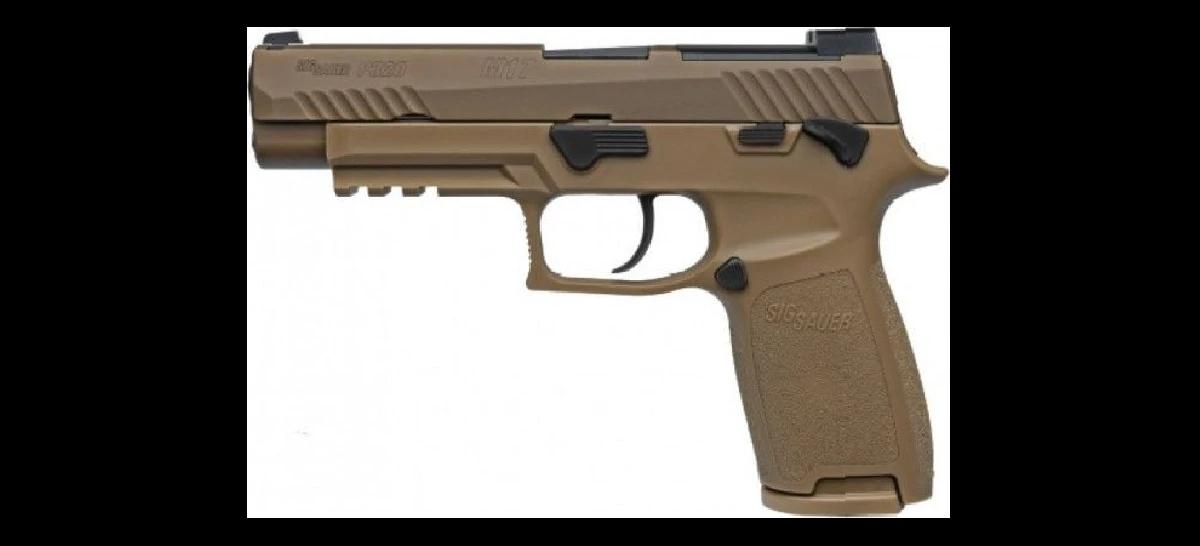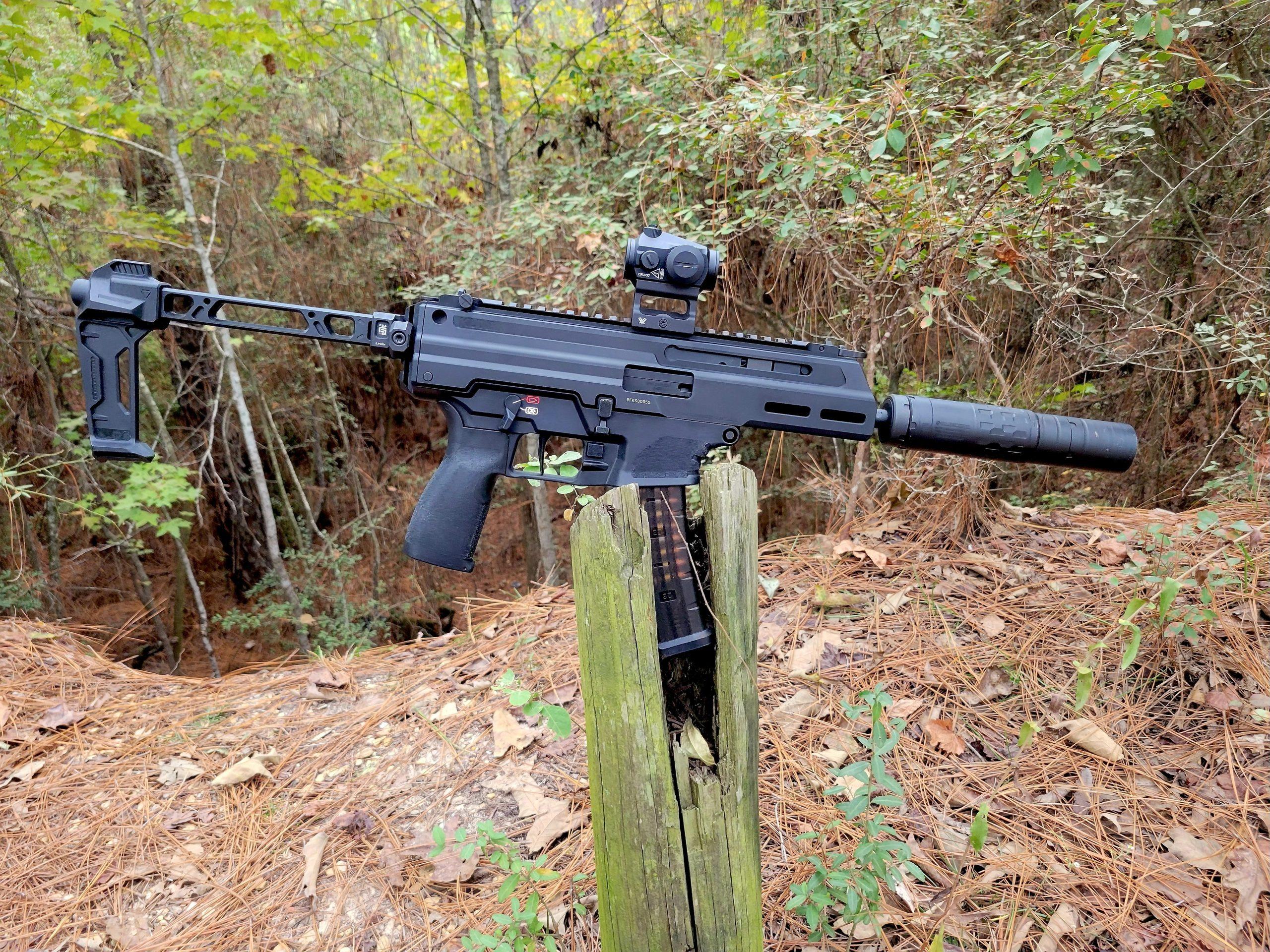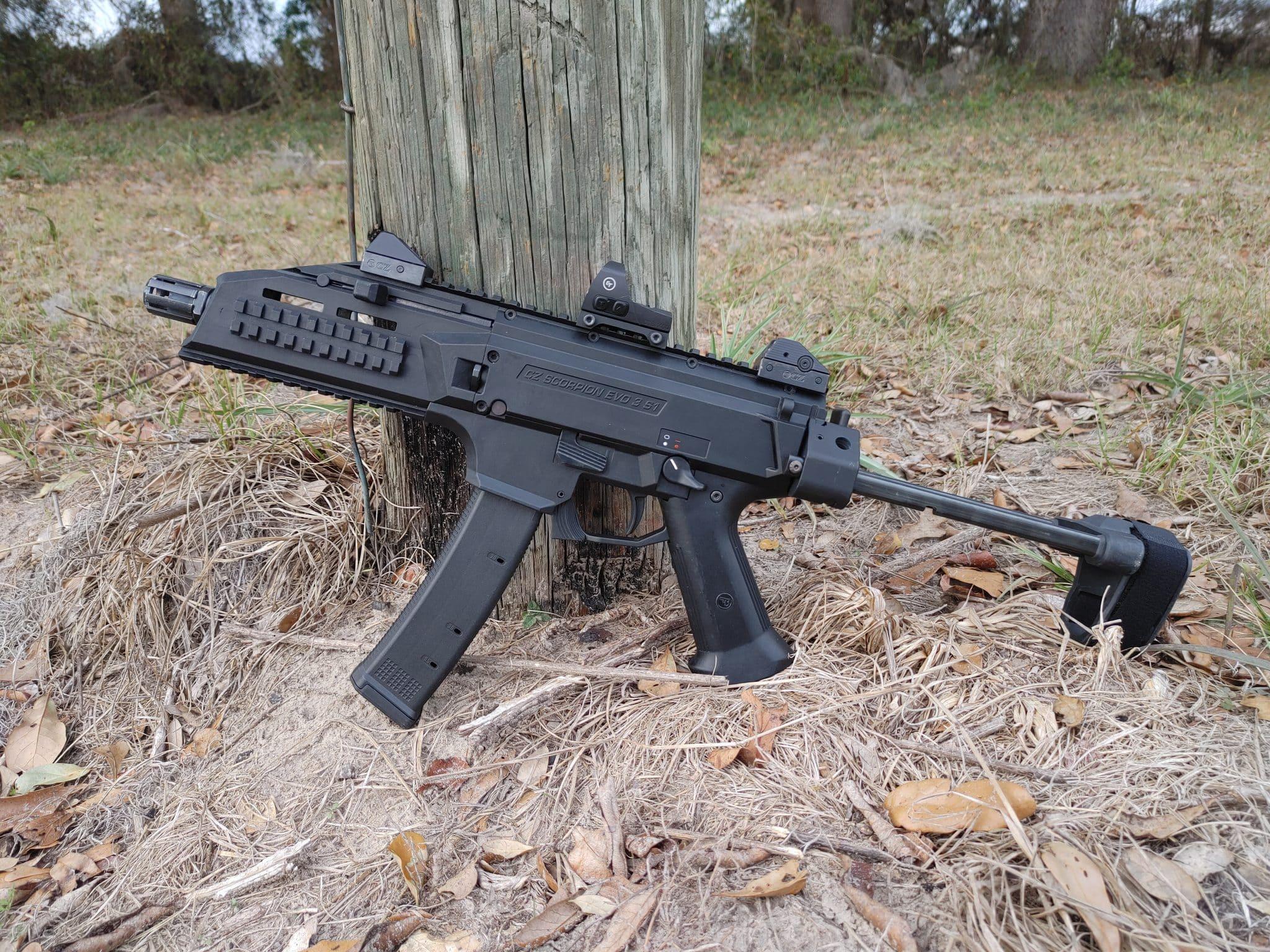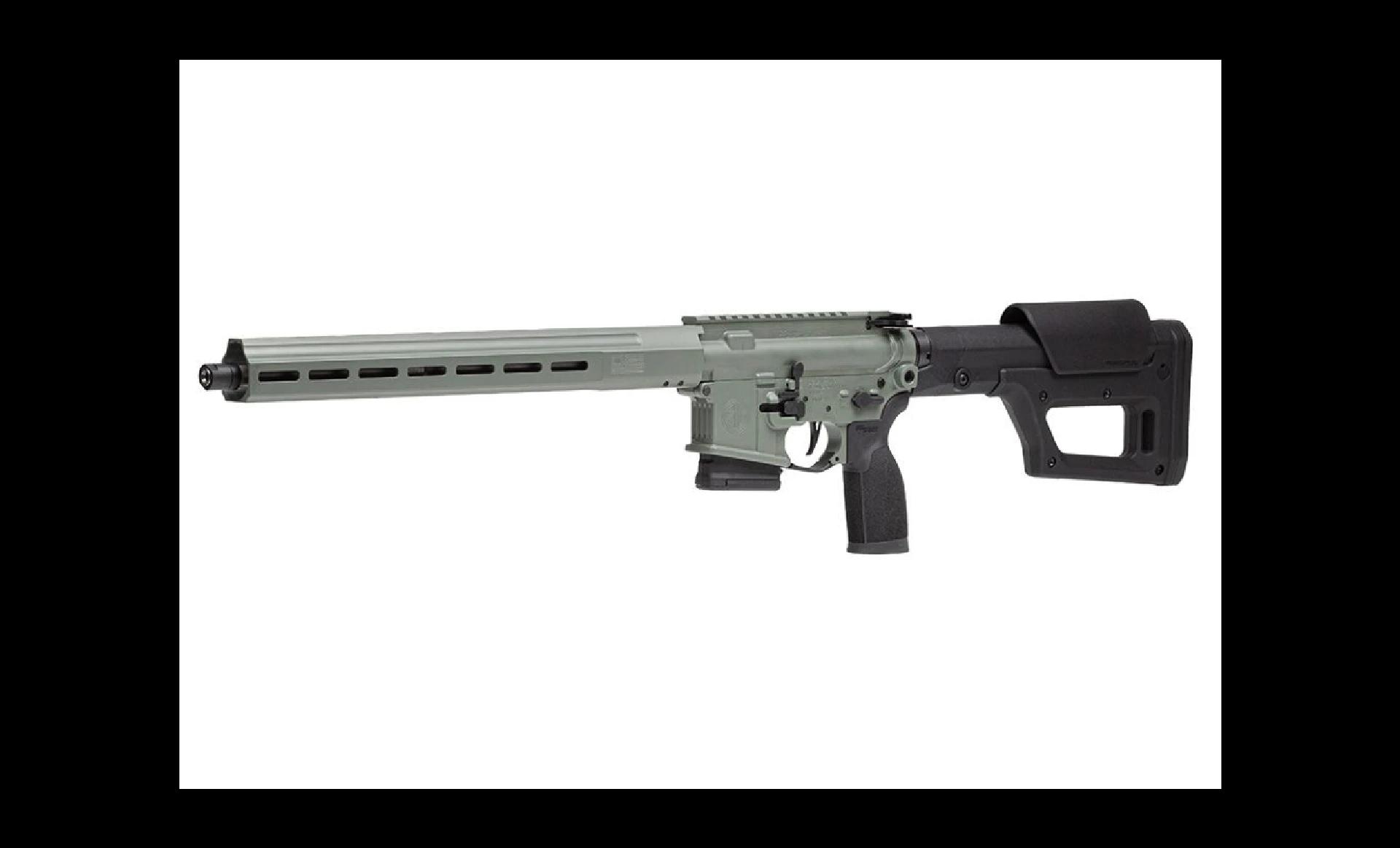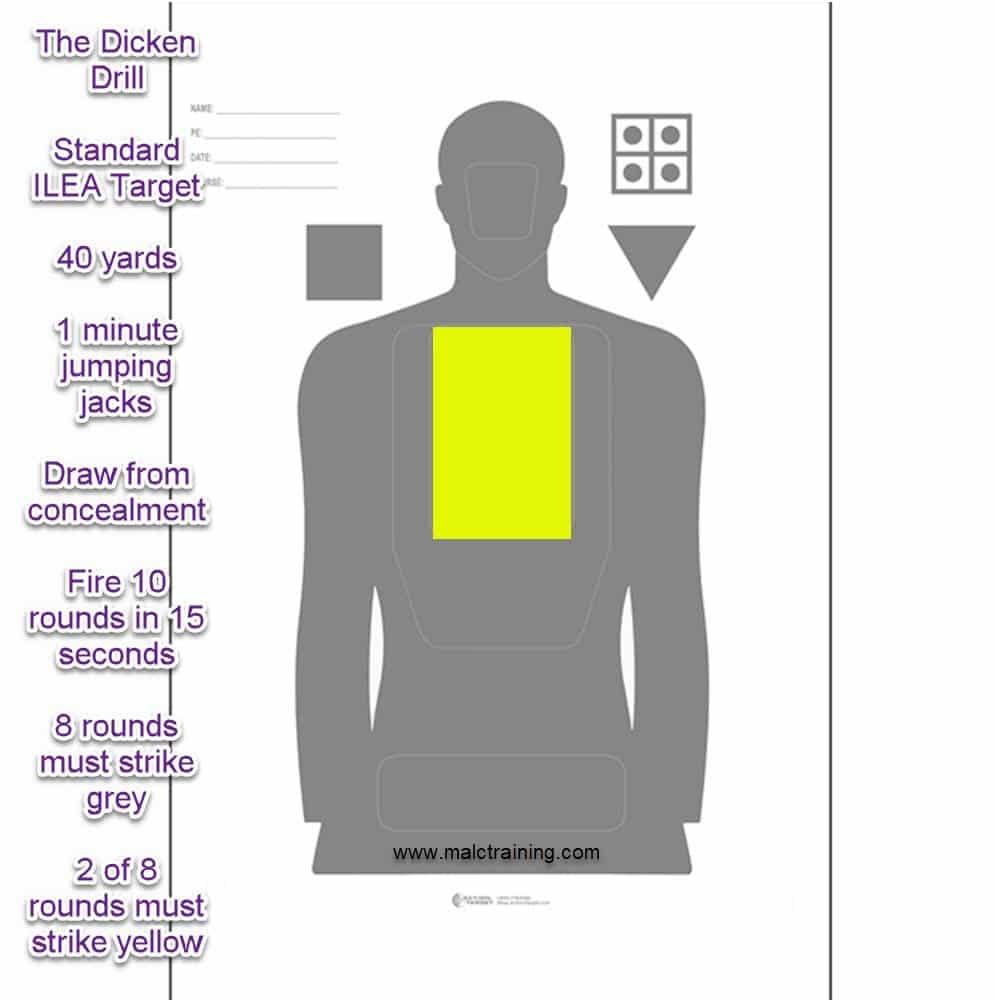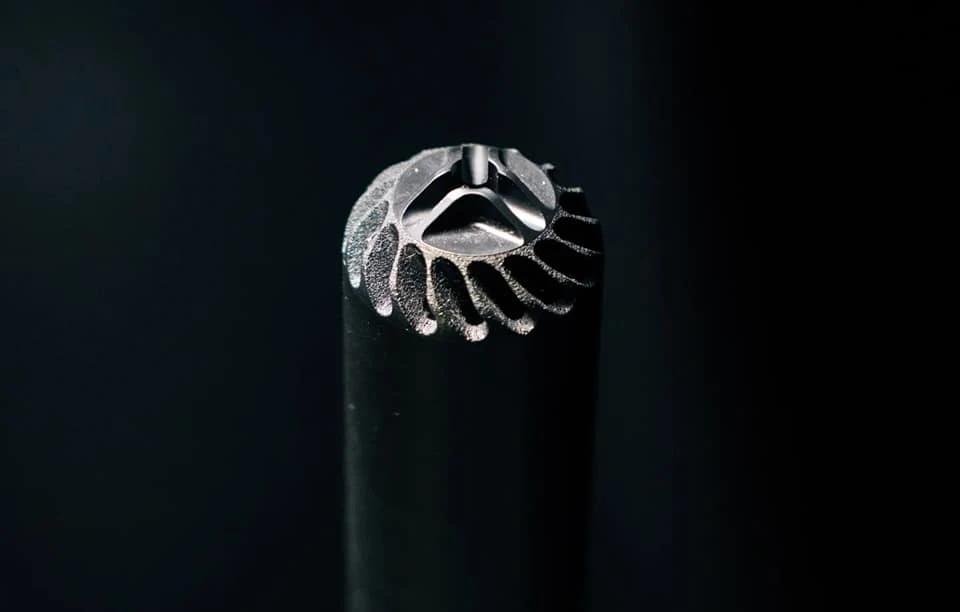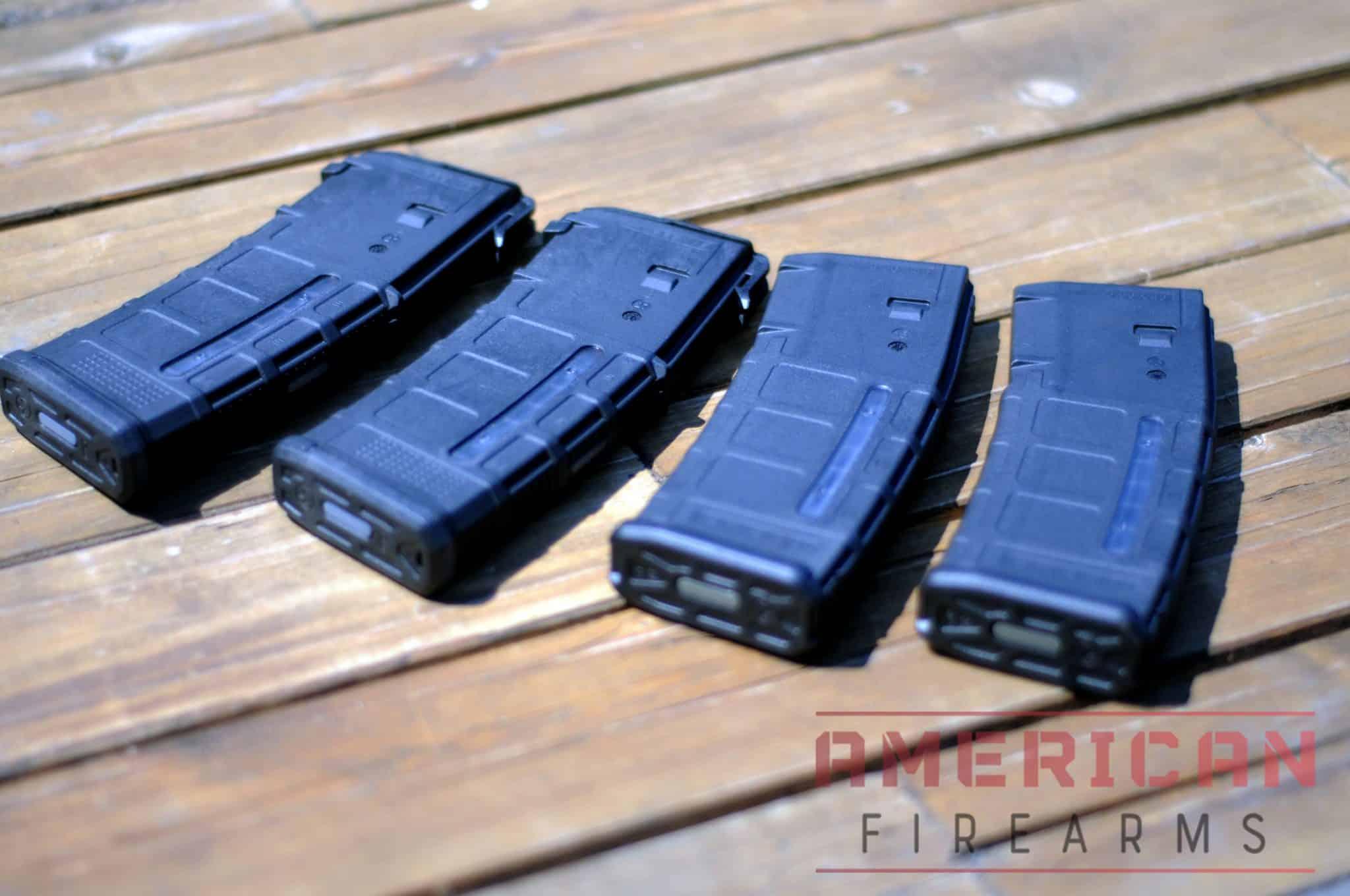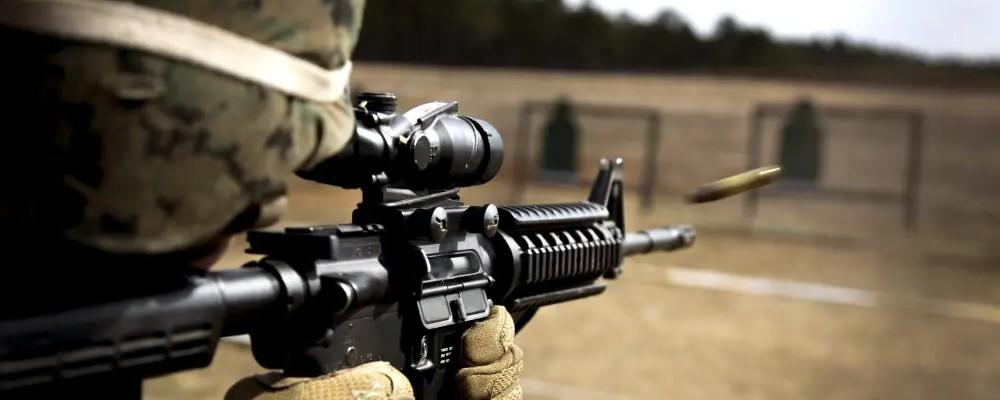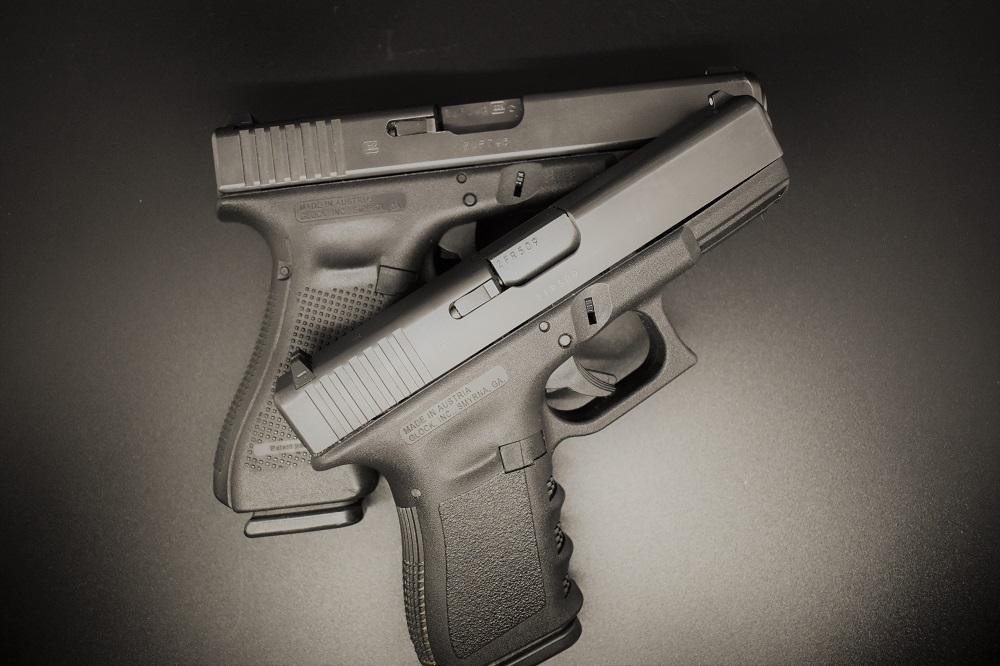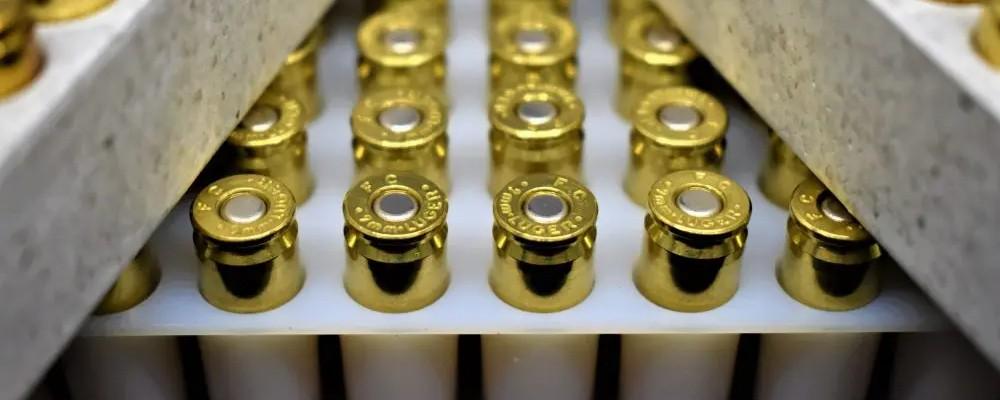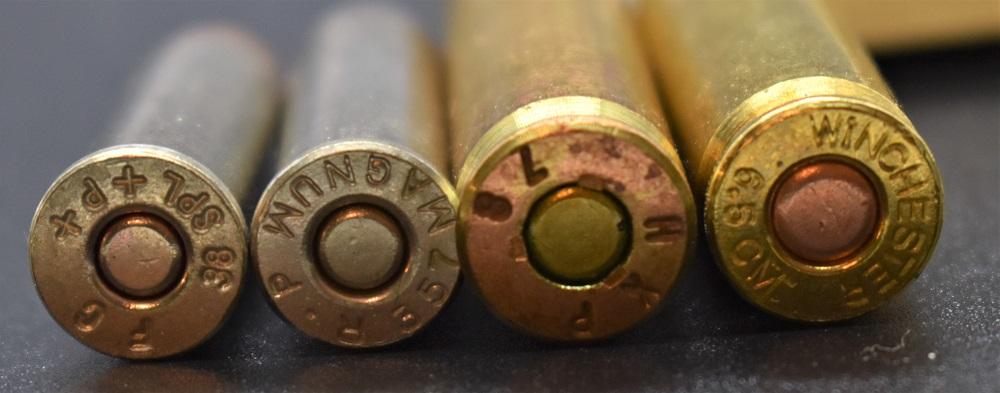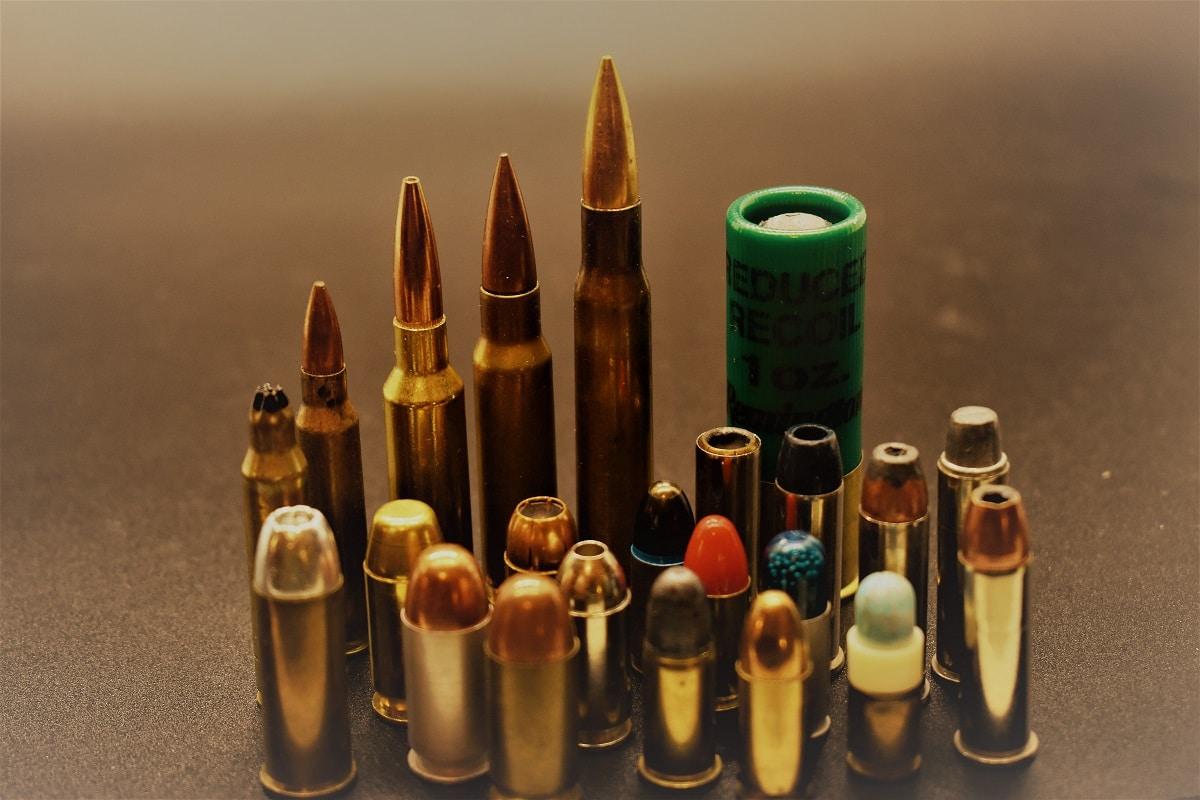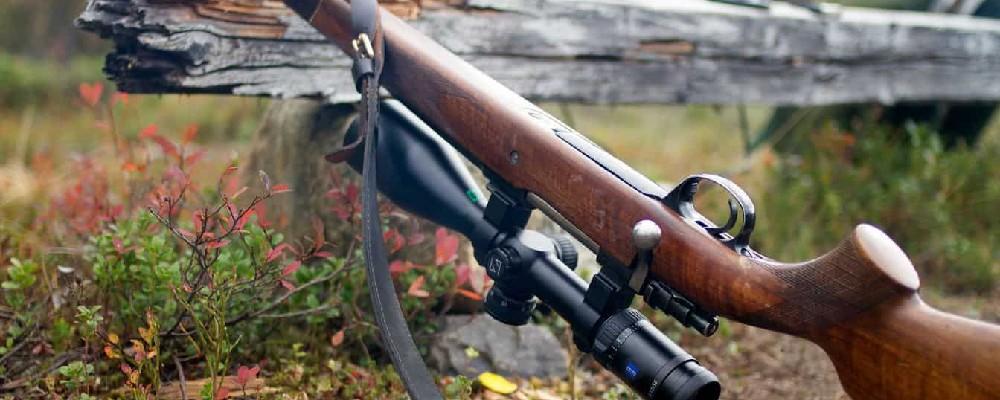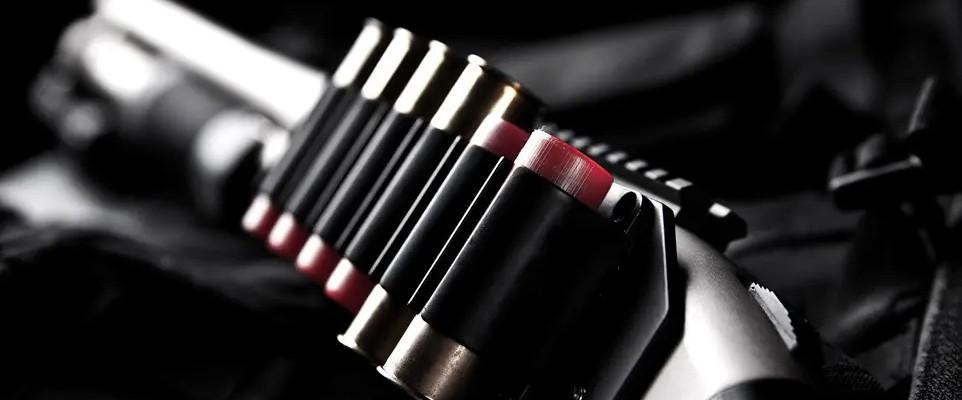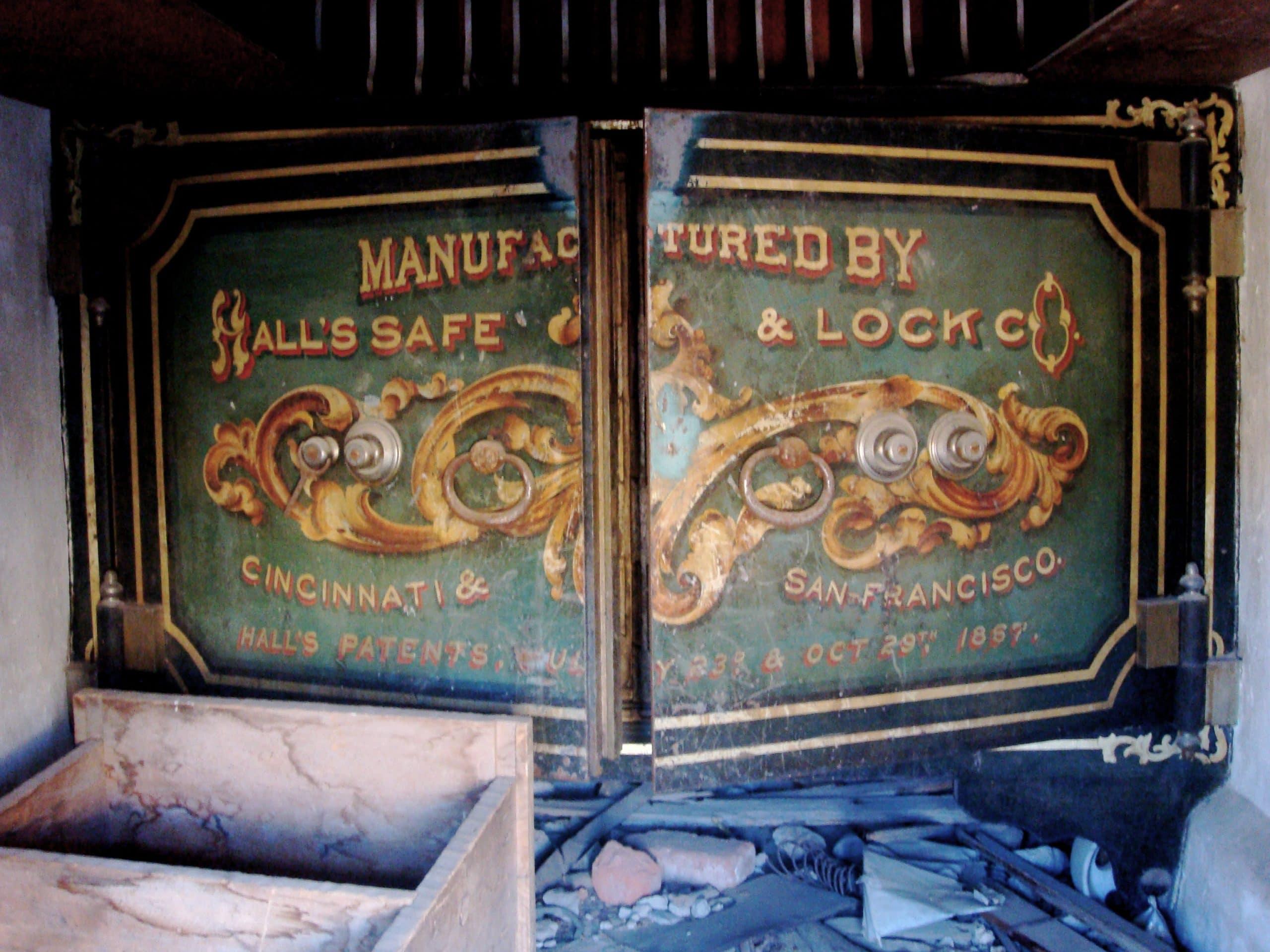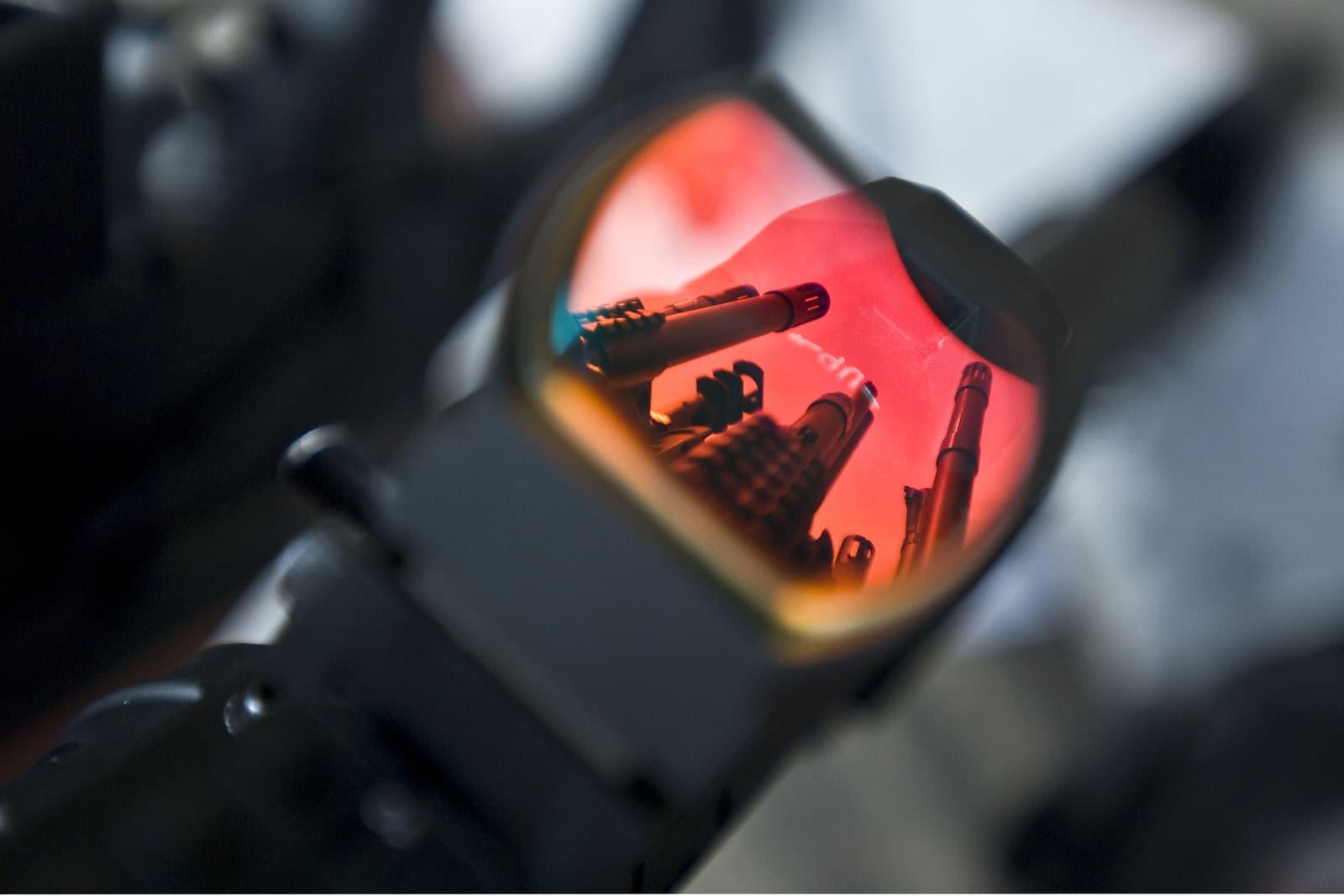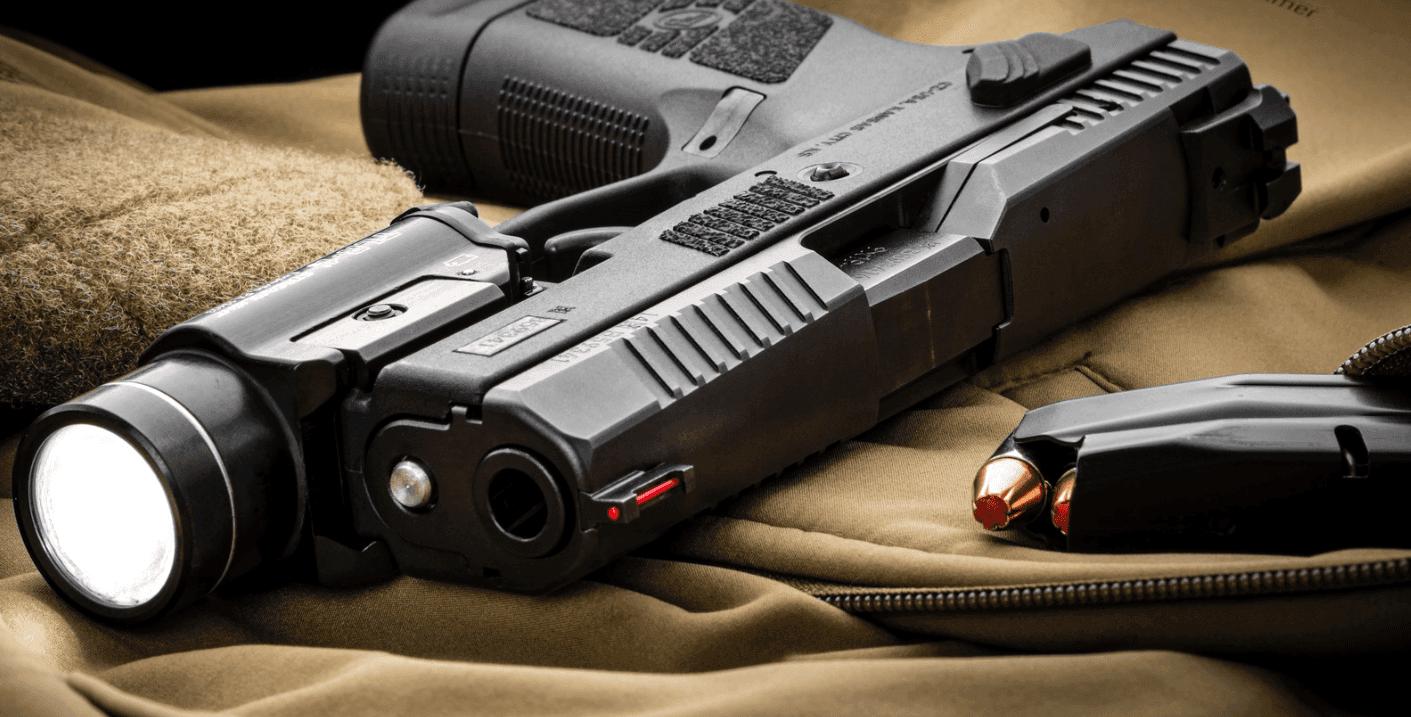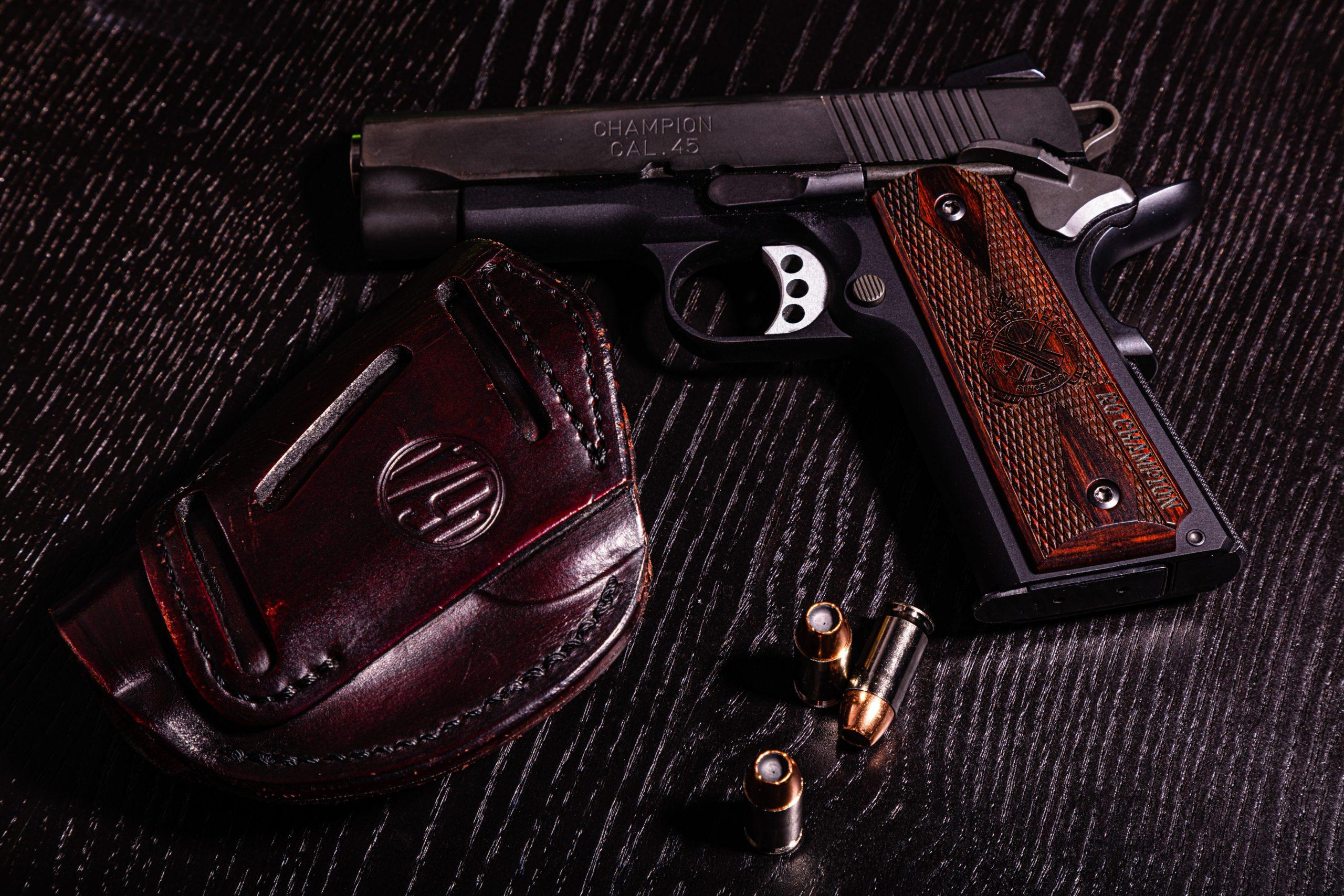Best 9mm Pistol for Every Use: CCW, Home Defense & Range
Written By
Kenzie Fitzpatrick
Competitive Shooter
Edited By
Michael Crites
Licensed Concealed Carry Holder
Share:
Products are selected by our editors. We may earn a commission on purchases from a link. How we select gear.
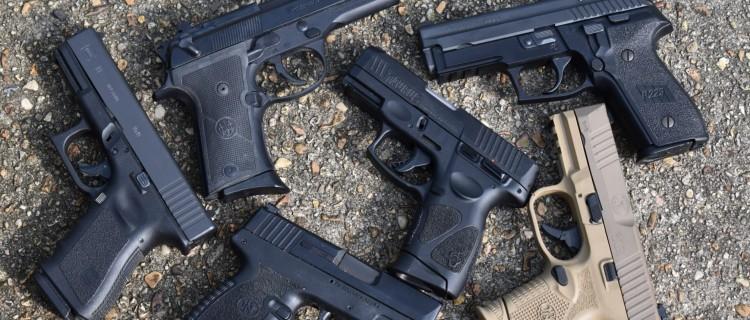
Updated
Oct 2025
The 9mm pistol is the staple handgun for many Americans. These weapons are versatile, affordable, and easy to learn to use, but sifting through the mountain of 9mm pistol models, sizes, configurations, actions, brands, etc. has led more than one aspiring handgun owner to abandon their search altogether.
No need to stress. Below, you’ll find a quick overview of what you should look for when you need a new 9mm pistol (or if you’re buying your first one). Plus, we’ve collected the top 9mm pistols currently on the market. Let’s dive in!
In This Article
Introduction & Overview
The 9mm pistol has become America’s definitive handgun choice, outselling all other calibers combined and earning adoption by military, law enforcement, and civilian users worldwide. This dominance stems from an optimal balance of manageable recoil, proven stopping power, ammunition availability, and platform versatility that serves everyone from first-time buyers to seasoned professionals.
The ‘best gun’ or ‘best handgun’ for you depends on your intended purpose—whether it’s concealed carry, home defense, competition, or another use case, as different models excel in different categories.
With hundreds of 9mm models flooding the market, choosing the right pistol can feel overwhelming, especially for new buyers looking for their first handgun where reliability and ease of use are crucial. This comprehensive guide cuts through the noise by providing tested recommendations, technical insights, and practical guidance tailored to your specific needs—whether you’re seeking home defense, concealed carry, competition shooting, or recreational use.
How to Use This Guide: Start with the fundamentals and decision matrix sections to understand your requirements, then jump to our tested recommendations. Each pistol receives real-world evaluation across accuracy, reliability, ergonomics, and value metrics. Supporting sections cover ammunition selection, accessories, training, and legal considerations to ensure your success beyond the initial purchase.
Our methodology combines extensive range testing, expert analysis, and user feedback to deliver recommendations you can trust with your safety and satisfaction.
9mm Fundamentals
Ballistics & Performance
The 9mm Parabellum (9×19mm) delivers an optimal balance of power and controllability that has made it the world’s most popular handgun cartridge. Standard 115-grain loads generate approximately 1,200 fps muzzle velocity and 350 foot-pounds of energy, while heavier 147-grain subsonic loads offer reduced noise and recoil at 950 fps.
| Caliber | Typical Velocity (fps) | Energy (ft-lbs) | Recoil Impulse | Magazine Capacity |
|---|---|---|---|---|
.380 ACP | 950 | 200 | Low | 6-7 rounds |
9mm | 1200 | 350 | Moderate | 15-17 rounds |
.40 S&W | 1000 | 400 | High | 12-15 rounds |
.45 ACP | 850 | 400 | High | 7-10 rounds |
Modern defensive ammunition has transformed 9mm effectiveness. Premium hollow-point loads like Federal HST and Speer Gold Dot achieve 12-18 inches of penetration with consistent expansion, meeting FBI standards while minimizing over-penetration risks in home defense scenarios.
Hollow points are preferred for self-defense because of their stopping power and reduced risk of over-penetration, making them highly effective for personal safety.
Legal Considerations
Federal Regulations:
- No federal restrictions on 9mm ammunition or standard-capacity magazines
- National Firearms Act (NFA) applies to suppressors and short-barreled pistols
- Background checks required for all dealer purchases
State-Specific Variations:
- Magazine Capacity Limits: California, New York, and several states restrict magazines to 10 rounds
- Ammunition Restrictions: Some states require background checks for ammunition purchases
- Assault Weapon Classifications: Certain features (threaded barrels, detachable magazines) may be restricted
Concealed Carry Implications:
- Reciprocity varies significantly between states
- Training requirements range from none to 16+ hours
- “Shall issue” vs. “may issue” policies affect permit accessibility
Ammunition Availability: 9mm enjoys the best availability of any handgun caliber, with production exceeding 2 billion rounds annually in the U.S. This widespread manufacturing ensures consistent supply and competitive pricing, even during shortage periods.

Understanding 9mm Pistol Types
Action Types Explained
Striker-Fired Systems Striker-fired pistols use a spring-loaded firing pin that’s partially cocked when the slide cycles and fully released by trigger pull. This design offers consistent trigger pull weight and eliminates external hammers for snag-free carry. Some striker-fired pistols use a polymer or plastic trigger, which can affect the feel and performance for some shooters.
Advantages:
- Consistent trigger pull every shot
- Fewer external controls to snag
- Generally more reliable in adverse conditions
- Lower manufacturing costs
Popular Examples: Glock 17/19, Smith & Wesson M&P, Sig P320
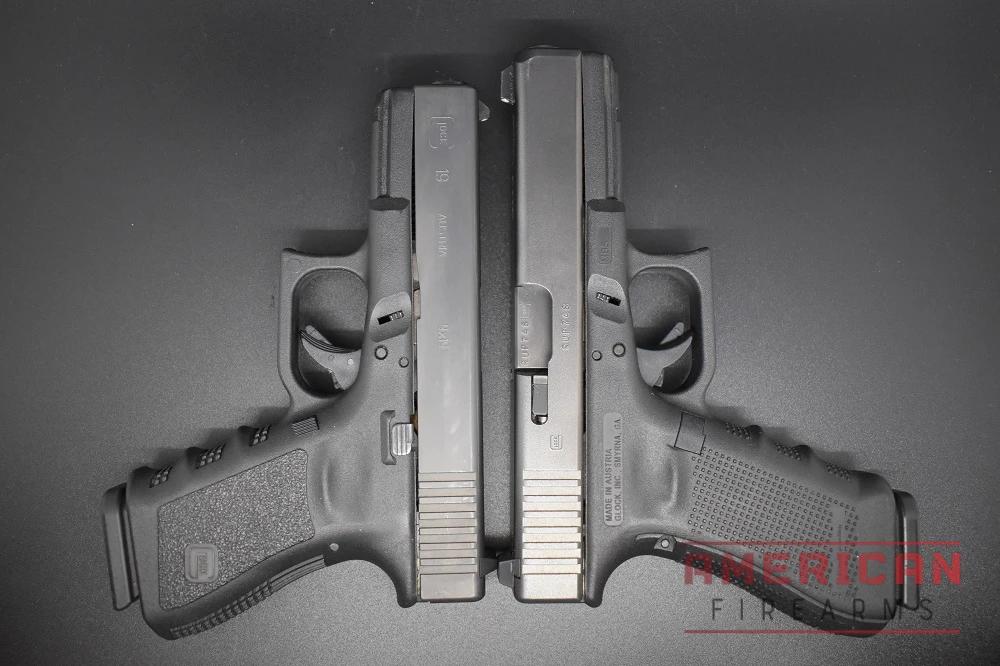
Hammer-Fired Systems Traditional designs using an external or internal hammer to strike the firing pin. Available in single-action (SA), double-action (DA), or combination (DA/SA) configurations.
Single-Action (SA): Hammer must be manually cocked; light, crisp trigger pull Double-Action (DA): Trigger both cocks and releases hammer; heavier first shot DA/SA: Heavy first shot, light subsequent shots
Popular Examples: Beretta 92, Sig P226, CZ-75
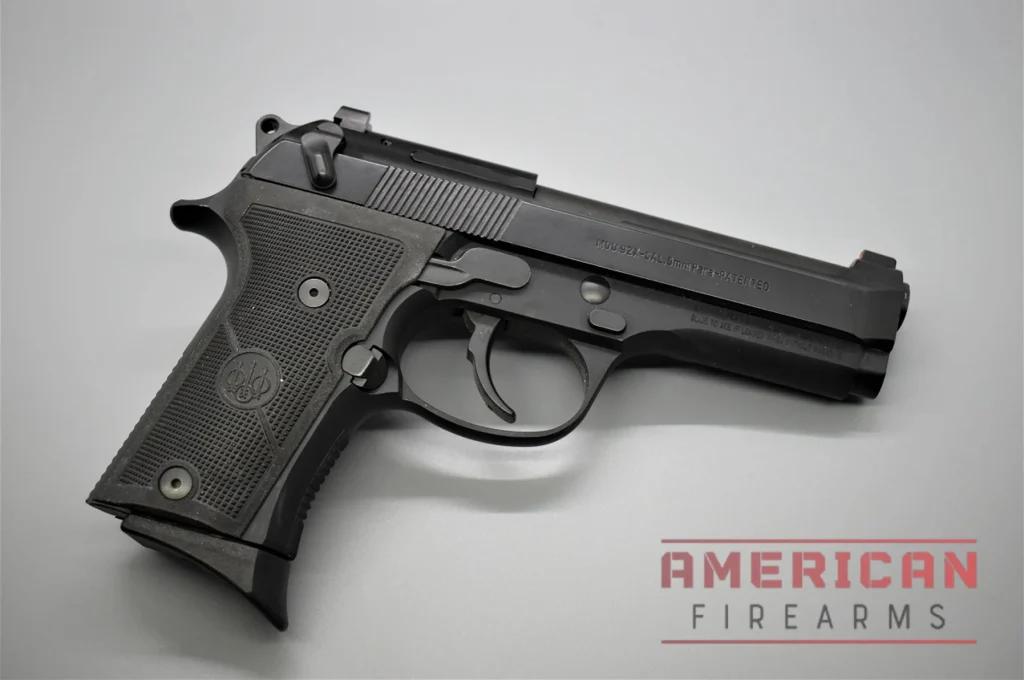
Action Type Comparison Table:
| Feature | Striker-Fired | SA/DA Hammer | SA Only |
|---|---|---|---|
Trigger Consistency | Excellent | Variable | Excellent |
First Shot Speed | Fast | Moderate | Fast |
Carry Safety | Passive | Manual/Auto | Manual |
Maintenance | Simple | Moderate | Simple |
Learning Curve | Easy | Moderate | Easy |
Typical Trigger Weight | 5-6 lbs | 10-12/4-5 lbs | 3-4 lbs |
Size Categories Defined
Full-Size Specifications and Uses
Specification | Typical Range | Example (Glock 17) |
Overall Length | 7.5-8.5 inches | 7.95 inches |
Barrel Length | 4.0-5.0 inches | 4.49 inches |
Height | 5.0-6.0 inches | 5.43 inches |
Weight (Empty) | 24-32 oz | 25.06 oz |
Capacity | 15-20+ rounds | 17+1 rounds |
Where full-size pistols shine:
- A full size handgun is ideal for home defense due to its superior shooting accuracy, better fit, and easier recoil management.
- Open carry and duty use
- Competition shooting
- Range training and practice
Compact Pistol Specifications and Uses
| Specification | Typical Range | Example (Glock 19) |
|---|---|---|
Overall Length | 6.5-7.5 inches | 7.28 inches |
Barrel Length | 3.5-4.2 inches | 4.02 inches |
Height | 4.5-5.5 inches | 5.04 inches |
Weight (Empty) | 20-26 oz | 23.65 oz |
Capacity | 12-17 rounds | 15+1 rounds |
Where compact pistols shine:
- Concealed carry (most versatile size)
- Vehicle storage
- Multi-purpose use (home/carry)
- New shooter friendly
Sub-Compact/Micro Specifications and Uses
| Specification | Typical Range | Example (Sig P365) |
|---|---|---|
Overall Length | 5.5-6.5 inches | 5.8 inches |
Barrel Length | 3.0-3.5 inches | 3.1 inches |
Height | 4.0-4.5 inches | 4.3 inches |
Weight (Empty) | 16-20 oz | 17.8 oz |
Capacity | 6-12 rounds | 10+1 rounds |
Where micro pistols shine:
- Deep concealment
- Pocket carry
- Backup gun role
- Smaller-statured shooters
Frame Materials
Polymer Frames Modern polymer pistols use reinforced nylon or similar materials with steel inserts at stress points.
Many models feature aggressive texturing on the grip, which can be further customized—sanded, filed, or polished—for improved handling and comfort.
Advantages:
- Lightweight (typically 30-40% lighter than steel)
- Corrosion resistant
- Lower manufacturing costs
- Good grip texture options, including aggressive texturing for enhanced control
- Impact resistant
Considerations:
- May feel less premium
- Limited customization options
- Temperature sensitivity in extreme conditions
Popular Examples: Glock series, Smith & Wesson M&P, Springfield XD
Metal Frames (Steel/Aluminum) Traditional construction using steel or aluminum alloy frames.
Advantages:
- Premium feel and balance
- Excellent durability
- Superior heat dissipation
- More customization options
- Better recoil control due to weight
Considerations:
- Heavier carry weight
- Potential corrosion issues
- Higher manufacturing costs
- May require more maintenance
Popular Examples: Beretta 92, Sig P226, 1911 platforms
Let’s compare these materials:
| Characteristic | Polymer | Steel | Aluminum |
|---|---|---|---|
Weight | Light (16-24 oz) | Heavy (28-35 oz) | Medium (22-28 oz) |
Durability | Excellent | Superior | Very Good |
Corrosion Resistance | Excellent | Requires Care | Good |
Cost | Lower | Higher | Medium |
Customization | Limited | Extensive | Good |
Recoil Management | Moderate | Excellent | Good |
Temperature Tolerance | Good | Excellent | Excellent |
Buyers Guide
Few handgun categories have the diversity and sheer number of options as the 9mm pistol. Focus on the following factors and you’ll be able to narrow down your search to a great 9mm handgun that works for you.
Use Case
Home Defense Requirements
Most important features: Reliability, capacity, ease of use under stress, accessory mounting options
Recommended Specifications:
- Size: Full-size or compact
- Capacity: 15+ rounds preferred
- Features: Rail for weapon light, night sights, reliable feeding
- Action Type: Striker-fired for consistency
- Budget Range: $400-800
You should prioritize:
- Reliability (must function when needed)
- Capacity (more rounds = better)
- Accuracy (precision under pressure)
- Light mounting capability
- Ease of operation for family members
Concealed Carry Considerations
Most important features: Concealability, comfort, adequate capacity, quick deployment
Size Recommendations by Carry Method:
| Carry Position | Recommended Size | Typical Examples | |
|---|---|---|---|
Appendix (AIWB) | Compact/Sub-compact | Glock 19 & Sig P365XL | |
Hip (3-4 o'clock) | Compact/Full-size | Glock 19 & M&P 2.0 | |
Small of Back | Sub-compact only | Glock 43 & Shield Plus | |
Ankle | Micro only | Glock 42 | LCP MAX |
Pocket | Micro only | Sig P365 | Ruger LCP |
Comfort vs. Capacity Trade-offs:
- Maximum Concealment: 6-10 rounds, 16-20 oz weight
- Balanced Approach: 10-15 rounds, 20-25 oz weight
- Capacity Priority: 15+ rounds, 25+ oz weight
Competition Shooting Needs
Most important features: Accuracy, trigger quality, capacity, customization potential
Division-Specific Requirements:
| Competition Division | Size Limit | Capacity Limit | Key Features |
|---|---|---|---|
Production | Any | 10 rounds | Stock trigger & basic sights |
Carry Optics | Any | 10 rounds | Red dot optics allowed |
Limited | Any | 10 rounds | Minor modifications allowed |
Open | Any | Unlimited | Full customization permitted |
IDPA SSP | Any | 10 rounds | Minimal modifications |
You should prioritize:
- Crisp, consistent trigger (3-5 lb pull)
- Adjustable or high-visibility sights
- Optics-ready slide (Carry Optics/Open)
- Extended magazine release
- Ambidextrous controls
Range/Recreational Shooting
Most important features: Comfort, accuracy, affordability, upgrade potential
Ideal Characteristics:
- Full-size for maximum comfort and accuracy
- Good ergonomics for extended shooting sessions
- Strong aftermarket support for customization
- Reasonable ammunition costs
- Easy maintenance and cleaning
Physical Considerations
Hand Size and Grip Compatibility
Measurement Guide:
- Hand Length: Measure from wrist crease to middle fingertip
- Hand Width: Measure across palm at widest point
- Trigger Reach: Distance from backstrap to trigger face
Size Guidance:
| Hand Measurement | Small (<7" length) | Medium (7-8" length) | Large (8"+ length) |
|---|---|---|---|
Grip Width | 1.0-1.2" preferred | 1.2-1.4" optimal | 1.3-1.5" comfortable |
Recommended Models | P365 | Shield Plus | Glock 19 or M&P 2.0 |
Trigger Reach | 2.5-2.7" | 2.7-2.9" | 2.8-3.1" |
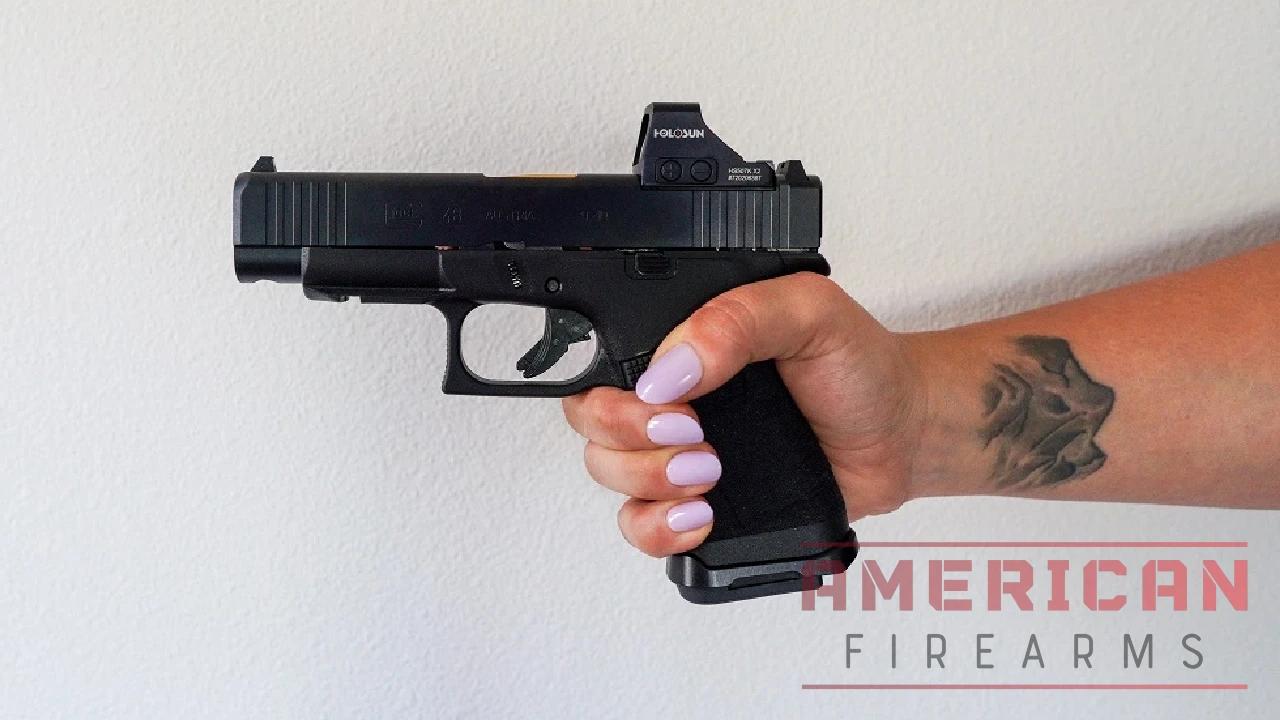
Grip Adjustment Options:
- Interchangeable Backstraps: Sig P320, M&P series
- Adjustable Palm Swells: FN 509 series
- Modular Grip Frames: Sig P320, Wilson Combat modules
- Grip Tape/Stippling: Universal aftermarket solutions
Grip adjustment options like interchangeable backstraps and modular frames help ensure that many shooters can find a comfortable and secure fit, regardless of hand size.
Strength and Recoil Management
Slide Manipulation Requirements:
| User Strength Level | Recommended Action | Slide Spring Weight |
|---|---|---|
Reduced Strength | DA/SA hammer-fired | 12-15 lbs |
Average Strength | Standard striker-fired | 15-18 lbs |
Above Average | Competition-tuned | 18-22 lbs |
Recoil-Friendly Features:
- Heavier frame weight (helps absorb recoil and reduces felt recoil)
- Longer barrel length (also helps absorb recoil and reduces muzzle flip)
- Low bore axis design (Glock, M&P)
- Recoil spring tuning options
- Compensated models available
Vision and Sight Picture Preferences
Sight Options by Vision Needs:
| Vision Condition | Recommended Sights | Why |
|---|---|---|
Normal Vision | Standard 3-dot | Proven & simple design |
Presbyopia | Large dot w/ contrast sights | Easier target acquisition |
Low Light Concern | Tritium night sights | Glow-in-dark visibility |
Astigmatism | Fiber optic sights | Clearer sight picture |
Red Dot Compatible | Suppressor-height co-witness | Backup to optics |
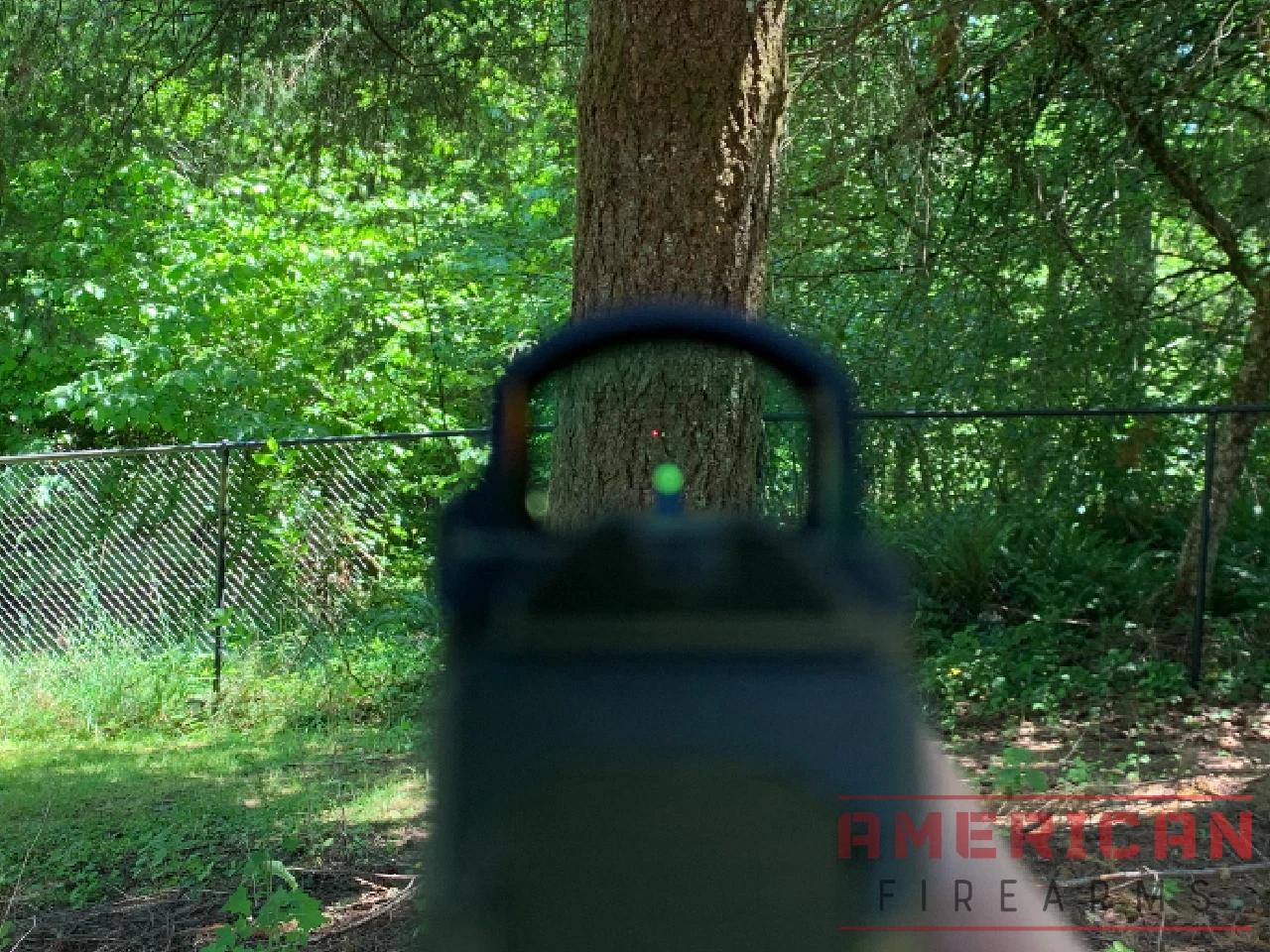
Experience Level Matters
Beginner-Friendly Features Checklist:
✓ Simple Operation
- Striker-fired action (consistent trigger pull)
- Minimal external controls
- No manual safety to forget
- Easy field stripping process
Many pistols in this category are designed to be easy to use for both new and experienced shooters, making them accessible regardless of skill level.
✓ Safety Features
- Drop safety mechanisms
- Trigger safety blade
- Firing pin block
- Loaded chamber indicator
✓ Learning Support
- Strong aftermarket training support
- Widely available instruction
- Common platform familiarity
- Extensive online resources
Certain models are practical choices for most shooters due to their versatility and user-friendly features.
Beginner Recommendations Ranked:
- Glock 19 – Simple, reliable, extensive support
- Smith & Wesson M&P 2.0 – Great ergonomics, American-made
- Sig P320 – Modular system grows with user
- Ruger Security-9 – Budget-friendly with good features
Advanced User Considerations
Customization Priorities:
- Trigger upgrade potential
- Sight mounting options
- Barrel threading availability
- Frame modification compatibility
- Competition package availability
Performance Features:
- Match-grade barrels
- Adjustable triggers
- Optics-ready platforms
- Modular chassis systems
- Suppressor-ready configurations
Aftermarket support
One of the worst thorns an owner of a new (or at least new to them) handgun can run into is to find out that their new 9mm has very few holsters available to fit them, extra magazines cost $75, and there are no options to replace the kind of creepy trigger or sometimes hard-to-see sights.
Aftermarket accessories such as sights, triggers, and magazine releases can significantly enhance firearm performance and allow for greater personalization, making it easier to optimize your handgun to your preferences.

To skirt problems such as these, either go with an established design that has been in production for several years or double-check to make sure the new model under consideration is supportable.
If possible, quickly search for replacement magazines, triggers, extended mag and holster options to get an idea of life cycle costs before committing to a pistol. Adjustable sights will allow you to compensate for different variables, while and day/night sights which ensure the pistol will remain usable in a variety of lighting conditions.
If these aren’t part of the factory package, knowing you can replace them to optimize your sight picture is a really helpful feature.
Consider whether you’ll need a 9mm pistol with a mounting rail. Some pistols allow you to slot attachments, like lights or laser/light combos to beneath the barrel on an abbreviated Picatinny rail — a perfect home for a pistol light — while others eschew this feature in exchange for affordability.
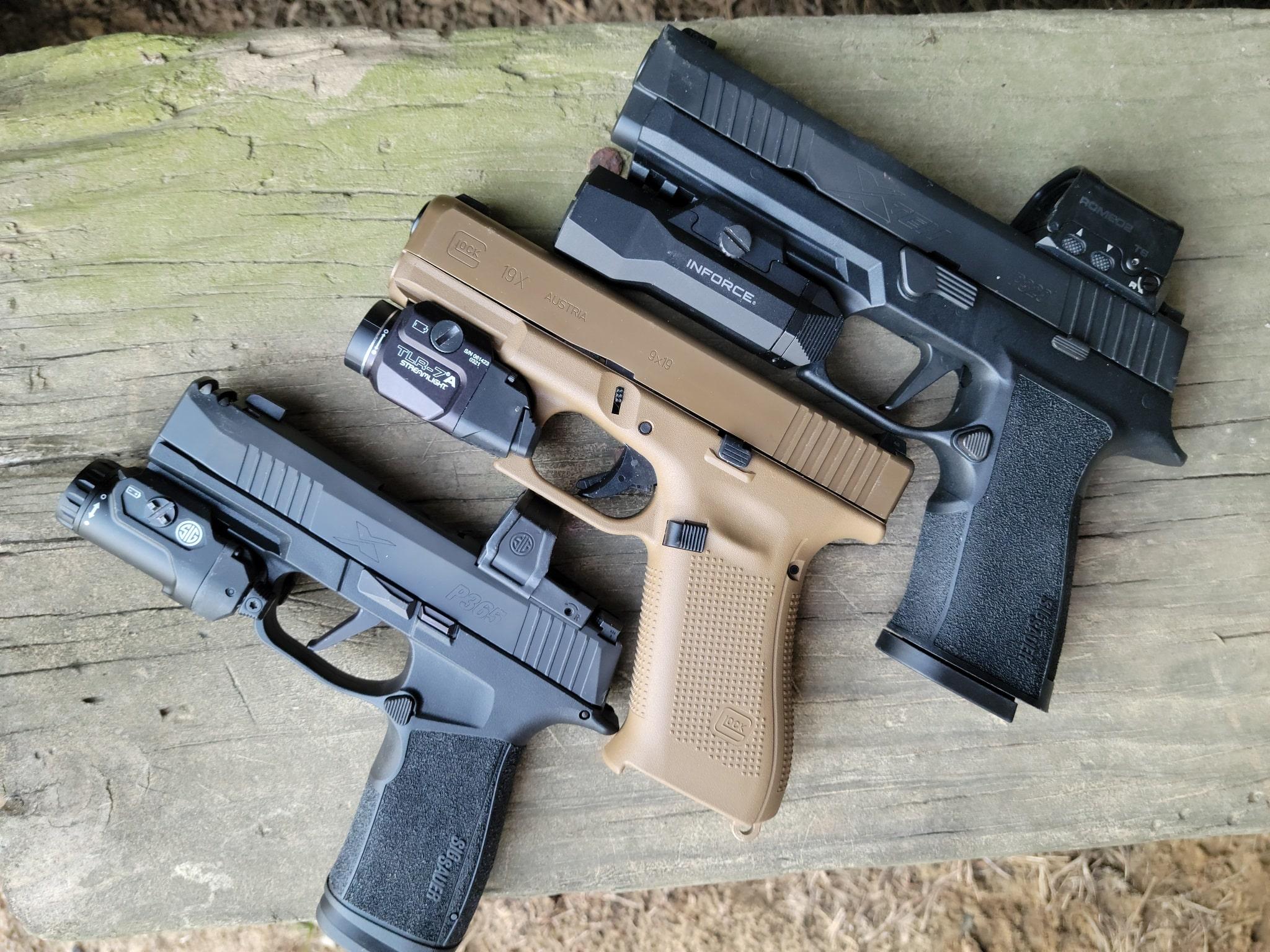
Side By Side Pistol Comparison
| Model | Type/Size | Capacity | Weight (oz) | Barrel Length | MSRP | Best For |
|---|---|---|---|---|---|---|
Glock 17 Gen 5 | Full-Size Striker-Fired | 17+1 | 24.97 | 4.49" | $591 | Best Full Size |
Beretta 92X | Full-Size DA/SA Hammer | 13+1 (Compact) | 27.2 | 4.25" | $747 | Best Full-Size DA/SA |
Canik SFx Rival | Full-Size Competition | 18+1 | 29 | 5" | $631 | Competition Shooting |
Sig P320 M17 | Full-Size Modular | 17+1 | 29.6 | 4.7" | $849 | Modular Pick |
Smith & Wesson M&P Shield 2.0 | Compact Single-Stack | 7+1 8+1 | 18.3 | 3.1" | $460 | Best Compact 9mm |
Glock 19 Gen 5 | Compact Striker-Fired | 15+1 | 23.63 | 4.02" | $650 | All-Purpose CCW |
Ruger RXM | Compact Modular | 15+1 | 23.2 | 4.0" | $399 | Best Glock Clone |
Sig P365XL | Micro-Compact | 12+1 | 17.8 | 3.7" | $1269 | Best Sub-Compact |
Glock 43 | Sub-Compact Single-Stack | 6+1 | 16.3 | 3.41" | $599 | Ankle/Pocket Carry |
Taurus GX4 | Micro-Compact | 10+1 | 18.7 | 3.06" | $400 | Budget Micro CCW |
Best Full Size 9mm Pistols
1. Best Full Size: Glock 17
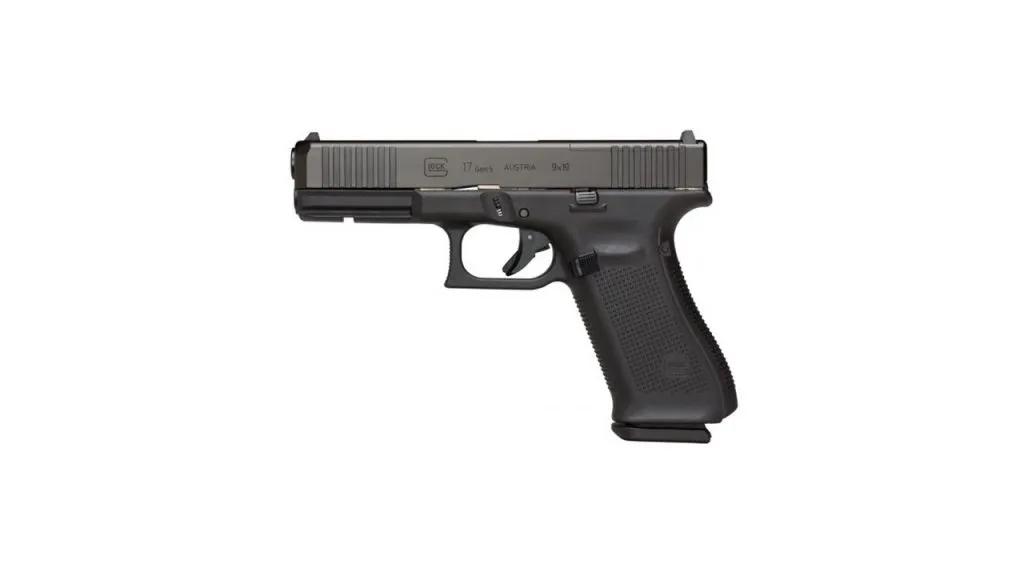
$590.99

51
EXCEPTIONAL
2025 Awards & Rankings
Performance Scores
Specifications:
- Weight: 24.97 oz
- Capacity: 17
- Length: 7.95 in
- Barrel Length: 4.49″
- Width: 1.18 in
The Good:
- Classic style
- Beginner friendly
- Easy to shoot
- Fantastic capacity
The Bad:
- Large
- Looks like every other Glock
- Limited slide serrations
The G17, one of the most legendary striker-fired 9mm Glock pistols, launched the Glock empire when it arrived on the market in the early 1980s. The first successful polymer-framed pistol, it overcame an initial uphill fight because nobody likes change and has encouraged a crop of imitators.
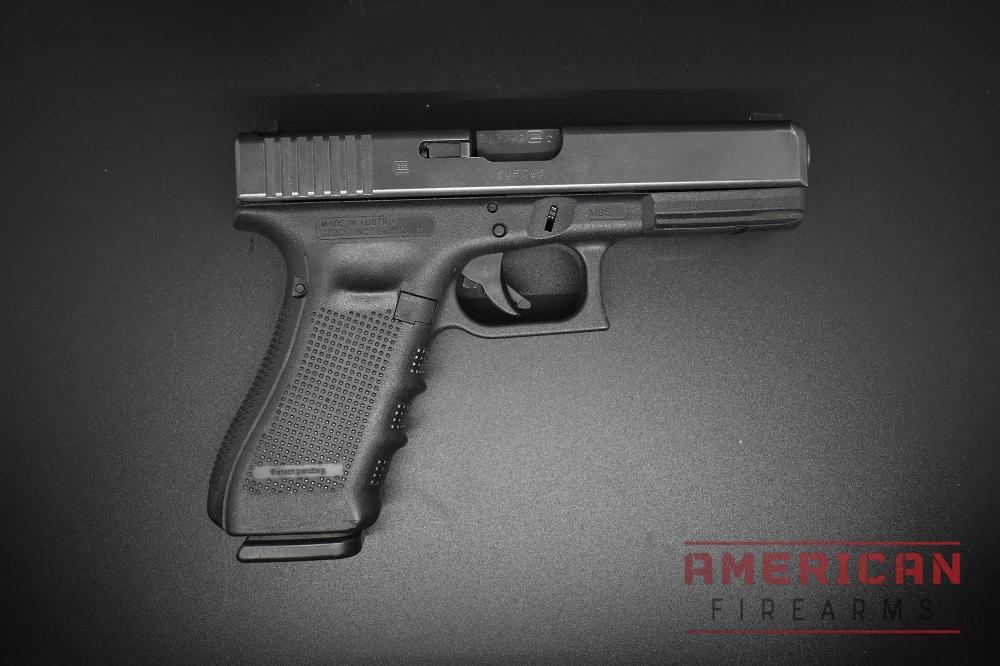
Boasting a 17+1 shot capacity, this full-sized combat handgun has gone on to be the most adopted in Western military service worldwide, with countries ranging from Britain and France to South Korea and Singapore trusting it.
The latest variant, the Gen 5 model, includes upgrades such as the Glock Marksman Barrel, which is extremely accurate and easy to shoot. If you want all the details on the G17 check out our hands-on review.
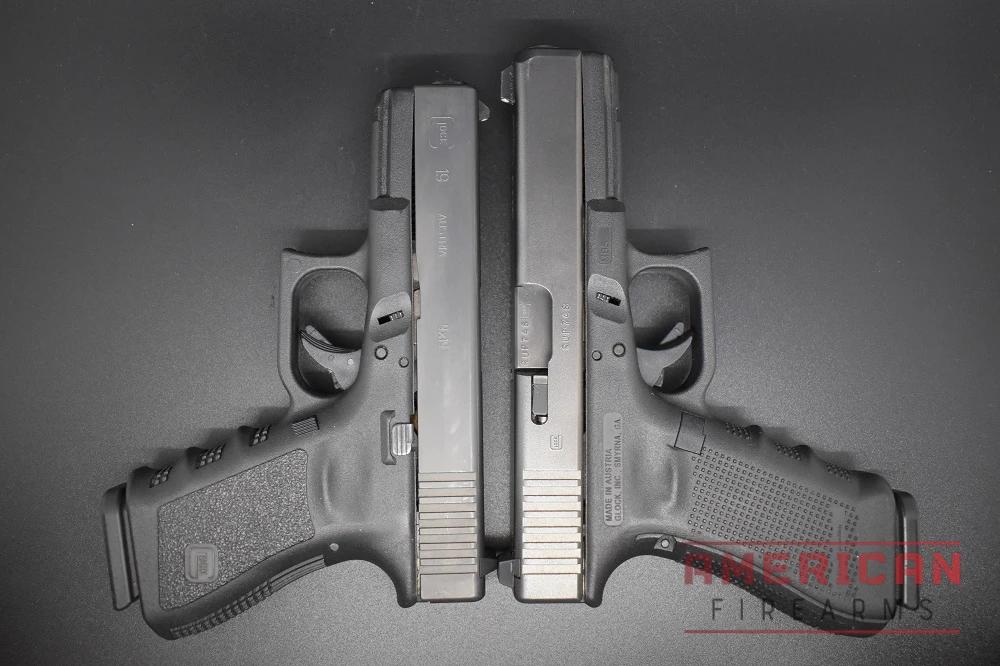
2. Best Full-Size DA/SA: Beretta 92X
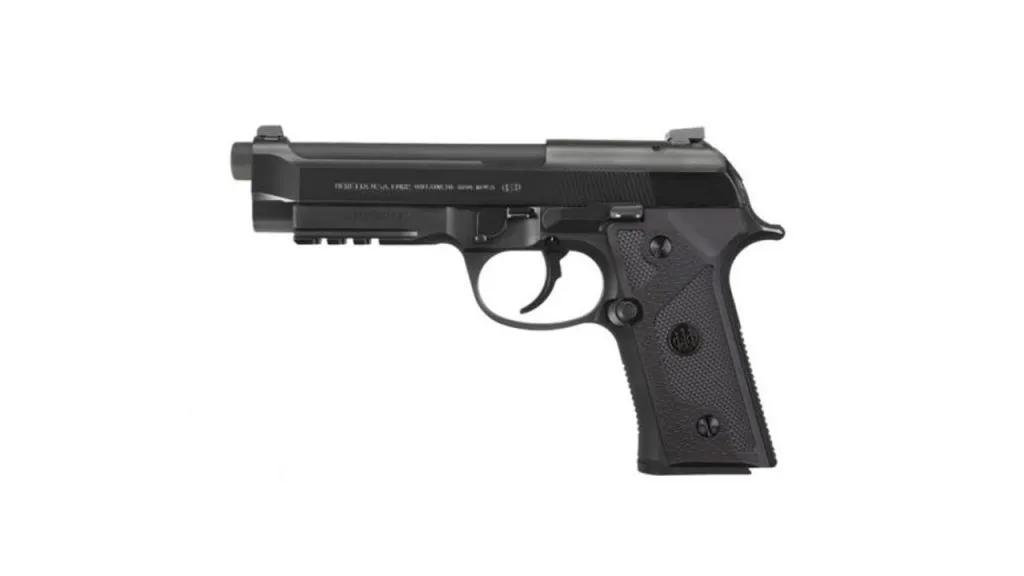
$746.99

40
EXCEPTIONAL
Performance Scores
Specifications:
- Caliber: 9mm
- Barrel Length: 4.25 inches
- Overall Length: 7.75 inches
- Weight: 27.2 ounces, unloaded
- Magazine Capacity: 13+1
The Good:
- Incredibly proven performer
- Many variants to choose from
- Solid magazine capacity
- Tons of used 92s floating around
The Bad:
- Large, heavy pistol
- Tough to determine country of manufacture
- Compact models only have a 13+1 round magazine capacity
- Double-action/single-action hammer-fired layout with a decocker seems dated
The steel-framed Beretta 92, one of the most venerble double-stack 9mm pistols on the market, has been around for almost 50 years.”
There is a reason for that: it just plain works, and as I detailed in our historical look at the Beretta 9mm pistols, the 92 really was a watershed moment in handgun design. I went way deep on the 92 if you’re interested. Beretta introduced the new “X” series of the Model 92 a few years ago and has since upgraded them to an optics-ready standard.

While they’re certainly one of the most recognizable handguns anywhere, they’re not the lightest, easiest to operate, nor do they offer the most firepower, but the 92 is a true classic that delivers on performance and looks.
Adopted by dozens of militaries worldwide, including the Pentagon who has used it for the past four decades, this “Back to Back Gulf War Champ” is a great pistol and still very relevant today in its third generation, the Vertec 92X series. While originally a full-sized pistol with low recoil, the 92 is also produced in shorter Centurion and Compact variants.
History
Introduced in 2019, the 92X line included a full-sized model with a 4.7-inch barrel, a Centurion with a 4.3-inch barrel, and a Compact variant with both a 4.3-inch barrel and a shorter grip frame. This has since morphed into an RDO (Red Dot Optic) 92X standard, which includes an optics-ready slide.
The introductory version of the 92X Compact, as shown in this review, was available with or without a 3-slot Picatinny accessory rail on the dustcover in front of the trigger guard. Mine is the “smooth” variety that does not have the rail. All other variants are rail guns.
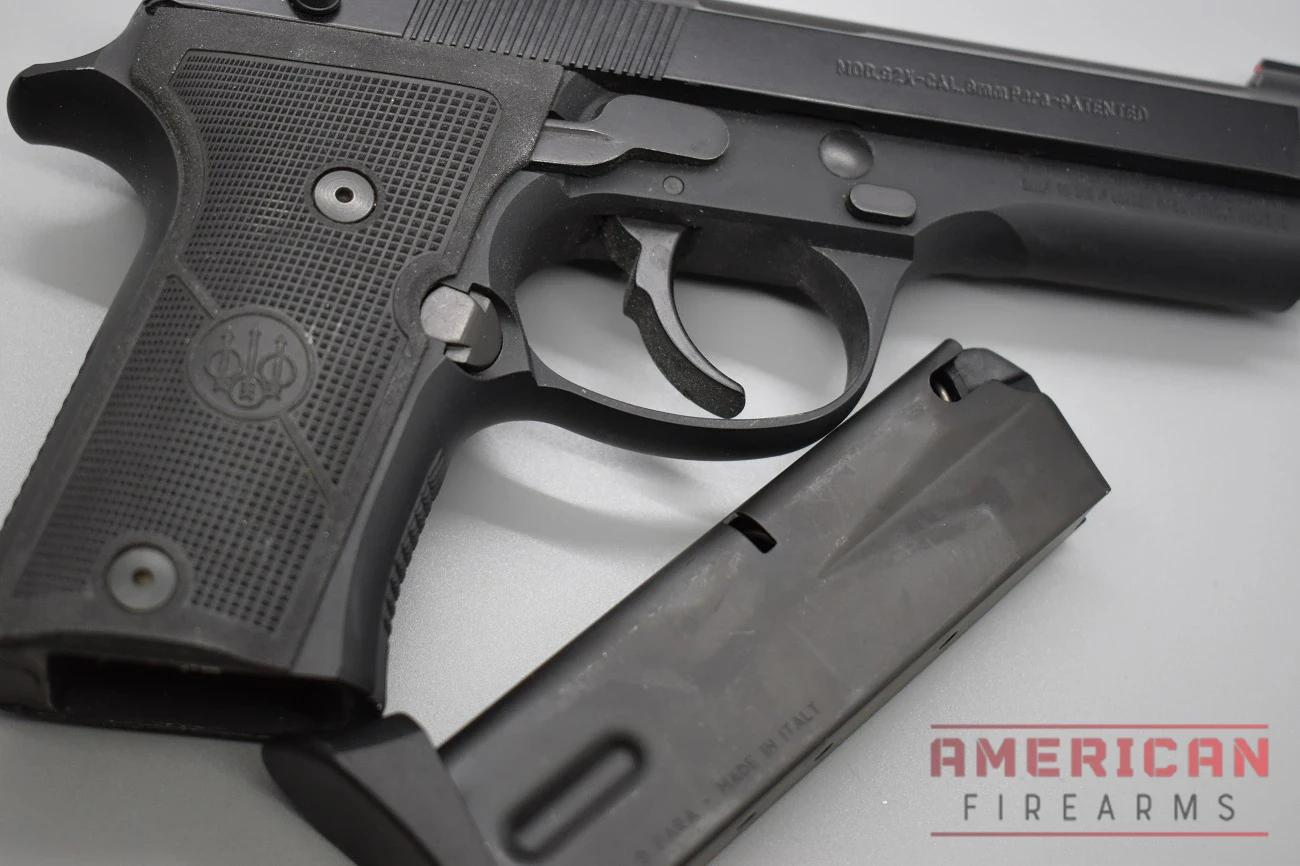
Features
The 92X series, except the more bespoke Performance and 92XI models, all share the same basic features, including a slim Vertec frame, anti-friction coated magazines and internals, a beveled magwell, skeletonized hammer, front and rear slide serrations, and a black Bruniton finish on the slide.
Controls
The standard controls include ambidextrous oversized G-style “competition” style slide-mounted thumb decocker levers instead of the more traditional F-style safety/decocker found on most other Beretta 92 variants. The push-button magazine release, which drops the mags free for me every time, is mounted on the left side of the frame but can be swapped to the right.
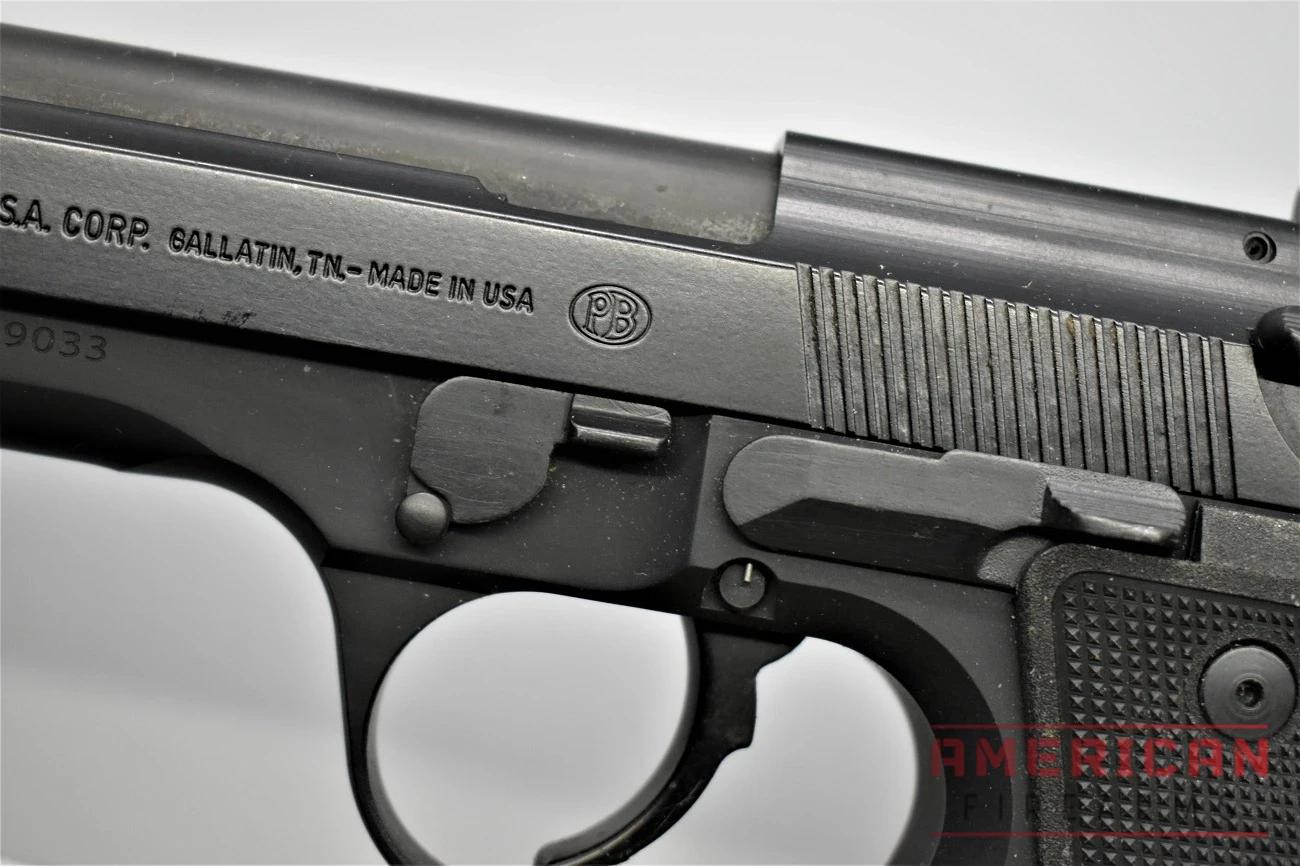
Ergonomics
Between the thin Vertec frame and very aggressively textured thin grips, the 92X series feels svelte in the hand and lends to easy controllability.
Reliability
We ran the 92X through our standard 500-round test and evaluation drill with a mix of range and defensive ammo to include both steel and brass cases. We had zero malfunctions on the range. These Tennessee-built Berettas run.
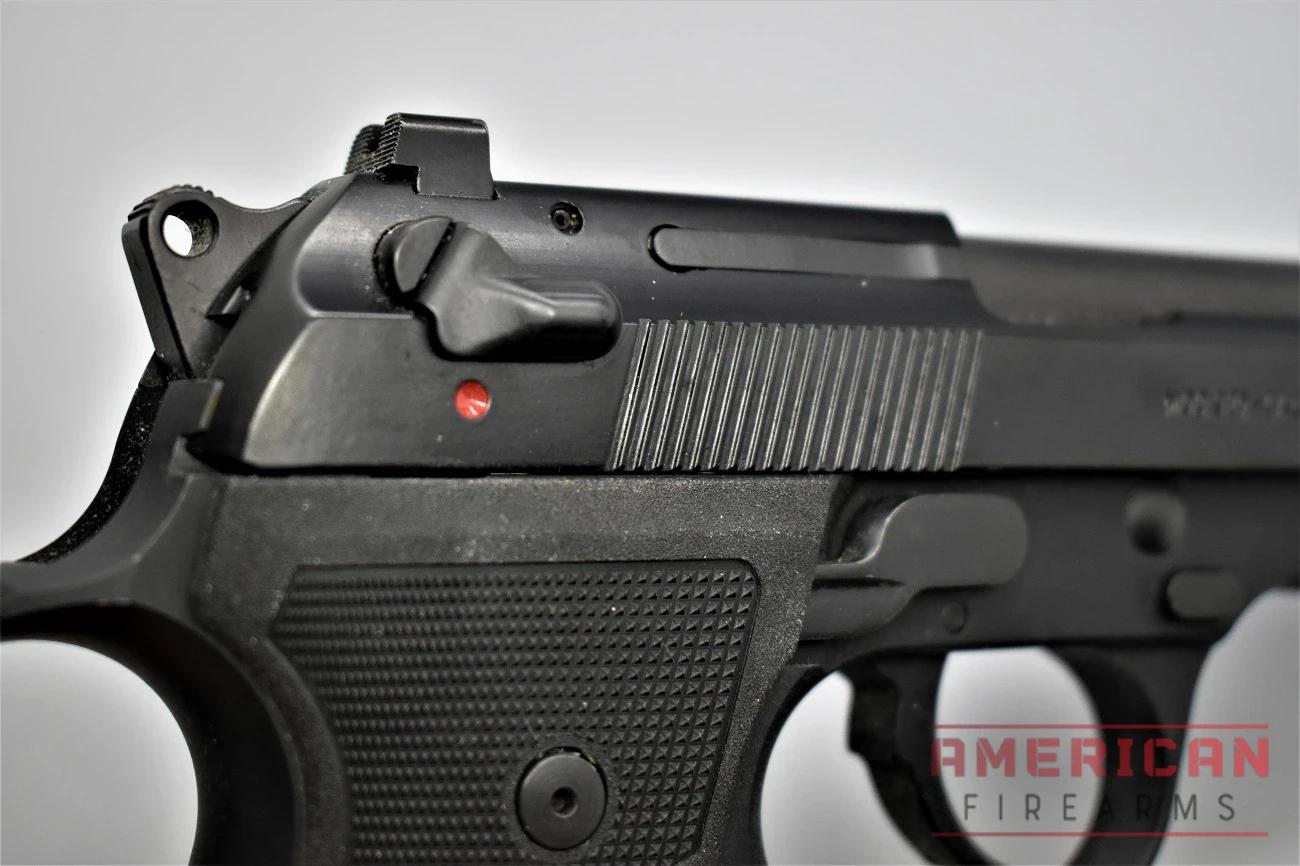
Sights
The 92X series as a rule ships with high visibility orange/black combat sights that are easy to pick out in day and low-light conditions. Newer RDO models include an optics cut for micro red dots, although Beretta doesn’t ship the guns with a full kit of plates– you have to order the one you want. The sights are compatible with M9A3 models.
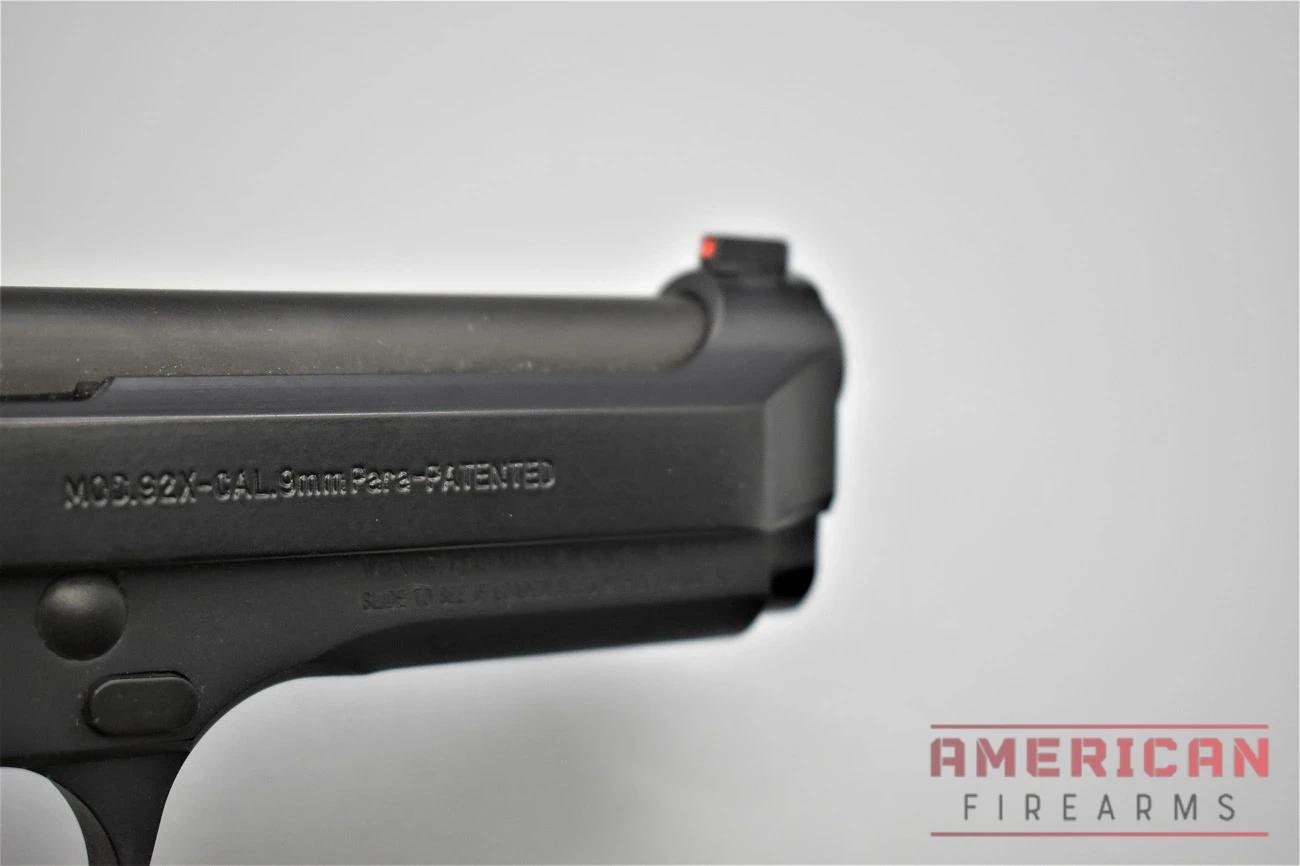
Trigger
The 92X has a thin short-reset trigger made of billet steel, which feels very similar to Berettas of old but has a much more shallow trip on reset. I found mine to break cleanly at 6 pounds in double action and 3 pounds in single.
Accuracy
The 92X is easy to control but the DA/SA nature of the first shot means that you often have a “flyer” that spoils the group’s overall size. To check that, I ran the pistol from the bench at 15 yards in SA mode only and were rewarded with 2-inch five-shot strings on average. In short, it is extremely accurate so long as you put in the time to master the trigger.
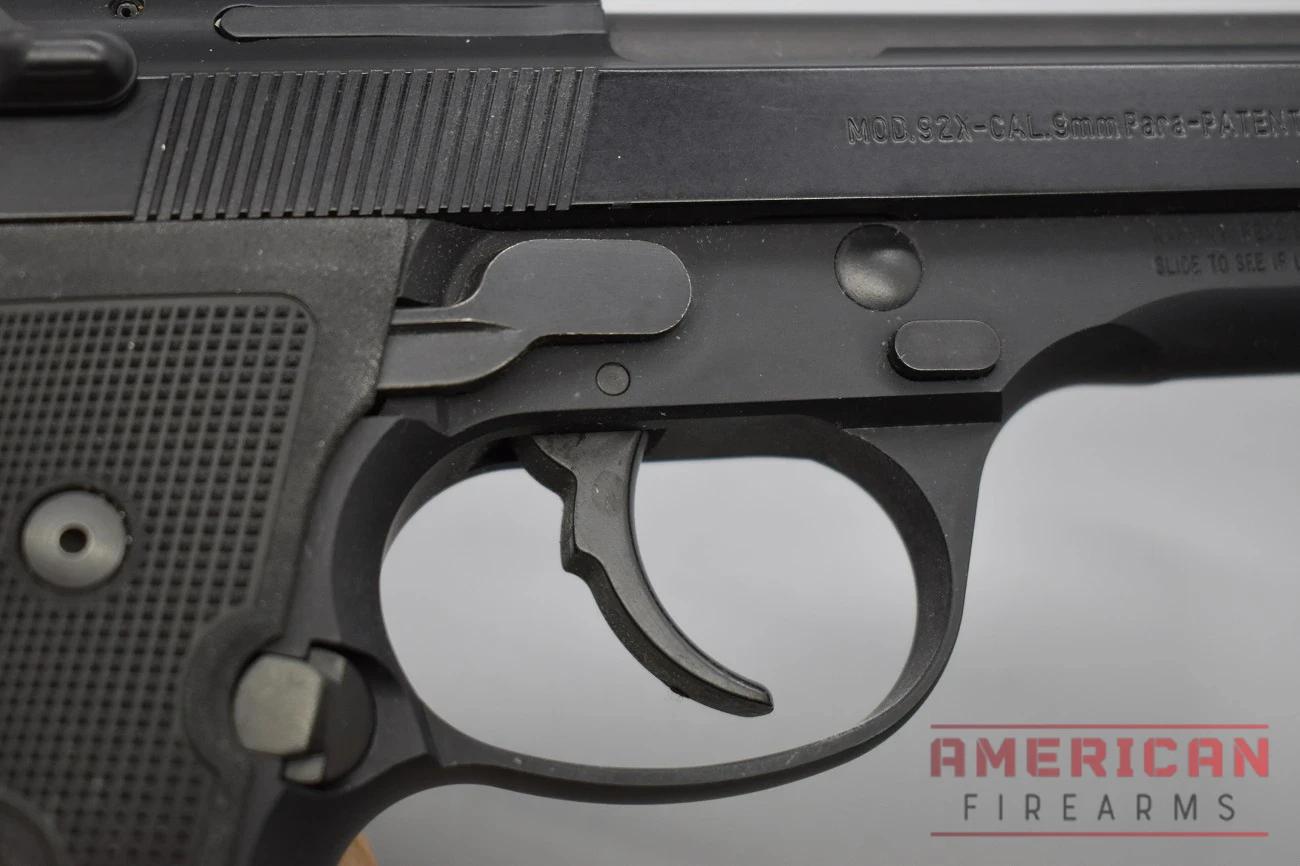
Aftermarket Support
The basic Beretta 92 series has been around since the 1970s and has been extensively replicated by folks like Girsan and Taurus. Going past that, guys like Ernest Langdon and Bill Wilson have taken to offering just about every custom option, part, and service for these guns one could desire.
Odds are, if you want something something modified or added to a 92X, it is just a click away.
3. Competition Pick: Canik SFx Rival
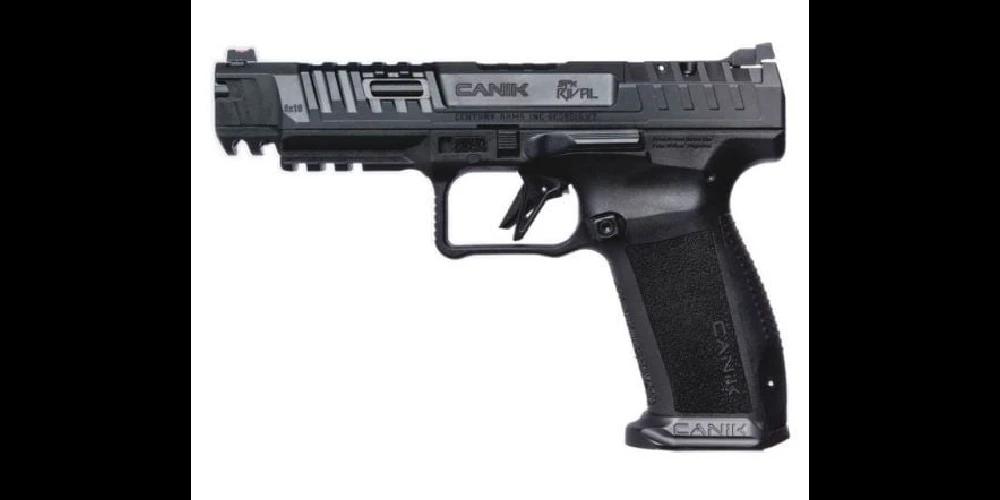
$630.99

55
EXCEPTIONAL
2025 Awards & Rankings
Performance Scores
Specifications:
- Weight: 29 oz.
- Capacity: 18+1
- Length: 8.1 in
- Barrel Length: 5″
The Good:
- IDPA, IPSC, and USPSA compliant
- Amazing value
- Adjustable fiber optic sights and optics-ready
- Superb 90-degree diamond-cut aluminum flat trigger
- Removable external mag-well
The Bad:
- Not for new shooters
- Trigger can be too light for some
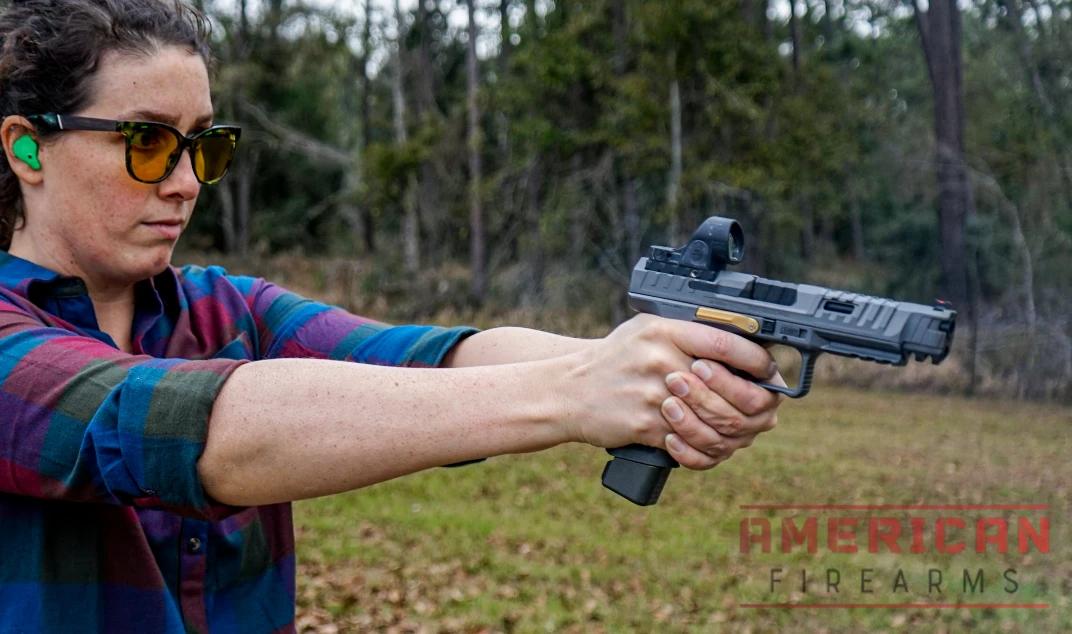
Our favorite competition nine, the Canik SFx Rival offers an unbelievable value & is legal to use in IDPA, IPSC, and USPSA competitions without restrictions — but also makes for a great plinking gun and gives you room for every home defense accessory you could want. It’s also large enough that it’s very comfortable to shoot, especially with 147gr ammo.
My favorite upgrade is the trigger, which is a lightened 90-degree diamond-cut aluminum flat trigger — and it’s a joy to use. The trigger shoe texture gives you a nice contact patch that provides consistent trigger pull that helps me get on target. Additionally, the SFx Rival is fully ambidextrous, enabling you to swap both the magazine and slide releases.
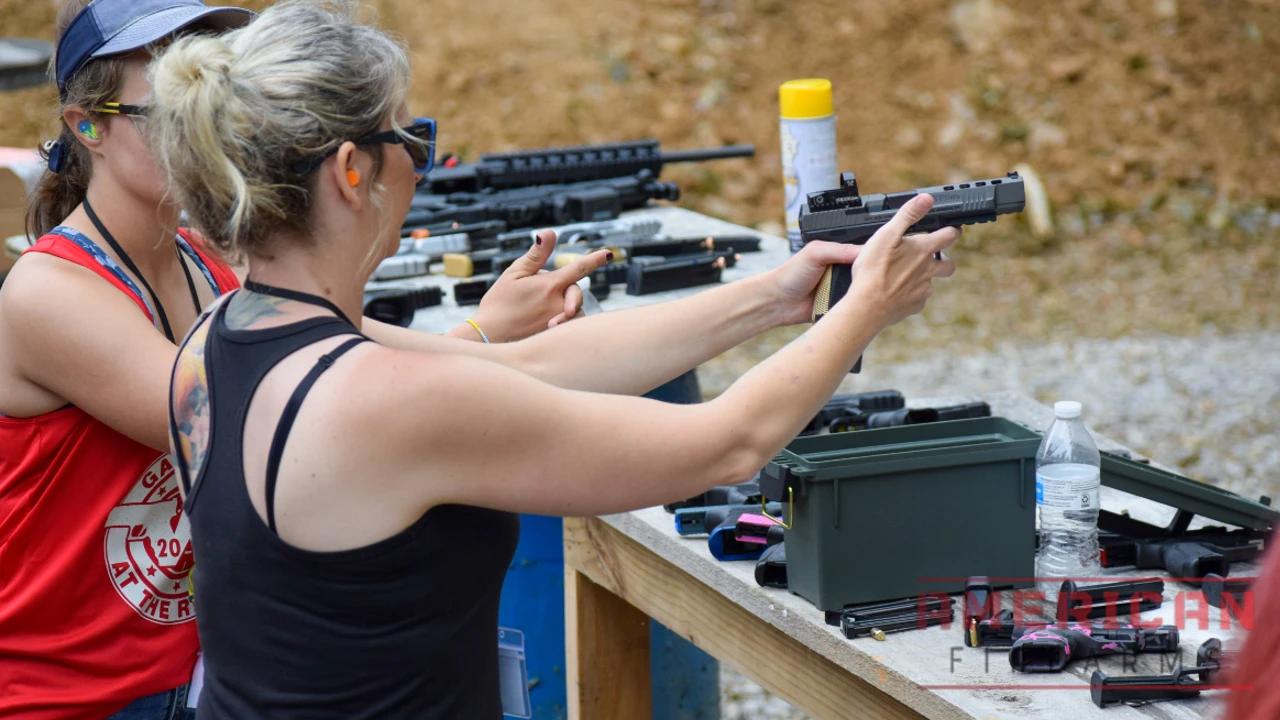
The full-size Picatinny rail allows you to attach your preferred laser or light, and the double undercut trigger guard adds more to the mix by helping me get as high on the grip as possible and suppress recoil. The external mag-well is removable, making it both division compliant and easily customizable.
The SFx Rival pistol comes with two 18-round magazines, two magazine case plates, three different size back straps, and three different size magazine release extensions, so you can start customizing the gun the moment you open the box. Overall, it’s an excellent choice for shooting competitions and one of my personal favorites.
Want more on Canik’s Rival? Read our hands-on review.
4. Modular Pick: Sig Sauer P320 M17
Specifications:
- Weight: 29.6 oz
- Capacity: (1) 17rd / (2) 21rd Steel Mags
- Length: 8″
- Sights: Front and rear (night)
- Finish: CoyotePVD
The Good:
- Durable & proven
- Excellent sights
- Good size and weight
- Smooth, consistent trigger pull
- Good magazine capacity
The Bad:
- Grip could be a bit more comfortable
- 1.4″ width is too large for some
- No trigger safety
The Sig P320 9mm pistol, particularly known for its great factory sights, has both front and rear sights. The rear sights offer contrasting illumination, making the pistol usable in low light or nighttime shooting situations.
The Sig Sauer P320 M17 has both front and rear sights, with the rear sights offering contrasting illumination so you can use the pistol even in low light or nighttime shooting situations.
Developed to both compete for the Army’s Modular Handgun System contract and offer a more forward-looking alternative to their P-200 series pistols, Sig Sauer introduced the P320 in 2014.
We recently had the opportunity to pick up a surplus SIG Sauer P320 M17 from the West Point Military Academy’s competition pistol team. The P320 M17 is the civilian version of the military and law enforcement P320, so it shares a lot of the same characteristics.
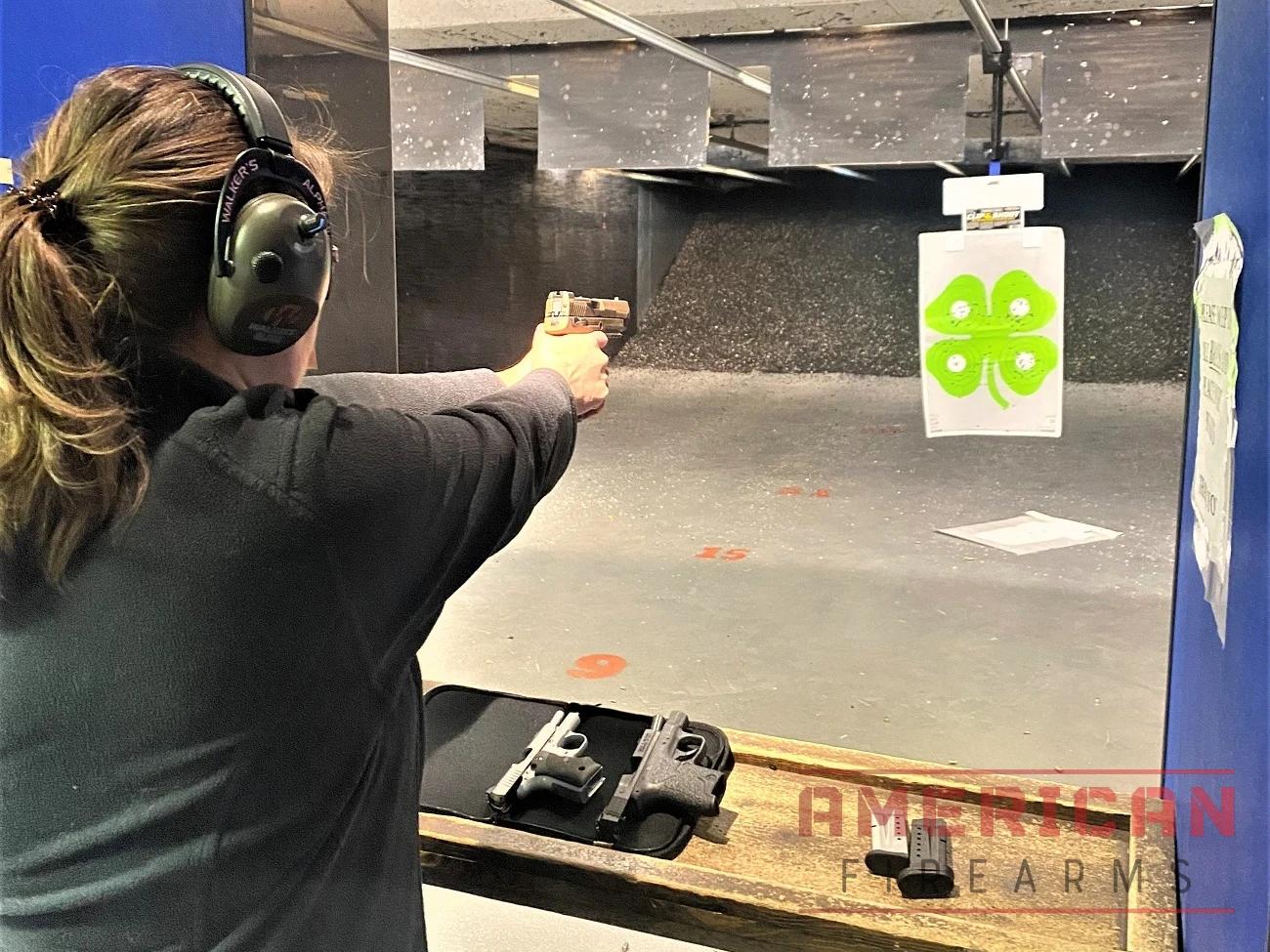
Ditching the common frame and slide format that almost every other semi-auto pistol used, the P320 instead uses a fire control unit that can be swapped out between different grip modules to quickly allow the user to move between full, carry, compact, and subcompact sizes.
The modularity of the design made it a shoo-in for the MHS program, and the military is currently fielding the gun as the M17 and M18 pistols, respectively. This is truly a 21st-century combat pistol.
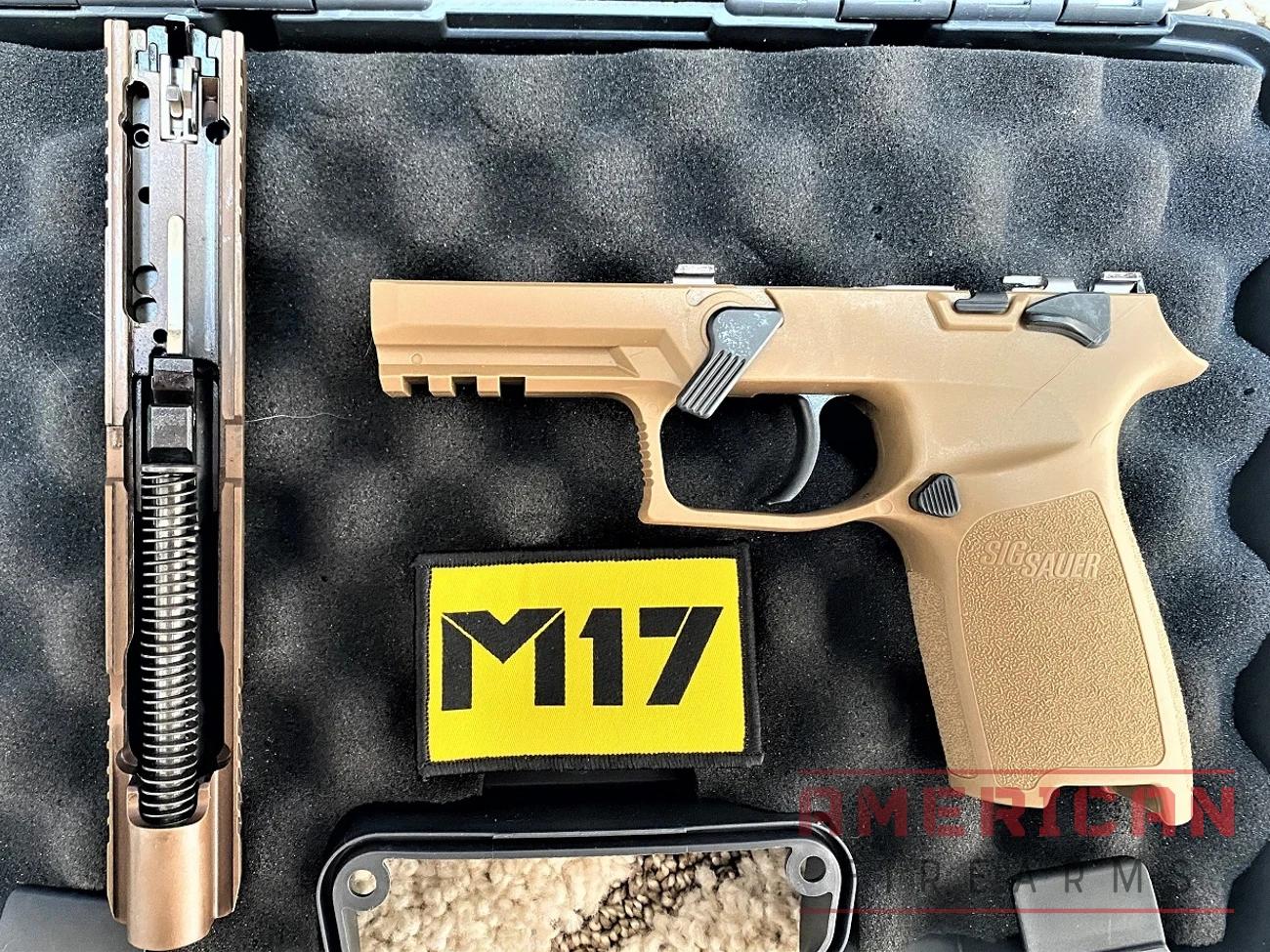
We’re very impressed with the P320 M17 so far. It’s a full-sized, striker-fired, fully modular handgun chambered in 9mm. It’s accurate, reliable, and easy to shoot. We especially like the ambidextrous safety and slide lock/slide release.
The grip is a little thick for some, but it’s still comfortable to shoot. And because it’s modular, you can swap out the grip for a different size if needed. Get the rest of our take in our hands-on P320 M17 review.
Best Compact 9mm Pistols
5. Best Compact 9mm: Smith & Wesson M&P 2.0 Compact
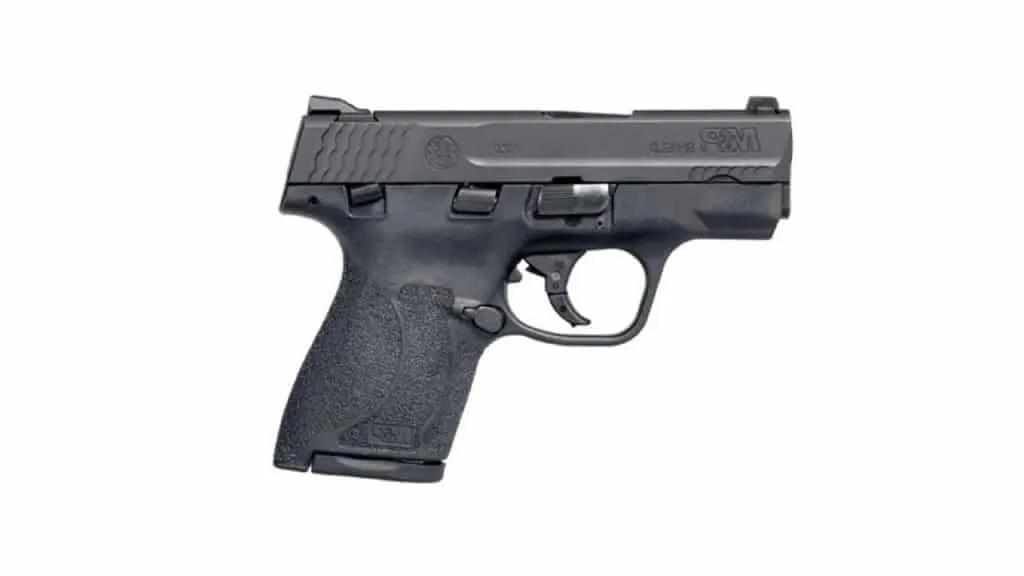
$459.99

41
EXCEPTIONAL
2025 Awards & Rankings
Performance Scores
Specifications:
- Weight: 18.3 oz
- 7+1, 8+1 capacity
- Length: 6.1”
- Sights: front and rear white dot
- Finish: stainless steel and armornite
The Good:
- Very affordable with two magazines
- Good finish for most major parts
- Comfortable polymer grip
- Has good sights
The Bad:
- Stock trigger safety makes for a mushy feel
In 2012, Smith & Wesson introduced the new Military & Police series, moving away from their Reservoir Dogs-era metal-framed “wonder nines” to the now-famous polymer pistol.
It’s no surprise that Smith & Wesson tops this chart with a relatively new member of their M&P series: the M&P Shield 2.0 Compact. I have always found the pistol light, reliable, and easy to use, and the pistol has both a steel frame and stainless steel Armornite finish for both the barrel and the slide, making it duty-level durable.
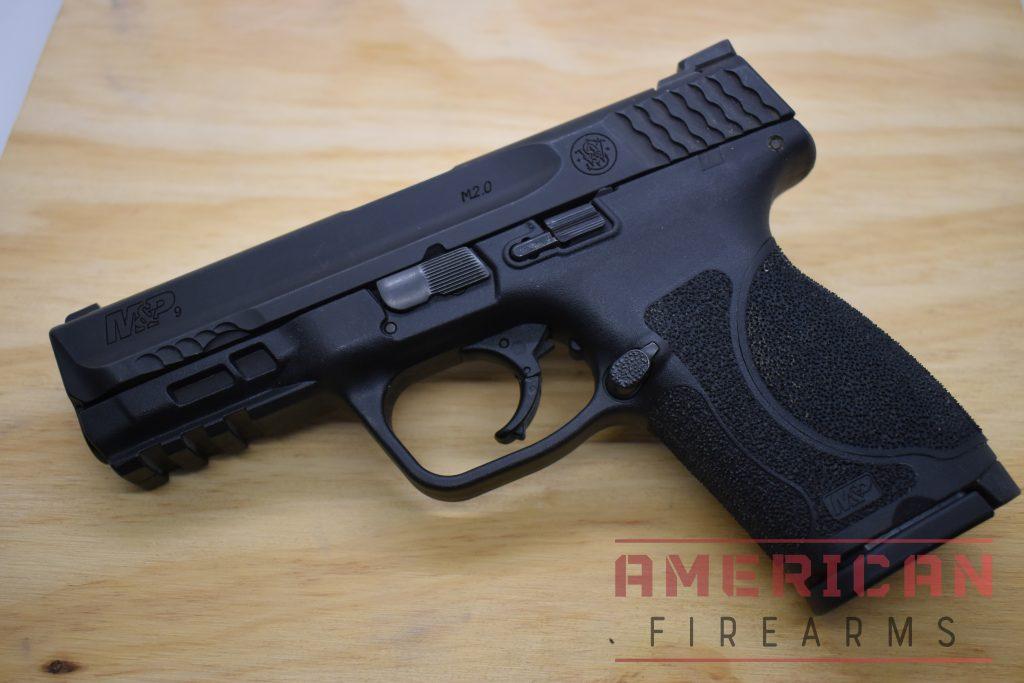
In a nutshell, the coating provides the weapon with a durable finish that has protected mine from corrosion and damage – and despite hundreds of range trips, countless cleanings, and thousands of rounds, my M&P looks practically new.
Moving on from hammer-fired DA/SA pistols to striker-fired guns, the new M&Ps had to slog it out against Glock, which had already carved out a big part of the LE market, but the fact the M&P line has better triggers and sights while sporting the same level of reliability and a “made in USA” cache bought the Smiths lots of room to maneuver.
Today, the second generation M2.0 variants, particularly the Compact version, is about the closest thing to a “Glock killer” as one gets. Plus, the M&Ps of all generations have a take-down lever and sear deactivation system that allows for disassembly without pulling the trigger– something most other polymer guns lack.
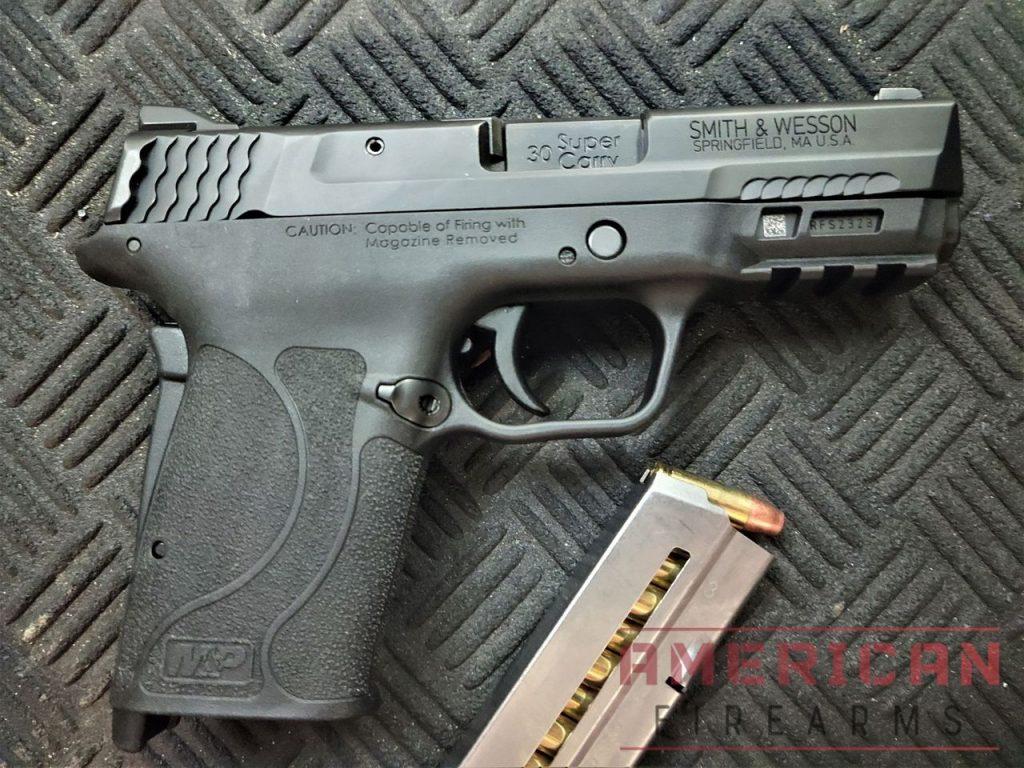
For those looking for something in the M&P2.0 neighborhood, there’s also a single-stack subcompact companion to the M&P, the Shield, beating Glock’s 43 series gun by several years.
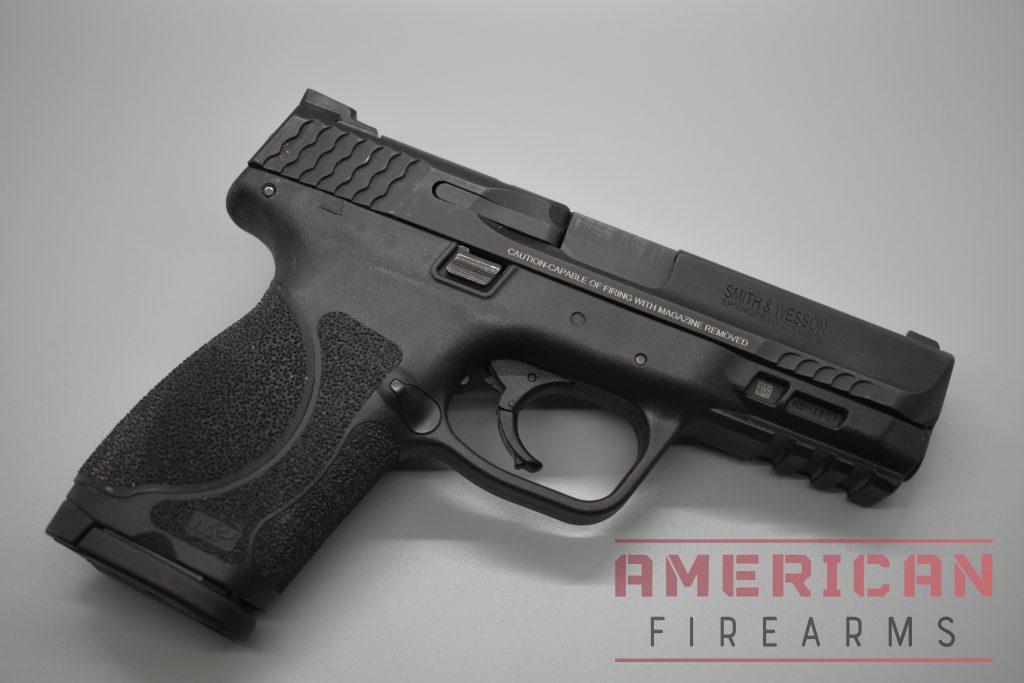
Today, the Shield M2.0 has a better trigger than the first-gen models, as well as aggressive grip texture and an optimal 18-degree grip angle for a natural point of aim.
Thin and lightweight, the Shield boasts a 7+1 and 8+1 capacity depending on what magazine you use and the new Shield Plus aims to take on the Sig 365 in the Micro 9 game.
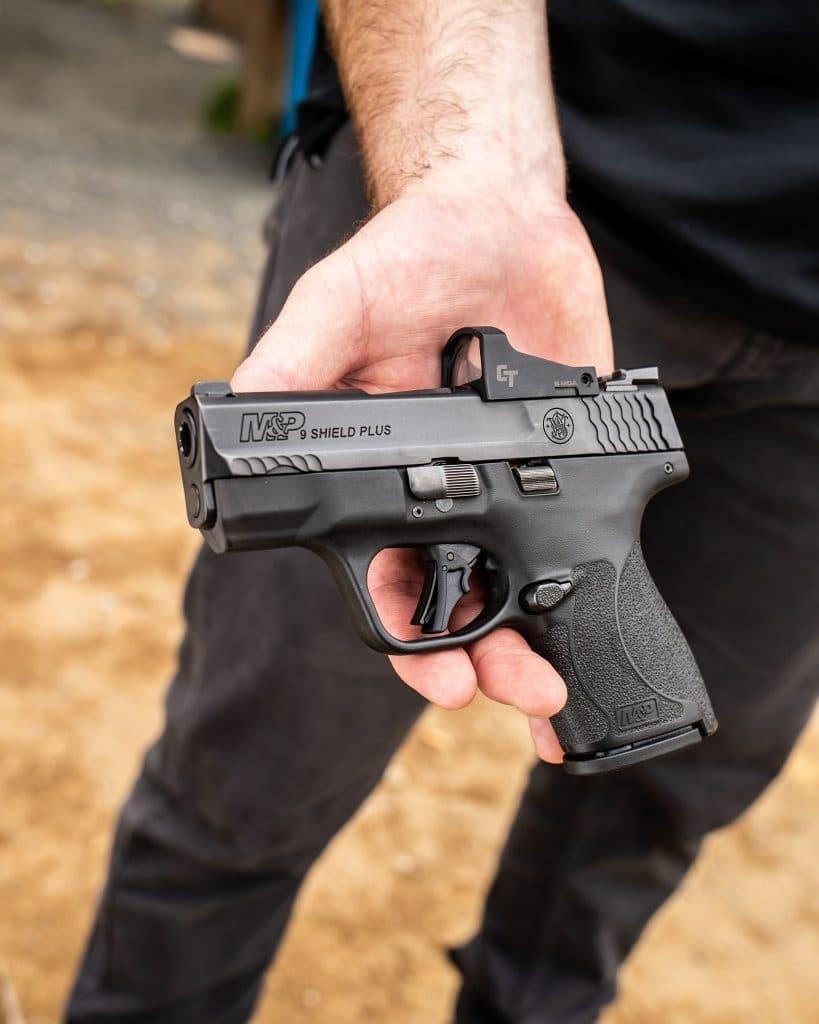
Designed with performance and safety in mind
The M&P, with its full-size frame, features an easy-to-access external safety. I find it more user-friendly than some compact 9mms that position their safeties too close to the slide.
I find the factory front and rear white dot sights easy to use and plenty visible in a variety of lighting conditions, even brighter environments, or when the sun is overhead.
You get a lot of value out of this striker-fired pistol as well, as it comes with two magazines out of the box. Ultimately, it’s a durable and serviceable metal-framed pistol that fires the reliable 9mm luger at works well for training, self-defense, and concealed carry.
We break the Shield 2.0 down even further in our hands-on review.
6. All-Purpose CCW: Glock 19
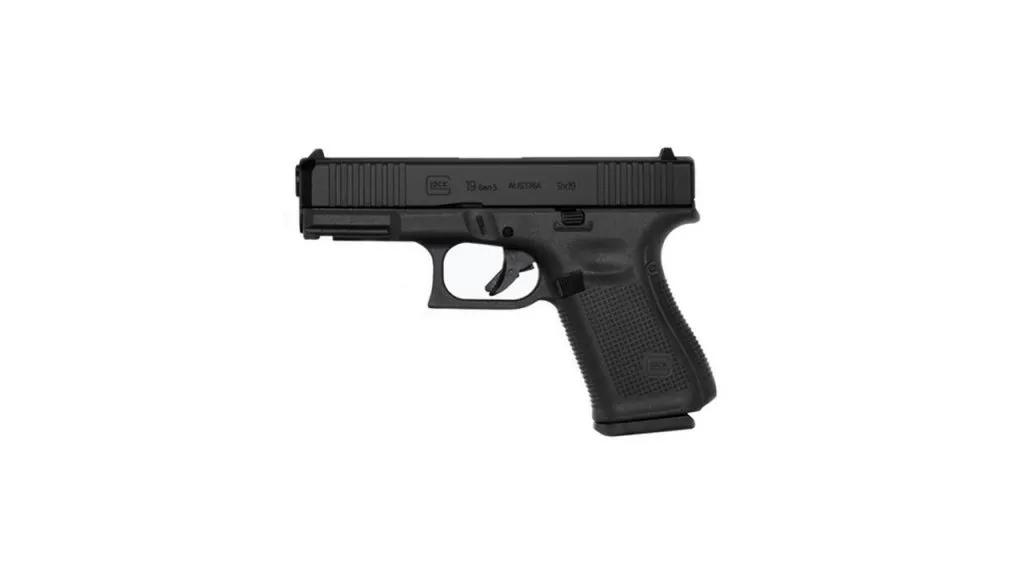
$649.99

41
EXCEPTIONAL
Performance Scores
Specifications:
- Weight: 23.63 oz
- Capacity: 15
- Length: 7.28 in
- Barrel Length: 4.02 in
- Width: 1.26 in
The Good:
- Lengendary reliability
- Larger mag release button
- Ambidextrous slide stop
- Reversible magazine catch
The Bad:
- No finger grooves
- Only includes 2 backstraps
A more compact version of Gaston Glock’s G17 design, the Glock 19 for many, is the perfect multipurpose handgun.

With a standard 15+1 round capacity, the G19 stands ready for use in home defense, is enjoyable to shoot on the range (there are documented specimens still ticking with well over 100,000 rounds fired), has more aftermarket support than just about any other firearm ever produced shy of the AR-15, and, when using the right holster for the right person, is a great gun for concealed carry.
The simplicity and safety of the Glock platform also make the G19 an approachable option for novice shooters looking for a first gun that will be simple to maintain and easy to use.
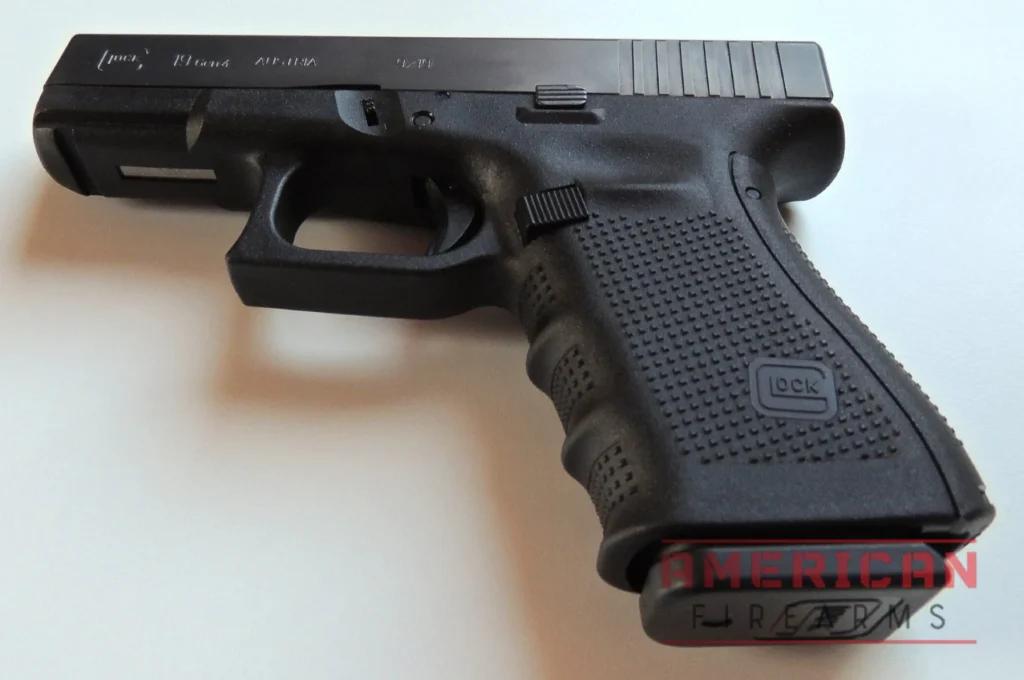
There is a reason the G19 consistently tops the best-selling pistols list. Go for the Gen 5 model for the most current set of features — and for a deep dive, take a look at our review of the G19.
On the fence between the G19 and G17? I break down the differences in our comparison guide.
7. Best Glock Clone: Ruger RXM
Specifications:
- Weight: 23.2 oz
- Capacity: 15+1
- Length: 7.15 in
- Barrel Length: 4.0 in
- Width: 1.26 in
The Good:
- Genuine modularity with swappable fire control insert
- Direct-mount optics system eliminates adapter plates
- Improved 20-degree grip angle over Glock’s 22-degree
- Glock Gen 3 magazine and parts compatibility
- American-made at competitive pricing
The Bad:
- Early production quality control issues (now resolved)
- Limited aftermarket support compared to Glock
- Break-in period required for optimal performance
The Ruger RXM represents exactly what the striker-fired market needed—meaningful innovation built on proven foundations. Born from a collaboration between Ruger and Magpul, this modular 9mm addresses long-standing complaints about Glock ergonomics while maintaining the reliability and simplicity that made striker-fired designs popular. It *just* beat out the Shadow Systems DR920 on our list due to its superior value.
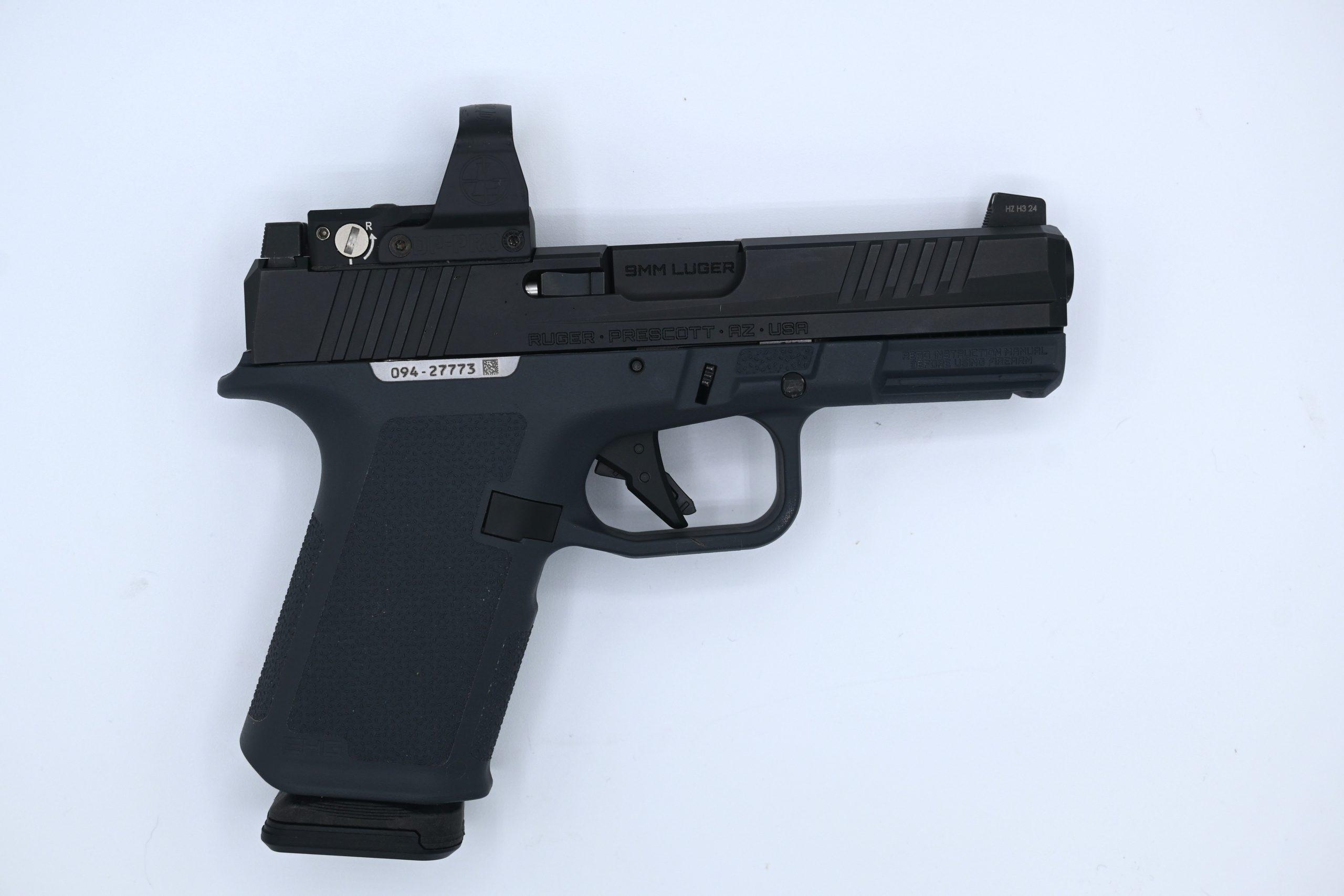
At the heart of the RXM’s innovation lies its steel fire control insert system. Unlike traditional polymer-frame pistols where the grip itself is serialized, the RXM uses a removable stainless-steel chassis housing all fire control components.
This modularity opens possibilities well beyond simple backstrap swaps, allowing users to switch between different grip modules as needs change.

The collaboration shows in every detail. Magpul’s Enhanced Handgun Grip features their TSP texturing, providing secure grip without punishment during extended carry. The 20-degree grip angle feels more natural than Glock’s 22-degree standard, requiring less conscious adjustment for rapid target acquisition.
The direct-mount optics system eliminates adapter plates entirely, using removable dowel pins to accommodate RMR, DeltaPoint Pro, and RMSc footprints. This positions optics lower on the slide while providing more secure mounting than traditional plate systems.

After initial break-in, the RXM demonstrated excellent reliability through 1,500+ rounds of varied ammunition. Early production barrel rifling issues have been resolved, and current manufacturing quality meets expected standards for the price point.
Street prices typically run $75-100 less than comparable Glocks while including features that cost extra on Austrian imports. The American manufacturing and Glock compatibility create compelling value for shooters seeking proven reliability with meaningful improvements.

The RXM succeeds by doing what American manufacturers do best: taking proven concepts and making them work better for real users. It’s the kind of practical innovation that moves the industry forward without leaving proven concepts behind.
Best Sub-Compact 9mm Pistols
8. Best Sub-Compact: Sig Sauer P365XL
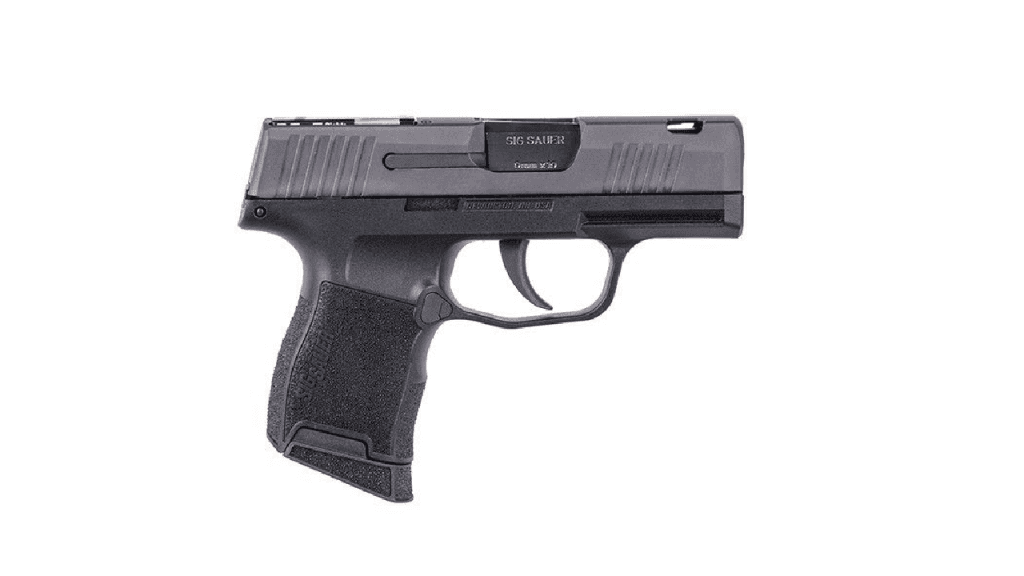
$1268.99

29
AVERAGE
2025 Awards & Rankings
Performance Scores
Specifications:
- Weight: 17.8 oz
- Capacity: 12+1
- Length: 6.59 in
- Barrel Length: 3.7 in
- Width: 1.0 in
The Good:
- Fantastically small
- Super concealable
- Decent capacity for a pistol this size
The Bad:
- Intermittent failure to return to battery
- Small grip a challenge for support hand
Sig kind of broke the carry gun market with their P365. The lead entry into what are now commonly referred to as “Micro 9s”, these are very small pistols, rivaling single-stack subcompacts such as the FN 503 or Glock 43, but have a modified double-stack magazine giving them a 10+1 or 12+1 capacity. The P365 is generally the first recommendation we’d make for someone looking at the Micro 9 category of sub-compacts.
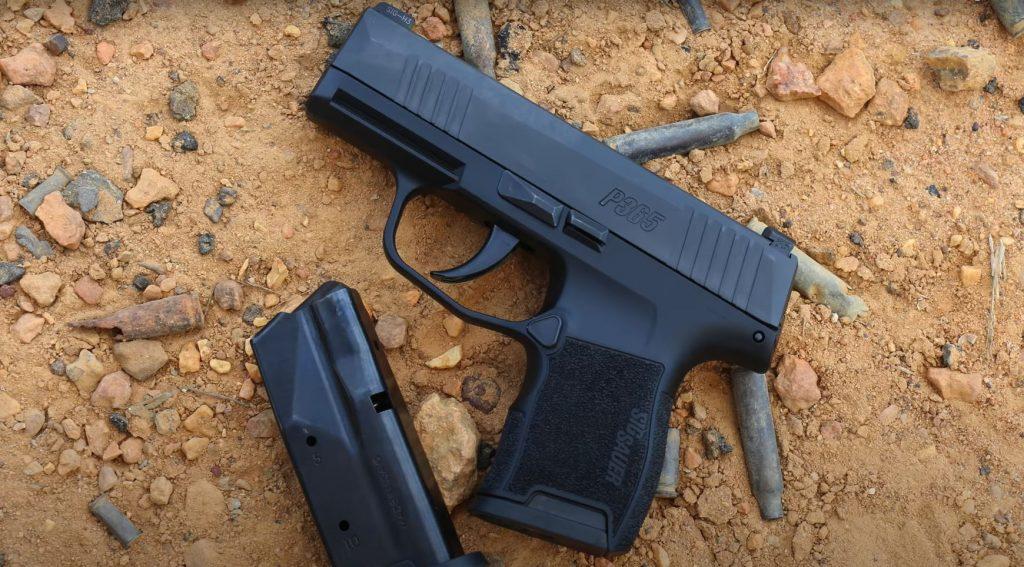
Since its initial introduction, Sig has expanded the P365 series with larger XL and XL Spectre models as well as a melted SAS model and the largest of the bunch, the XMacro.
They have also sparked a whole line of imitators that are trying to keep up; however, most of those other Micro 9s, for now at least, should probably still be in the beta-test first-generation stage. I’ve been carrying a Sig P365XL with a RomeoZero Elite 3 MOA red dot for about a year. As one of my carry guns, I like the 12+1 rounds of capacity packed into a small compact gun.
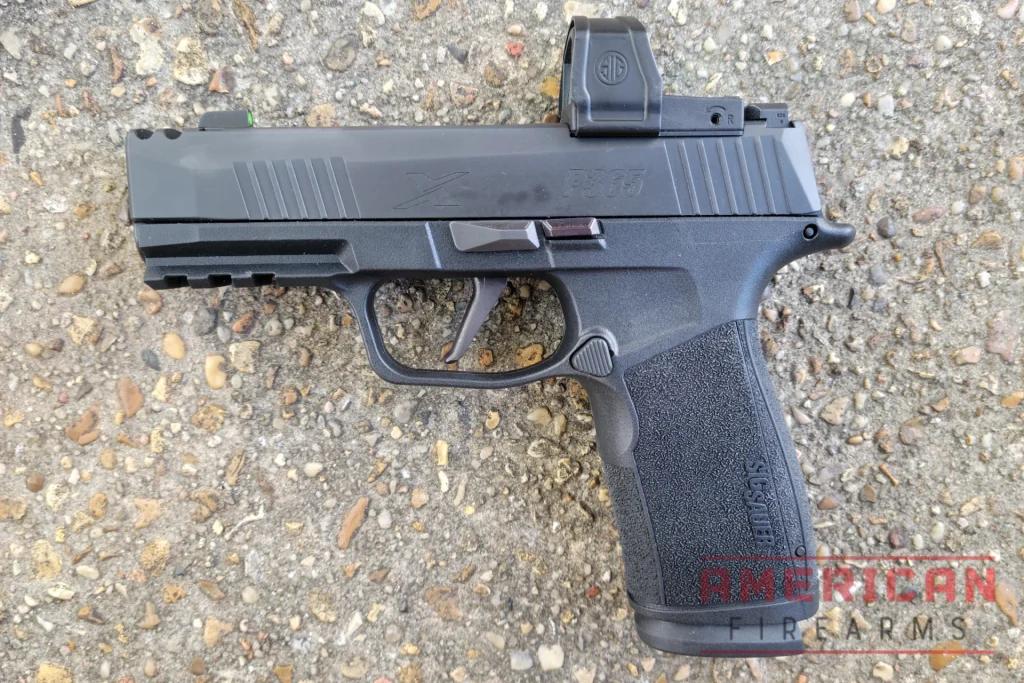
The Romeo Zero is not my favorite red dot, but it is an easy option when it comes already outfitted on the gun. This pistol is striker fired with an XSeries straight trigger, and if you’re familiar with Sig’s triggers, it feels similar to those on the P320 and Legion model pistols.
Even with the red dot optic, it is set up with a front sight in case anything fails on the red dot optic.
What I love most about this pistol is the grip texture of the 365 XSeries grip module. Its subtle texture doesn’t rub your skin poorly when carrying but gives you a comfortable purchase of the gun to hold on to during recoil.
The magazine release button is shaped like a triangle and sits almost flush with the grip to ensure you don’t accidentally bump it and release your magazine unintentionally. The slide serrations are easy to grab onto and rack the slide, and depending on the light model, you can still mount a light to the pistol.
We took the P365 XMacro out for a spin, and while it’s a newer, larger take on the P365 series, it shares the same DNA as the previous models but still makes for a sweet concealed carry handgun.
9. Ankle/Pocket Carry Pick: Glock 43

$598.99

49
EXCEPTIONAL
2025 Awards & Rankings
Performance Scores
The Good
- Absolutely dependable
- So small and slim that it can be easily concealed
- Available in G43 and G43x (higher capacity) variants
The Bad
- Tough to get back on target rapidly
- Kind of snappy
- Iddy Biddy Grip
Specs
- Caliber: 9mm
- Barrel Length: 3.41 inches
- Overall Length: 6.26 inches
- Weight: 16.3 ounces, unloaded
- Magazine Capacity: 6+1
The smallest 9mm handgun that Glock makes, the “slimline” Glock 43 was introduced in 2015 and was an instant hit. Probably the best single-stack 9mm carry pistol on the market, the Glock 43 deserves consideration if you’re in the market for a reliable handgun that scores high on concealment.
Providing a 6+1 capacity pistol that was smaller than some of the most compact .380s and .32s on the market, the G43 soon became the choice of many for concealed carry, be they the average CCW holder or off-duty police.
Hitting the scales at just 20 ounces when fully loaded, the gun is one of the few 9mm pistols that can be ankle carried comfortably. I dove deep into the G43 in our review of Glock’s concealed carry masterpiece.
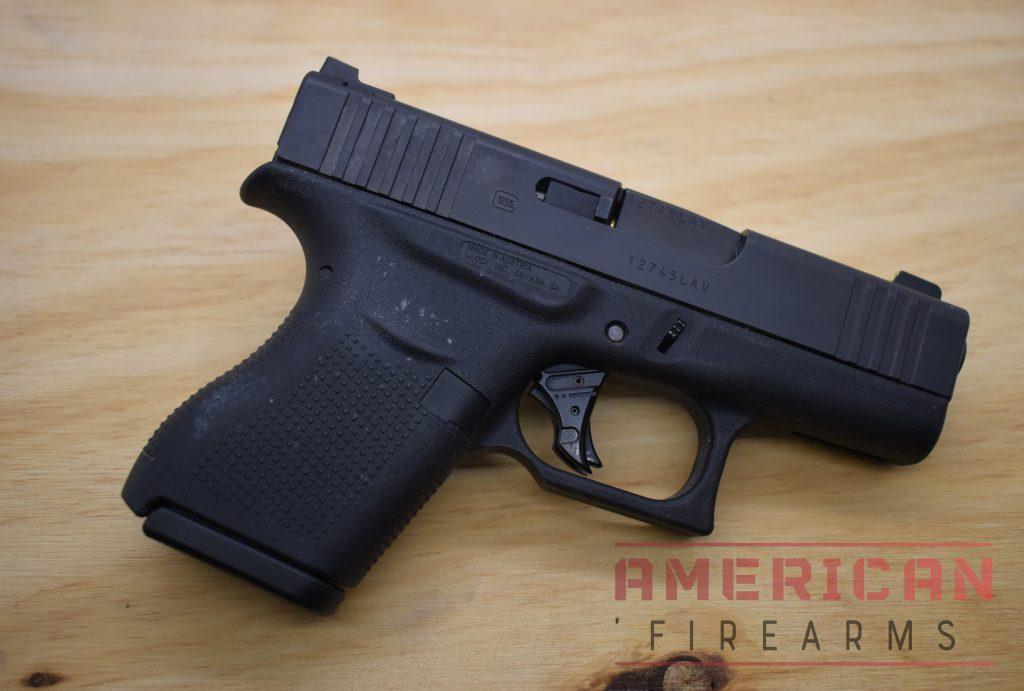
History
The Glock 43 Vickers 9mm was first announced as a caliber upgrade from Glock’s successful .380 ACP chambered Glock 42. This new 43 series gun offers users a 6+1 round capacity of 9mm in a slim, pint-sized package.
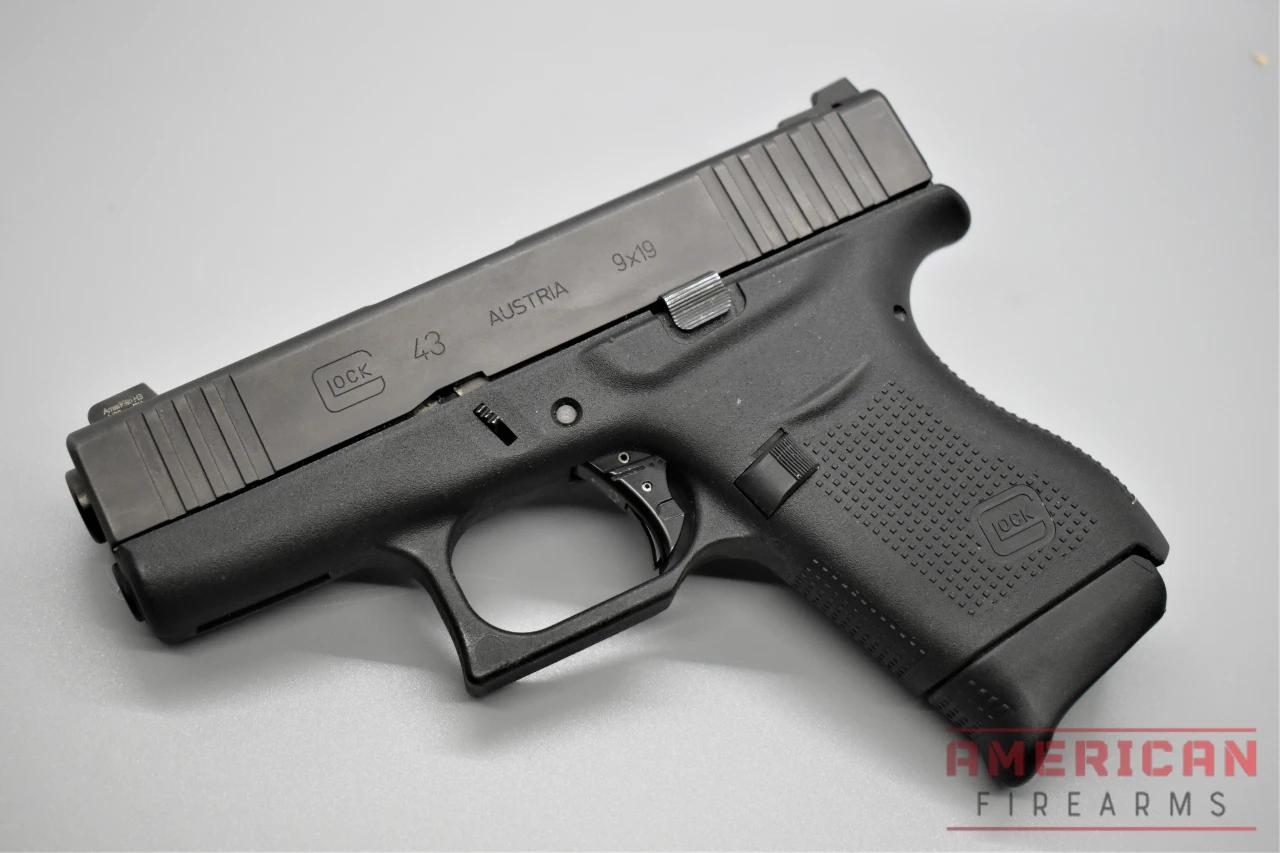
Features
Exceedingly slim at just 1 inch over the widest part of the grip, the G43 hits the scales with a loaded weight of just 20 ounces while keeping a respectable 3.41-inch barrel length that allows the pistol to deliver when it comes to performance.

Controls
Like most other standard Gen 4 Glocks, the G43 has left-side controls including a push-button magazine release and slide lock.
The mag always drops free in my testing or range days, but the slide lock, being small and recessed, is often hard to operate, which may force you to just fall back to the “slingshot” method of racking the slide.
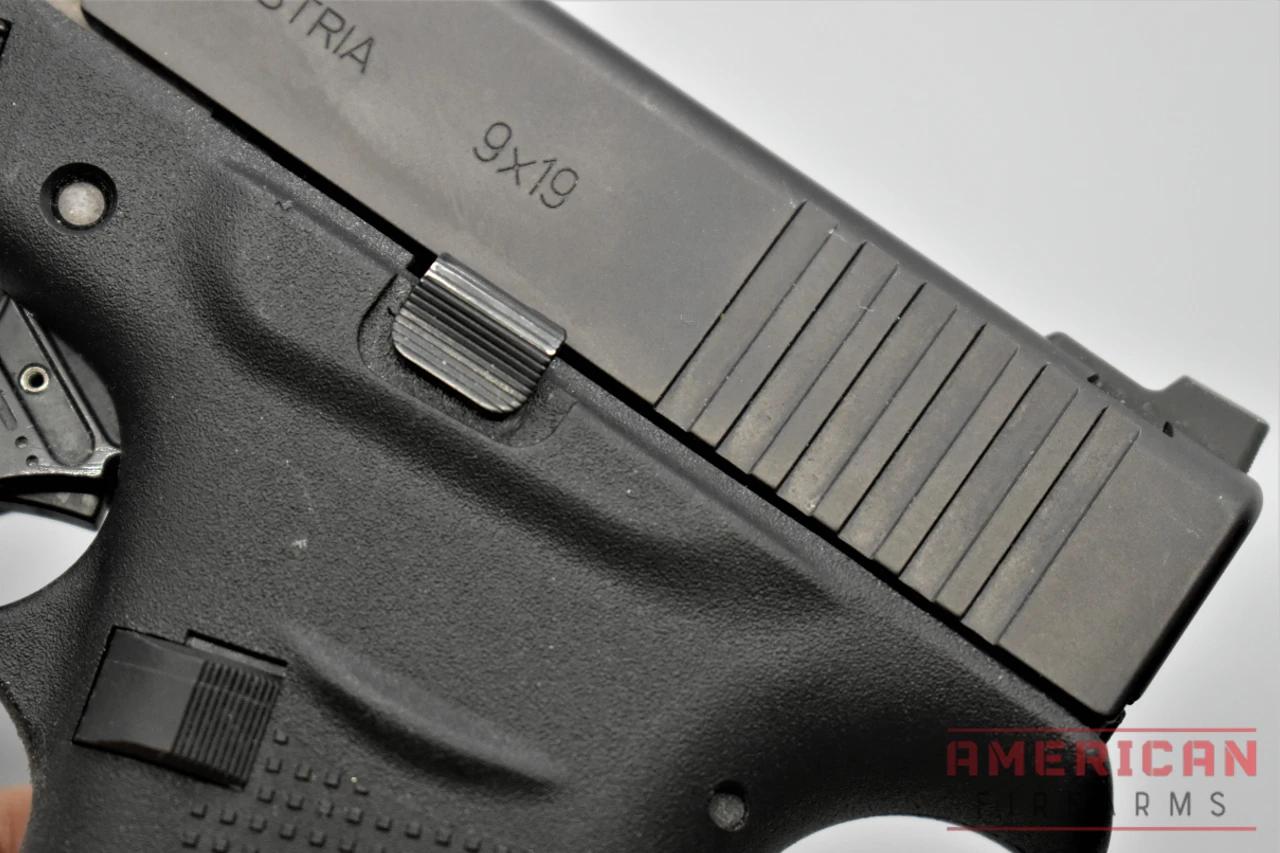
Ergonomics
The G43 uses Glock’s standard 360-degree RTF texture on the grip. As the pistol is short, at just 4.25 inches tall with a standard flush-fit magazine, the grip is abbreviated and folks with even normal sized hands will have at least the bottom two fingers left hanging.
This can be fixed using extended magazine base plates.
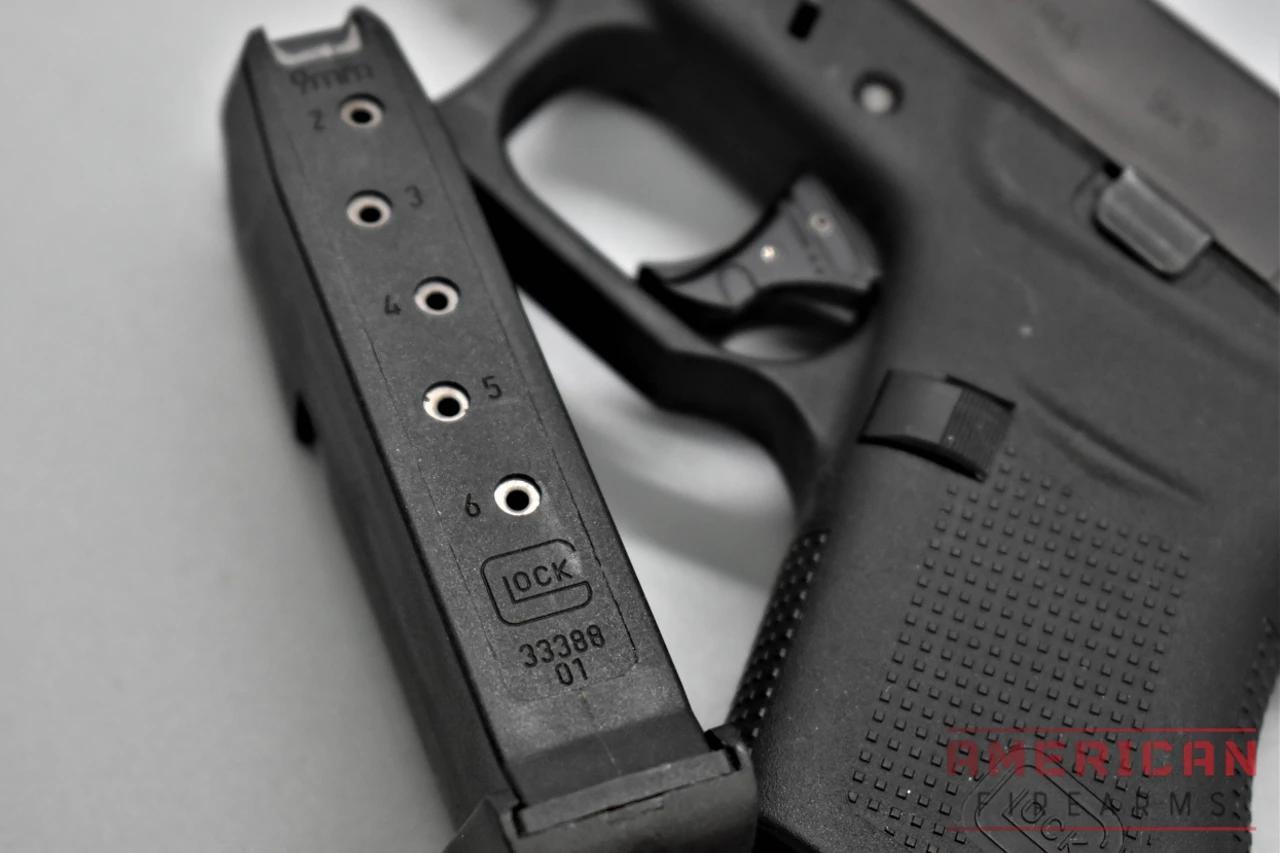
Reliability
It is a Glock. I have had zero malfunctions or funny range stories to pass on — after 500 rounds in dedicated testing and with all the range time I have behind me outside of tests.
Sights
Glock’s standard plastic sights are functional and easily replaced, although many folks aren’t fans of the U-shaped rear sight. I find it perfectly usable, but if you don’t, there’s a load of aftermarket options out there — we are talking about a Glock here.
The front sight is, again, totally functional, but I swapped the front out for a night sight because they’re just so much more usable in dim and dark lighting.
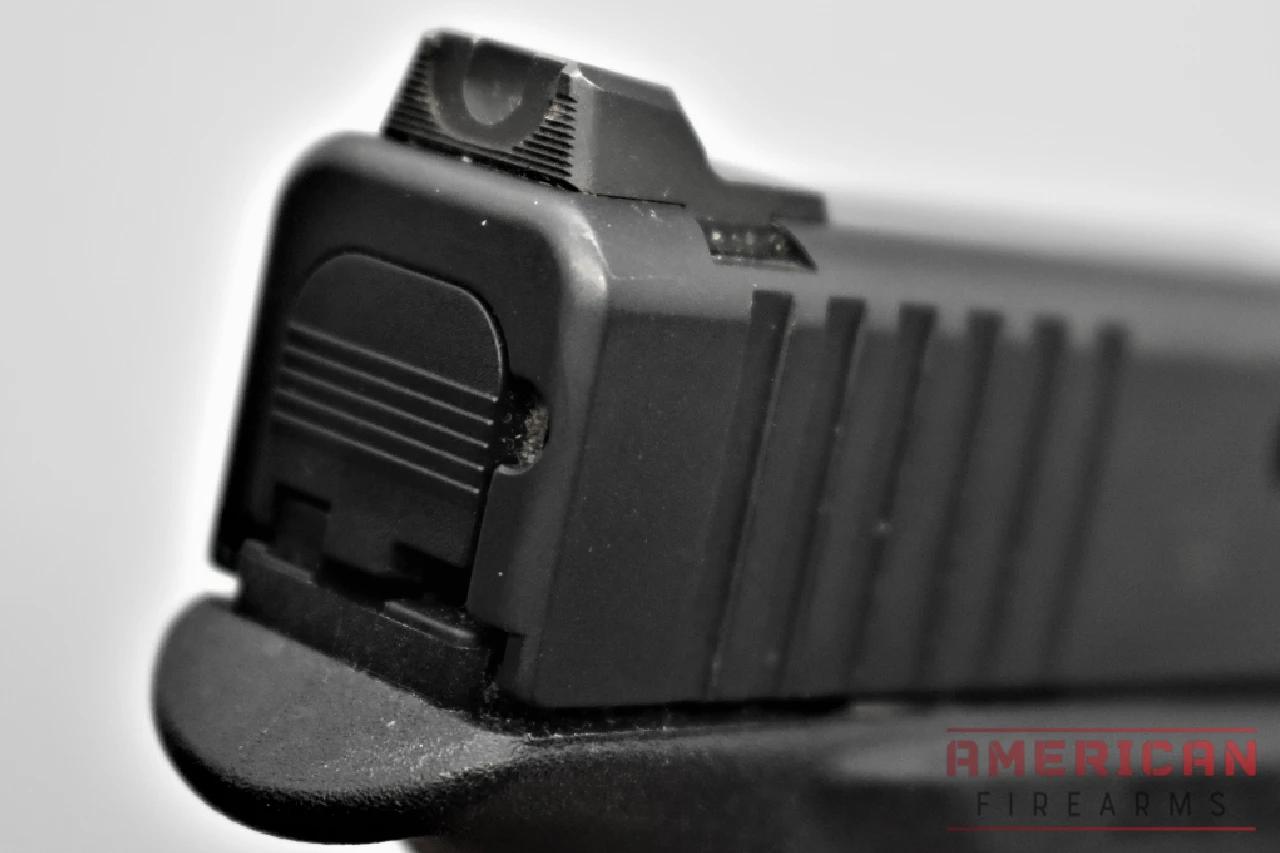
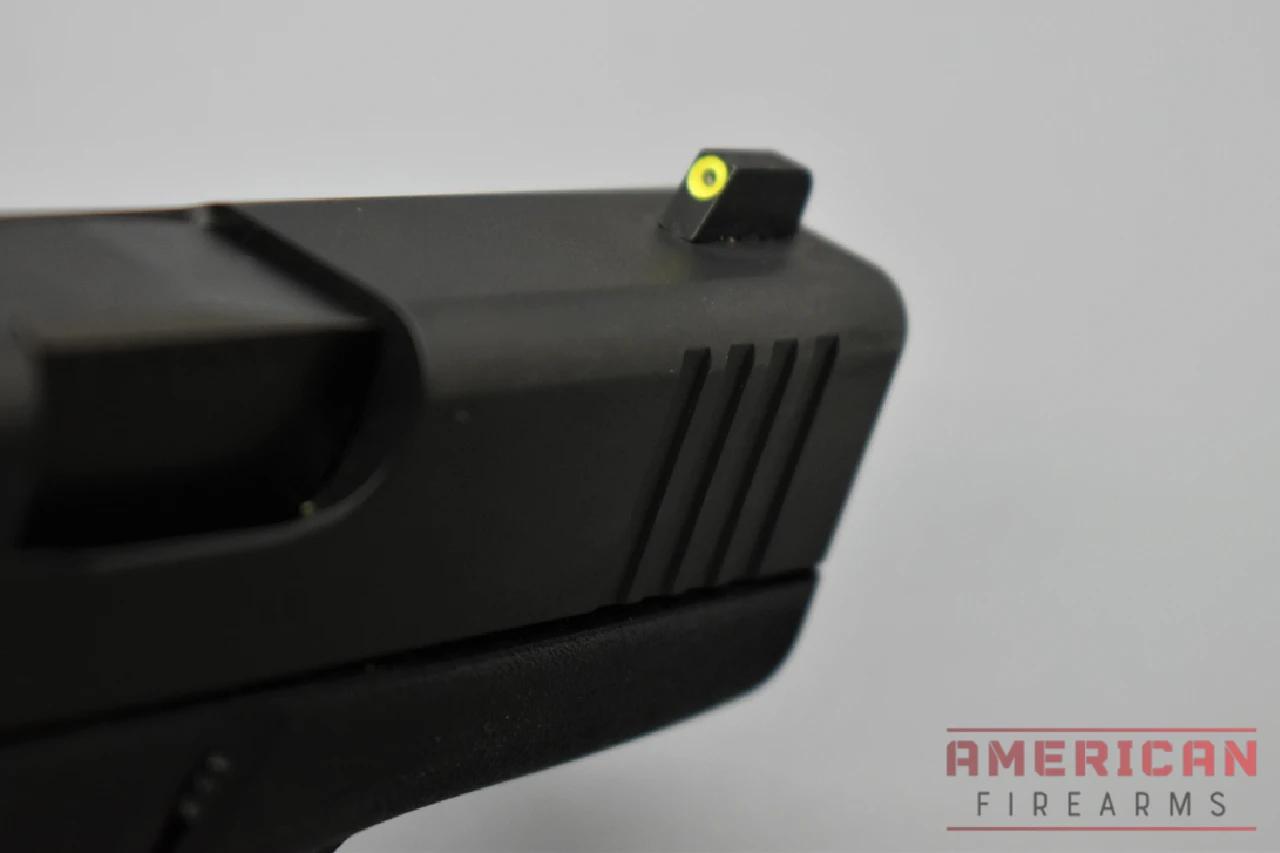
Accuracy
At practical distances, being 15 yards or less, the G43 performs well, and landing 2-3 inch groups is a breeze. It is only after stretching back 25 yards or more than the short sight radius started to make it hard for me to keep inside an eight-inch circle without serious concentration.
Aftermarket Support
Magazines, sights, and internals are widely available both in Glock’s own factory standard and by third-party companies. There are lots of options to replace Glock triggers with literally dozens of firms making them.
Trigger
Glock bills the G43 as having a 5.4-pound trigger, which I can vouch for in testing and direct measurement with my trigger scape. There is a significant level of “creep” in the trigger, but the trigger is nonetheless functional.

For those who would prefer a few more rounds, the Glock 43X still has a slim profile but offers a 10+1 capacity and is just three ounces heavier, making for an effective concealed carry weapon with a little more on tap.
10. Budget Micro CCW: Taurus GX4
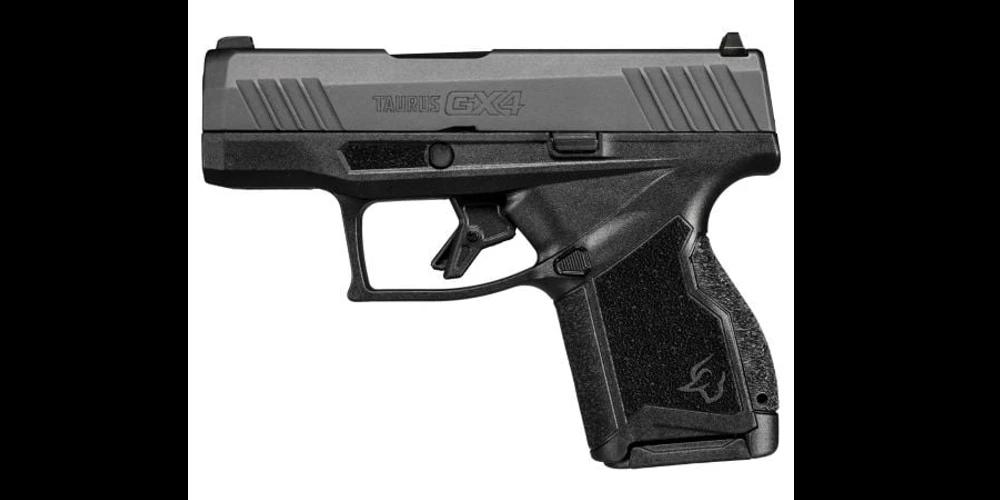
$399.99

48
EXCEPTIONAL
2025 Awards & Rankings
Performance Scores
Specifications:
- Caliber: 9mm
- Barrel Length: 3.06 inches
- Overall Length: 6.05 inches
- Weight: 18.7 ounces, unloaded
- Magazine Capacity: 10+1 flush fit, 11+1 or 13+1 round extended.
The Good:
- Offers similar concealability and performance to the more expensive P365
- Affordable price
- Uses Glock-pattern sights
The Bad:
- Surface controls could be better
- Takedown pin feels outdated
For those in search of a great EDC pistol that might have been overlooked, the GX4 is an excellent option. Taurus, with its long history of producing polymer-framed 9mm pistols, introduced the PT-111 back in 1997.
They continued to improve and evolve their designs with the G2 and G3 series, but it wasn’t until May 2021 that they introduced their first “micro-compact” concealed carry defensive pistol: the GX4. In response to popular options like the Sig Sauer P365 and Springfield Armory Hellcat, the GX4 was Taurus answer to the demand for a wallet-friendly, high-performing, concealable pistol.

Features
The standout feature of the GX4 is its compact design and excellent concealability. Every component of the gun feels meticulously crafted to be as slim and lightweight as possible, all while maintaining a budget-friendly price point.
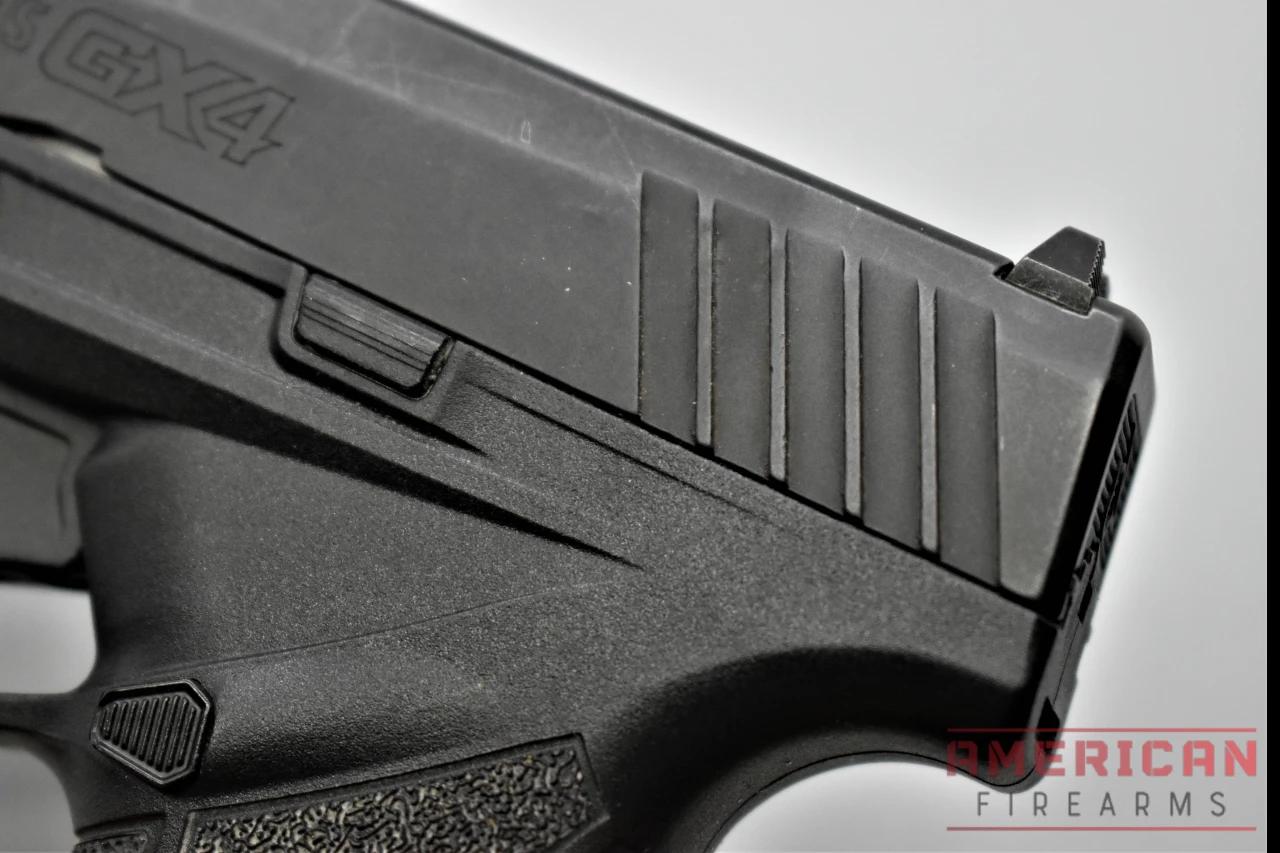
Controls
The GX4 features simple controls, with a focus on a “melted” and snag-free design. The slide catch is small and recessed on the left side only, making it difficult to use. The reversible push-button magazine release functions well, and the magazines drop free. Takedown requires a tool, as there is no onboard disassembly lever.
Ergonomics
Despite feeling smaller in the hand compared to other micro-compact 9mm pistols, the GX4 offers good 360-degree texture in the grip and other nice ergonomics, such as thumb tabs on the frame. It carries comfortably, even in appendix positions.
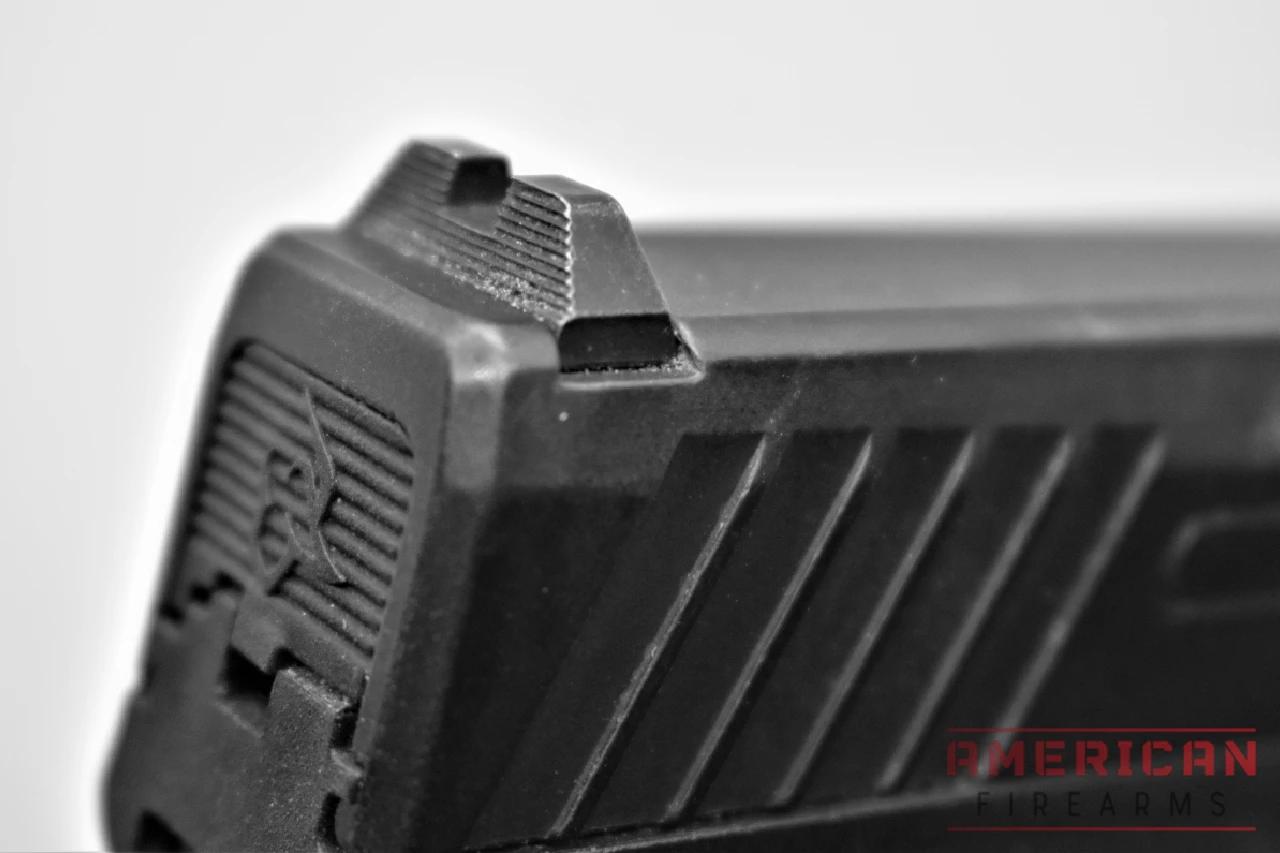
Reliability
After putting 500 rounds of various factory loads through the GX4, I found it to be highly reliable (and fun) on the range, with no malfunctions logged.
Sights
While the GX4 features the wise choice of Glock-pattern dovetail/mounts, Taurus chose steel sights over the often-criticized Glock plastic sights.
The front sight is a fixed dot, while the rear is a blacked-out drift adjustable sight. They are easy to use with no frills. Taurus also offers the GX4 in a TORO package, which includes a factory optics-cut slide for use with micro red dots.
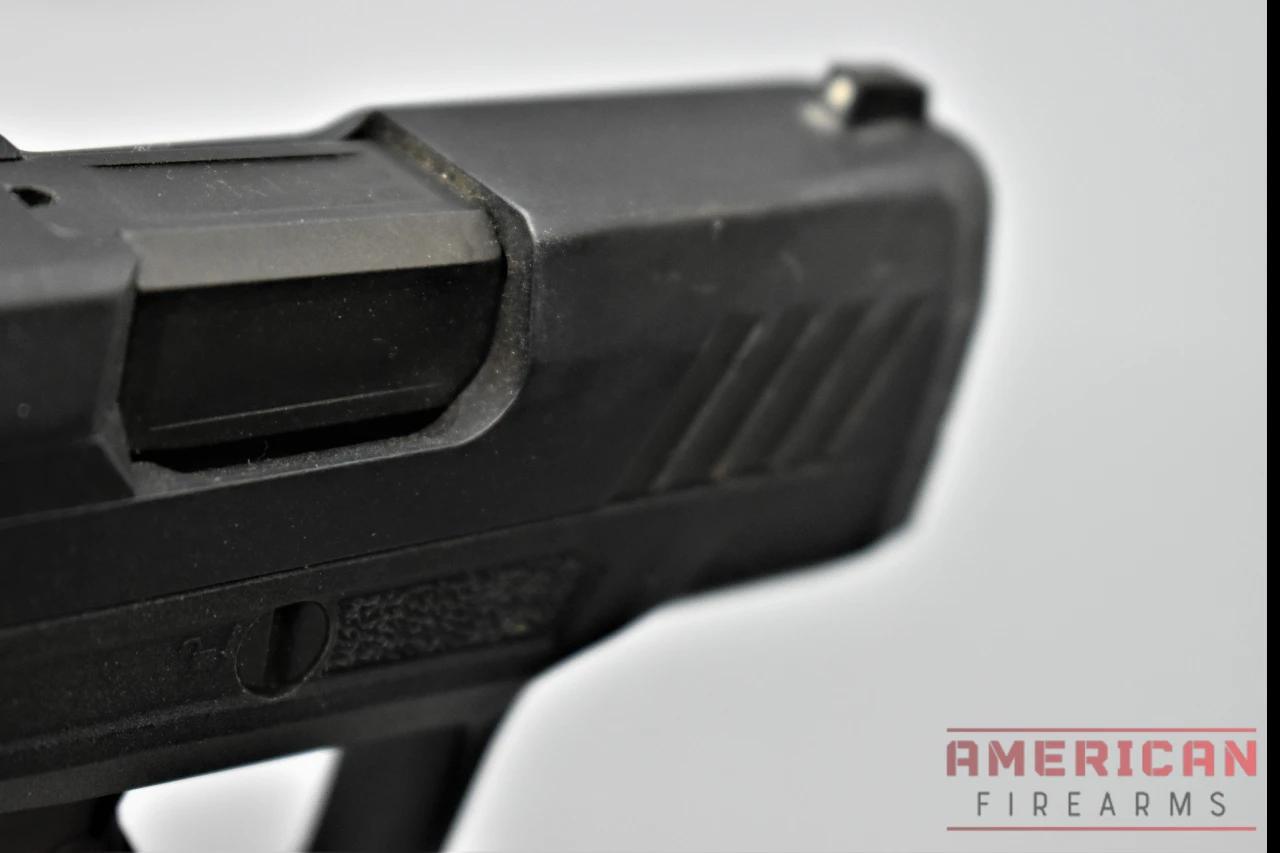
Trigger
The GX4 is equipped with a flat-faced, serrated single-action only trigger that feels noticeably better than previous Taurus models. It features a short take-up and a defined wall, breaking at approximately 5.5 pounds. These characteristics are impressive for a factory-standard pack in a striker-fired pistol.
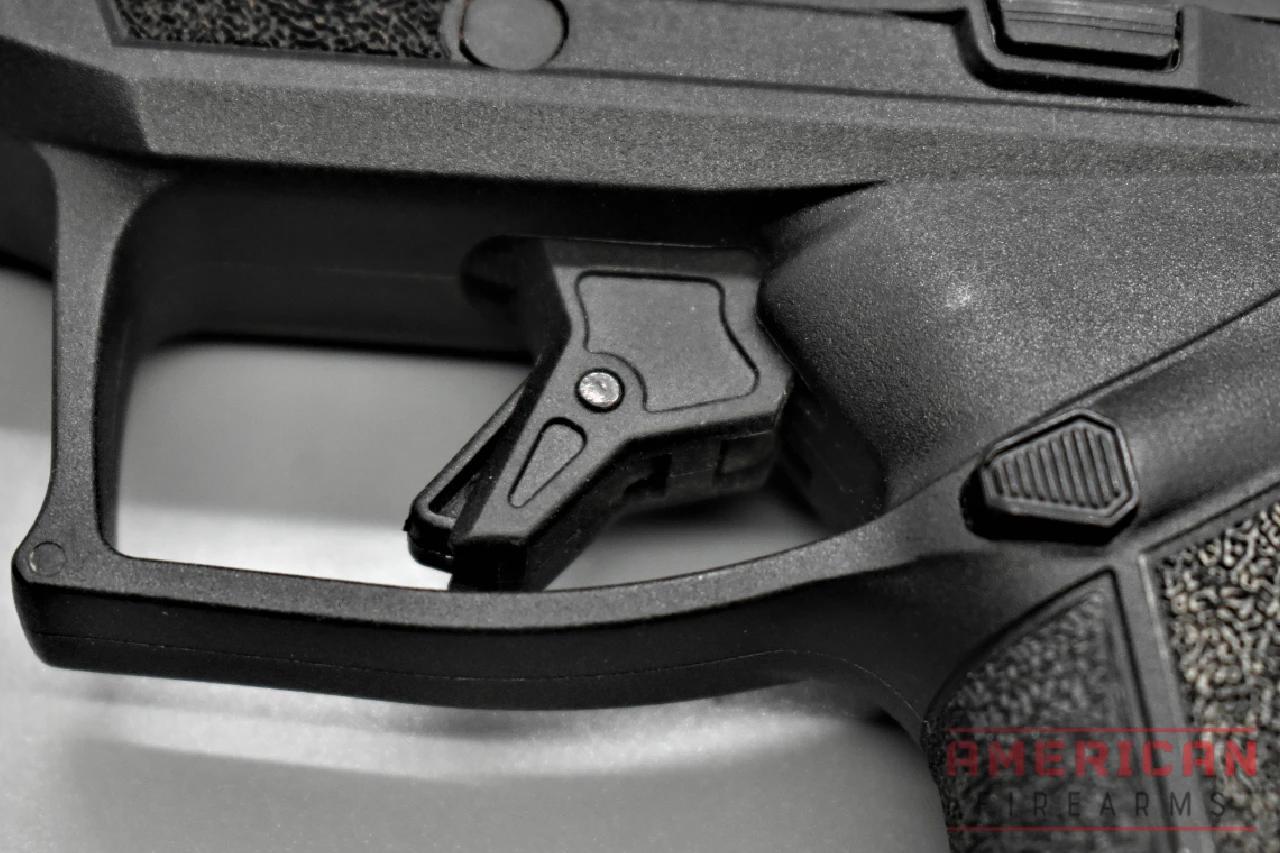
Accuracy
During practical shooting at self-defense distances up to 25 yards, I found the Taurus GX4 to be quite capable on the range. As a small pistol with a 3-inch barrel, it doesn’t offer a lot of sight radius, but it was easy to keep on target without experiencing flyaways.
Aftermarket Support
While holsters for the GX4 seem to be widely available from several makers, there is little support for the gun outside of Taurus’s webstores. However, since the sights are Glock-pattern, you’ll likely find a ton of replacement options available.
You’ll need a screwdriver for the takedown pin, but we loved the GX4 in our long-term review.
How did 9mm get so popular?
Introduced by Georg Luger around 1900 for use in the toggle-action semi-automatic military pistol that carries his name, the 9mm Parabellum– also seen as 9×19, 9mm Luger, and 9mm Para– became popular initially in Central Europe.

Then, by the early 1940s when handguns like the Astra 600, Browning Hi-Power, Poland’s Radom VIS, and the Finnish/Swedish Lahti were in circulation, it started to become a more worldwide cartridge.
Shortly after World War II, it was the staple cartridge in use with Western military combat as well as law enforcement duty pistols, spreading to America by 1954 with the Smith & Wesson Model 39.
Within a few decades, the light-recoiling 9mm, which still provided effective ballistic performance with appropriate bullets, had largely replaced both lighter rounds such as the .380 and .32 ACP, as well as toppling the vaunted .45ACP in popularity.
In 2017, the FBI tapped it as its standard duty caliber for handguns, a move that cut the legs out from under the .40S&W which had long been billed as splitting the middle ground between 9mm and .45ACP.
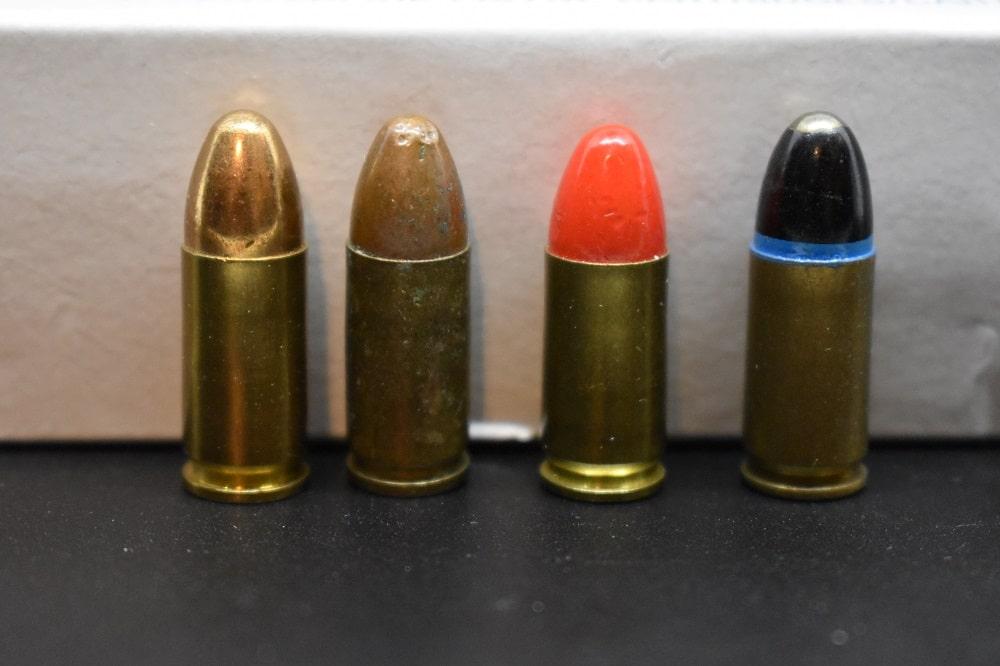
In short, today’s 9mm now stands atop the mountain when it comes to modern pistol calibers as it is controllable for both novice and experienced shooters, is typically available in a diverse range of loadings — from target to defensive ammunition to hunting uses — and its short overall length allows it to performs as advertised in a full-sized or compact pistol.
Why the 9mm?
First and foremost, the 9mm is a widely available cartridge. While availability might fluctuate due to political situations in the U.S., it remains one of the most accessible cartridges.
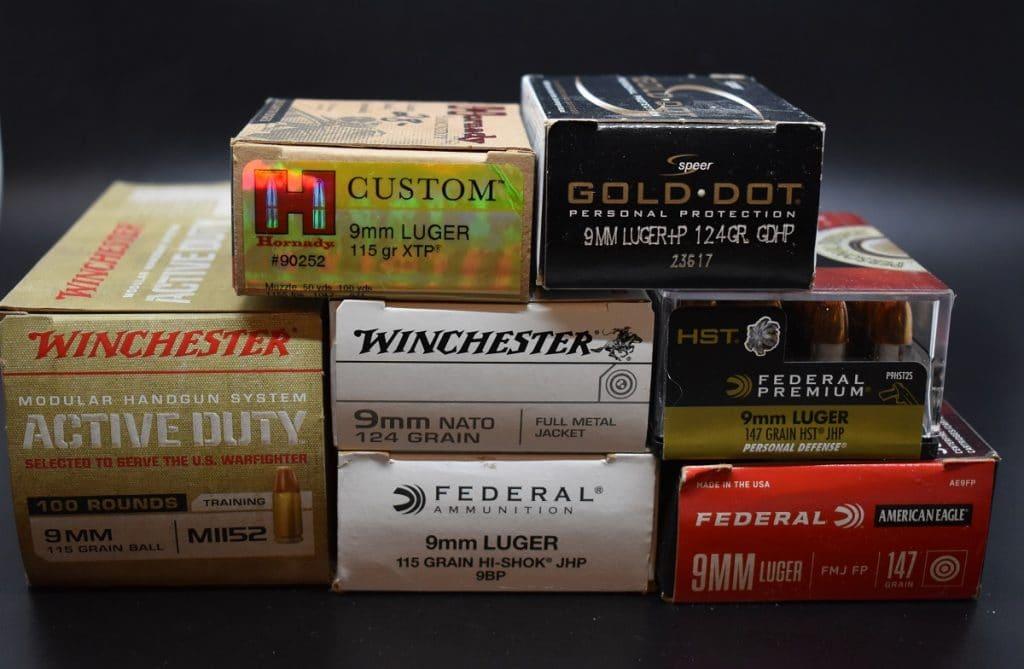
You can likely get up from your desk and find 9mm for sale on a shelf within a 20-minute drive of your current location.
Since it is so easy to get when compared with, for example, .32 ACP, it stands to reason that people will keep using firearms in ammunition types that they can get access to quickly.
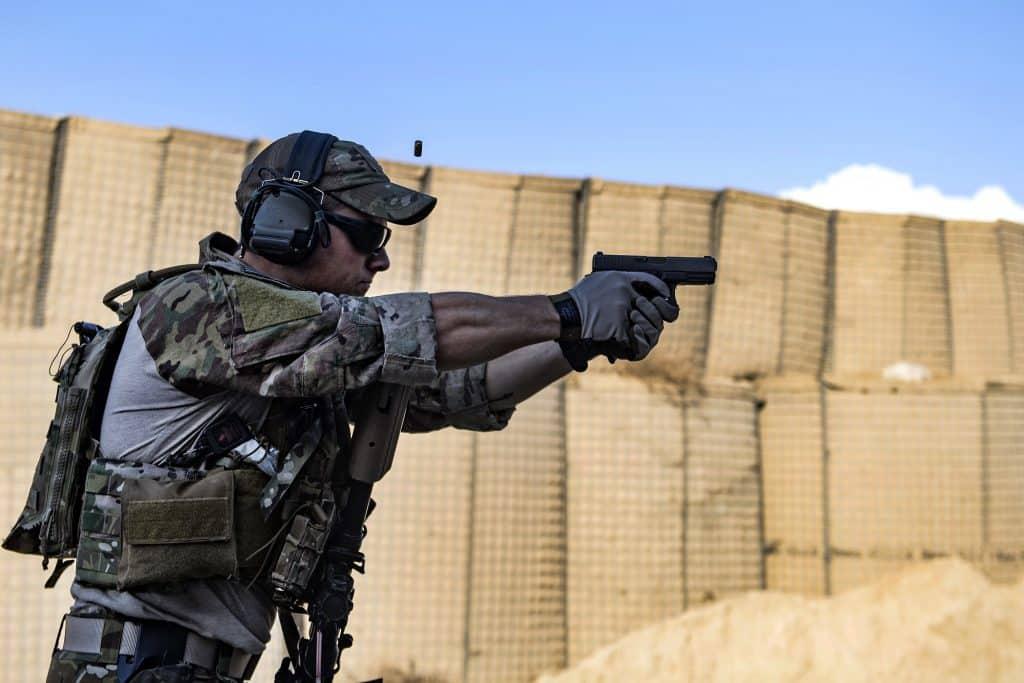
Secondly, 9mm is relatively affordable. Again, this will change with the times and ammunition has been creeping up in cost overall through the past several decades.
Companies have been producing 9mm for a century, and they compete with one another. Thus, it is still feasible for most people who want to get into the hobby of shooting to pick up a 9mm handgun and some ammunition for a cost that is at least somewhat palatable.
Ideally, prices will come down in the future, but 9mm is still one of the more budget-friendly rounds.
These days, the most reliably handguns that you are likely to find are in 9mm.
Take Glocks, for example. With millions of units sold, military contracts, police use, and so on, the company has a lot of incentive to make their guns run well and a lot of user data to back up their research.
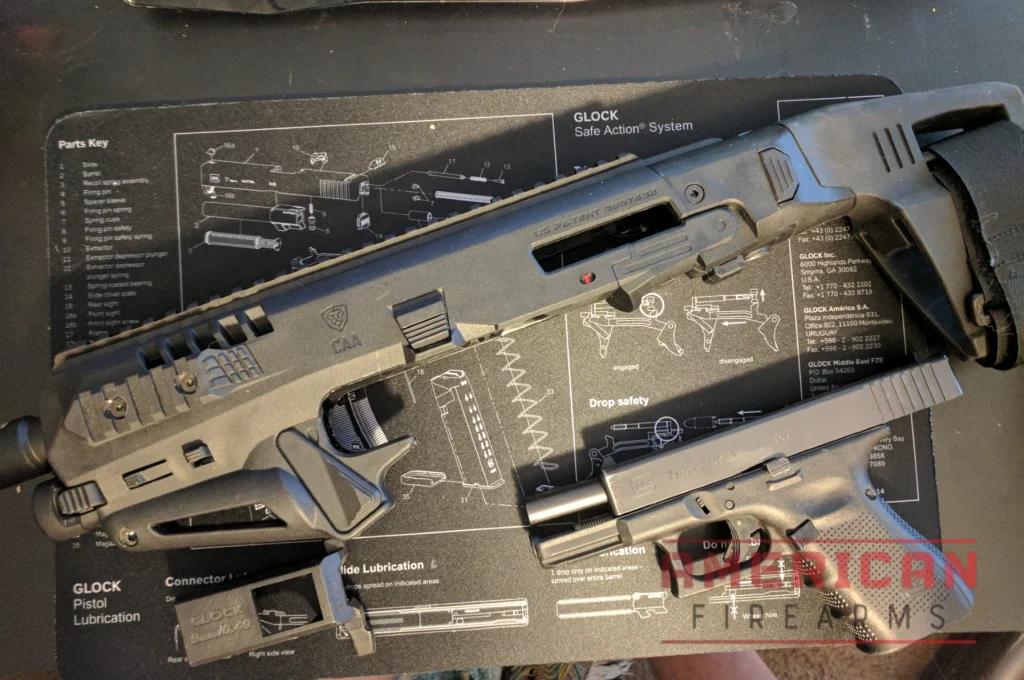
That’s why so many 9mm platforms have been iterated over several generations, and they tend to get more reliable over time. For us, that means guns that tend to go bang when you want them to and not to go bang when you drop them by accident.
Firearms in 9mm also tend to have more modern designs that allow for a lot of customization from the perspective of a relative handy user.
Today, it’s not awfully difficult to take a stock handgun from several manufacturers and make it exactly how you want it in terms of lights, magazine size, slide length, optics, and so forth.
The ability to tailor a firearm to a specific user, in our view, is a great thing that will keep people shooting firearms in that caliber. Older designs are a lot harder to work on, and so new 9mms are likely to stay popular for the time being.
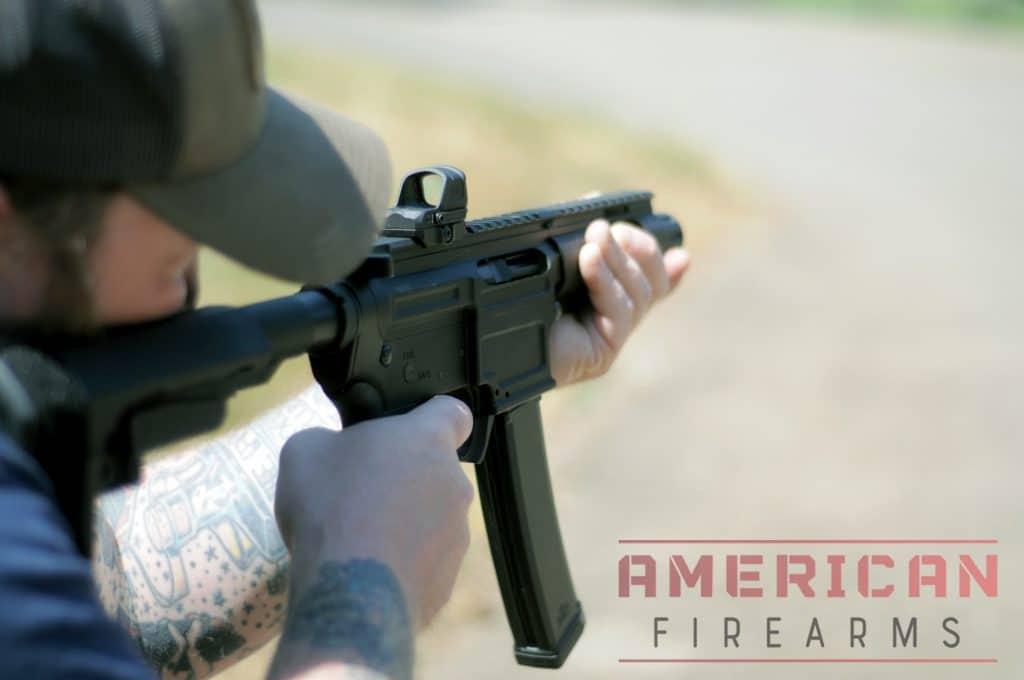
Finally, the 9mm has proven itself to be exceptionally adaptable in terms of its usage. You can fire them out of rifles, submachine guns, and several flavors of pistols. No matter what, they seem to work well, maintain decent accuracy, and can be loaded for everything from long-range to use with a suppressor.
This adaptability in terms of usage, format, and bullet type gives us, as shooters, many reasons to stick with the caliber, even if it would be possible to make others good at one or two things.
Safety Considerations
When it comes to firearms, safety isn’t just important—it’s non-negotiable. Whether you’re carrying concealed, keeping a pistol staged for home defense, or burning through a few boxes of ammo on the range, the fundamentals remain the same.
For those carrying daily, choosing a pistol with solid safety features is critical. Striker-fired platforms like the Sig Sauer P320 come with multiple layers of protection baked in, including trigger safeties designed to prevent unintentional discharges. The trigger guard on models such as the Glock 19 adds another layer of security, ensuring the trigger stays put until you need it. These aren’t gimmicks—they’re proven features that work.
That said, no amount of built-in safety can replace responsible gun handling. Keep your pistol pointed in a safe direction at all times. Your finger stays off the trigger until you’re ready to shoot—no exceptions. For home defense, storing your firearm in a secure location is a must. A locked safe or quick-access lockbox keeps unauthorized hands away while ensuring the gun is ready when needed.
If you’re carrying concealed, a quality holster is just as important as the pistol itself. A good holster keeps your striker-fired pistol secure and accessible, while fully covering the trigger guard to eliminate the risk of an accidental discharge during your daily routine. Whether you’re running a Sig, a Glock, or another trusted platform, prioritizing safety features and practicing sound fundamentals ensures your gun is always ready—and always safe.
Maintenance and Upkeep
Keeping your pistol running right is critical, especially when you’re depending on it for concealed carry or self-defense.
Striker-fired pistols are tough—built to take a beating—but regular maintenance is what keeps them reliable when it counts. A good rule of thumb: clean and lubricate your gun every 500 to 1,000 rounds, or after any extended range session. Focus on the slide, barrel, and internal components. These areas see the most action and can affect performance if you let them go.
Don’t skip the details. Inspect your trigger guard and magazine release for wear, and replace any parts that show signs of excessive use. A pistol is only as dependable as its weakest component, so staying ahead of maintenance prevents problems before they start. A quality maintenance kit—complete with cleaning rod, brushes, and lubricant—makes routine upkeep straightforward and fast.
Regular range time does more than keep your skills sharp. It helps you spot potential issues before they become failures. By making maintenance a habit, you ensure your striker-fired pistol remains a dependable tool for concealed carry, home defense, and range use—ready to perform whenever you need it.
Wrap Up
The 9mm handguns of today represent the cutting edge of firearms development, with over a century of lessons learned guiding that evolutionary process to its current pinnacle.
With so many designs offered, there is something to fit every need and personal preference for those looking for a quality pistol that can last a lifetime. Do your research and choose wisely, and the odds of being disappointed are slim.
Further Reading
- Shooting Industry, Firearms Sales Report
- Smith & Wesson, Shield EZ Recall
- YouTube, Sig Issues
- ATF, Firearms Commerce Report
Updated
October 5, 2025 — We added the Ruger RXM to our list and clarified the purpose of each pistol to help you find the right pistol for your purpose.
Sign up for our newsletter
Get discounts from top brands and our latest reviews!




